We have decided to visit Milan for the New Year’s Eve 2021/2022 as a part of our tradition to do European city breaks during winter months. Cliché as it may sound, the city enchanted as with its style, fashion, culture and superb Italian cuisine. What I like about Italy, is that it never disappoints and all the great things we read about the Italian cities and regions before our arrival appear to be even better in reality.
December/January is a good time to visit Milan since it’s not as hot as in the summer days, also there is significantly less tourists even if the destination gets popular around New Year’s Eve. But apart from this hot period, you generally avoid crowds, don’t spend much time queuing to museums and in December/early January still can enjoy Christmas markets and festive decorations which transforms major European cities into a fairy land.
We have spent in Milan full 4 days which gives enough of time to see its famous landmarks, wonder around chic and stylish Milanese streets and have a one day trip to Lake Como.
In this post I will describe a 4 day itinerary around Milan, but you can easily adjust it to 3 day stay by skipping trip to Lake Como. If you are not a big fan of museums, then 2 days should be enough, however Milan boasts a fair number of world class art galleries and architecture landmarks and I find it would a pity to skip the cultural attractions the city offers.
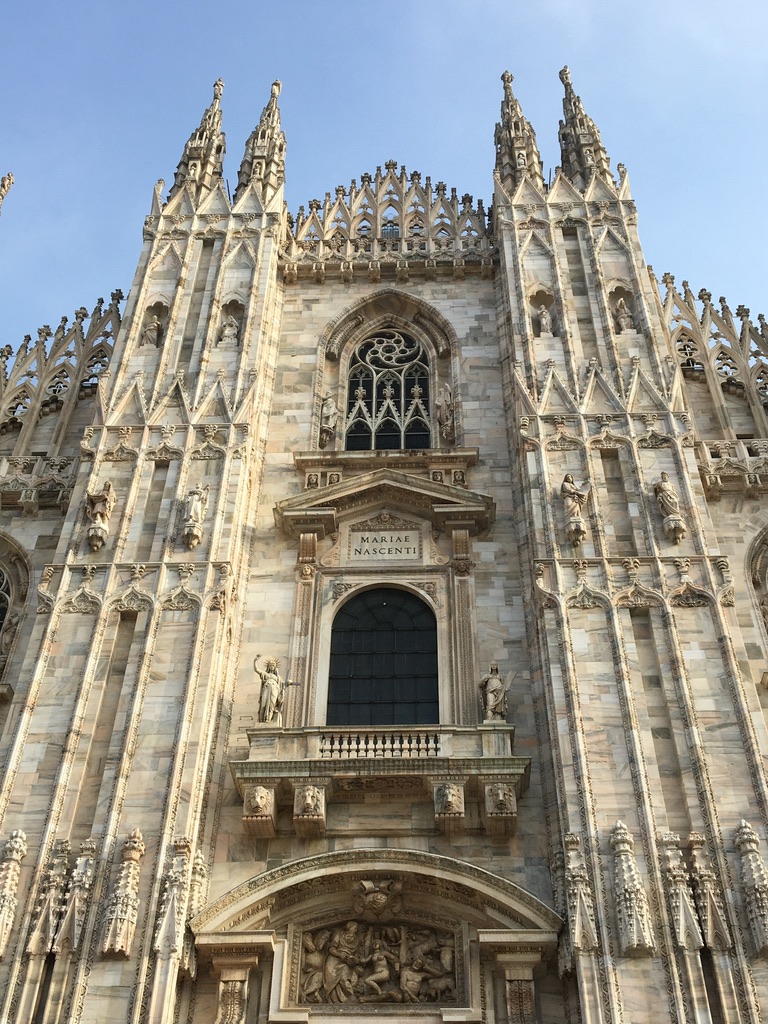 |
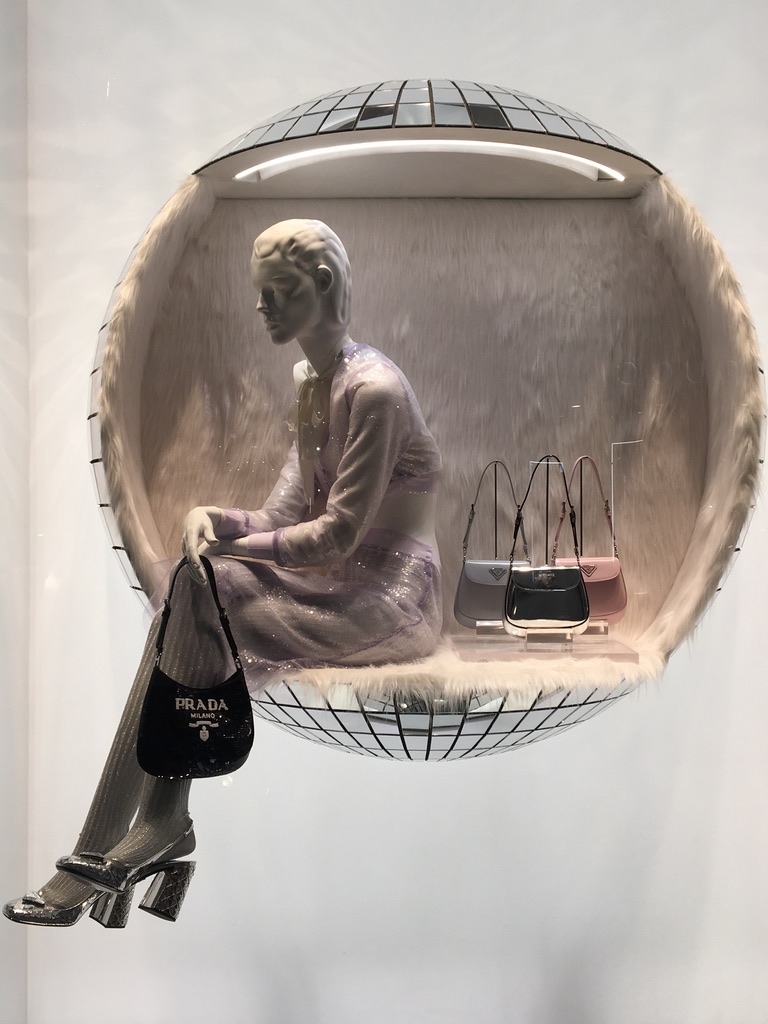 |
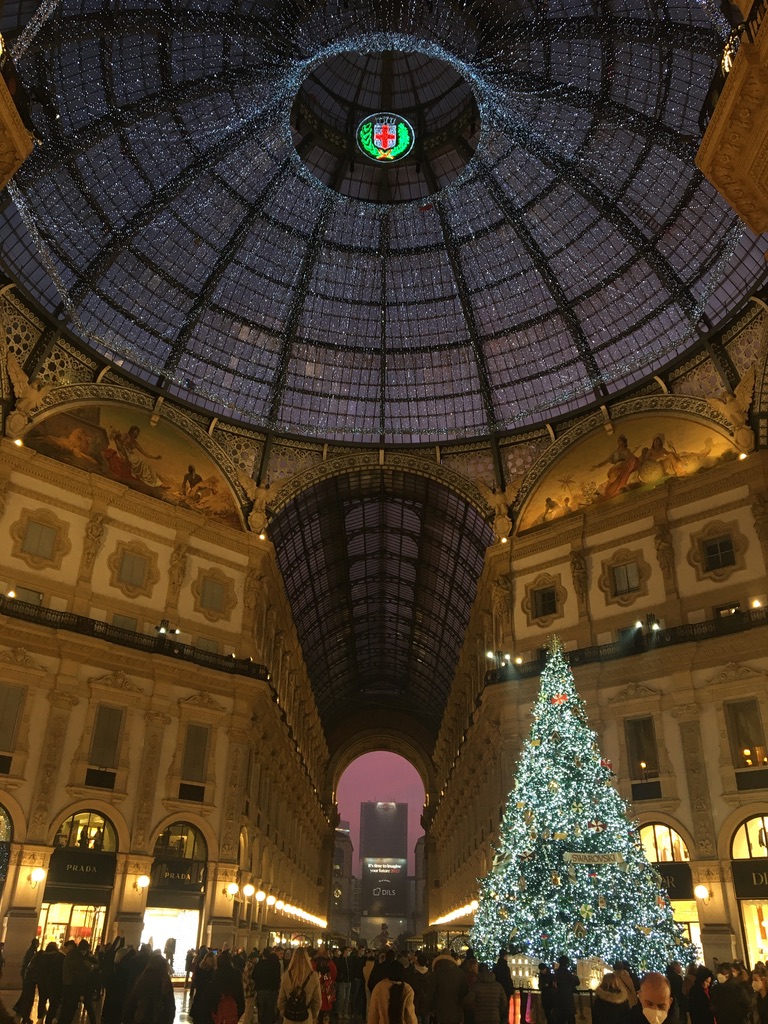 |
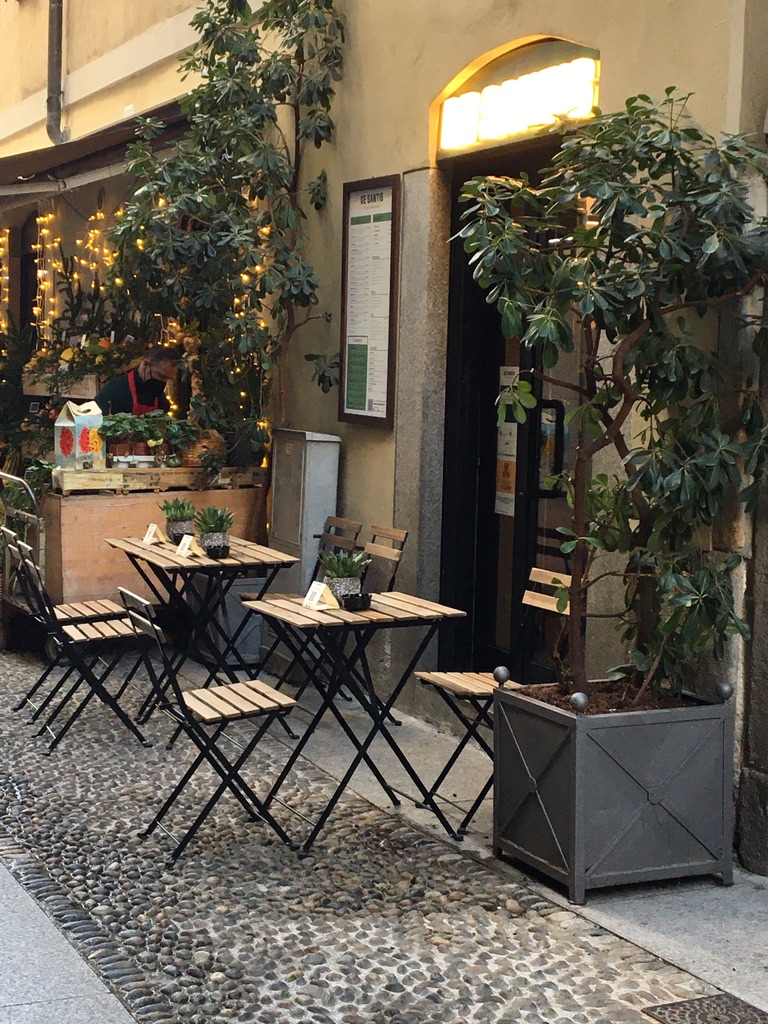 |
Culture geek or not, Milan is refreshing with its inspiring fashion, delicious Italian dishes and vibrant neighbourhoods. Order your cup of espresso and observe the stylish locals–or like me–admire their fashionable dogs, obviously Milanese are crazy about the dog fashion.
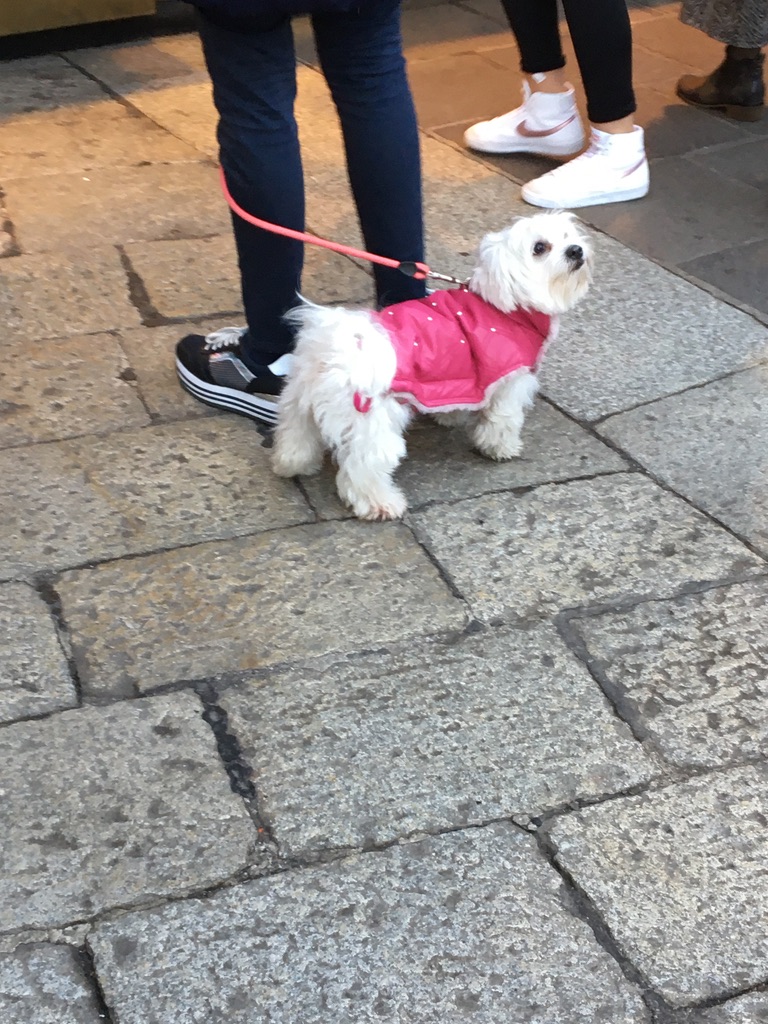 |
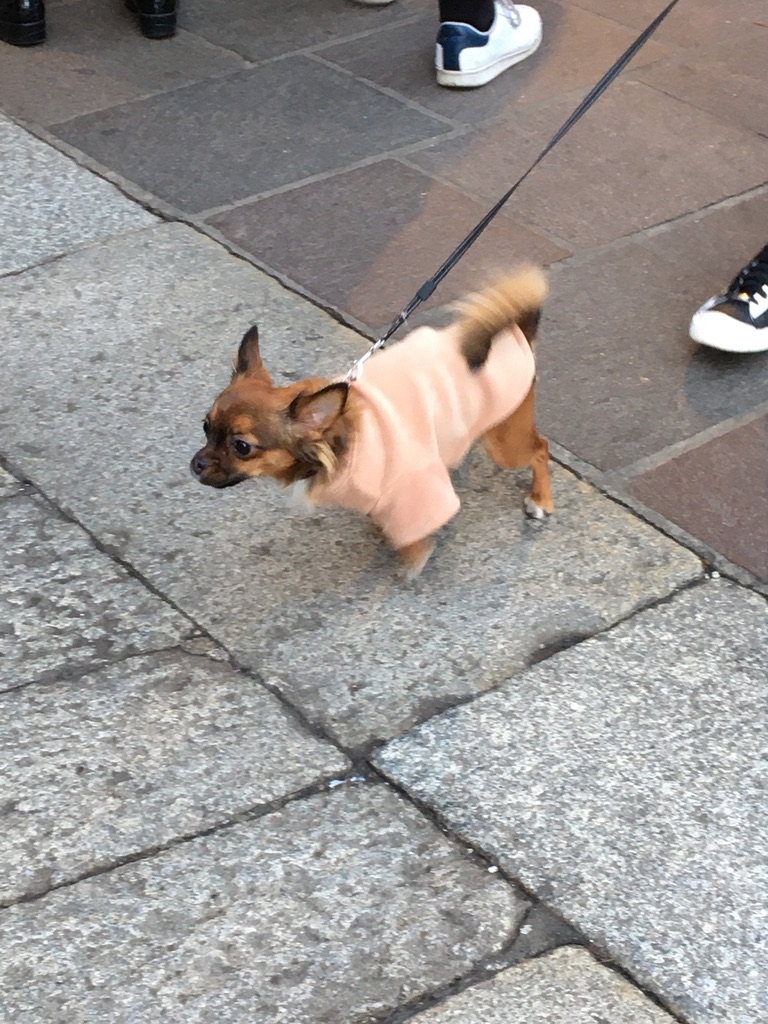 |
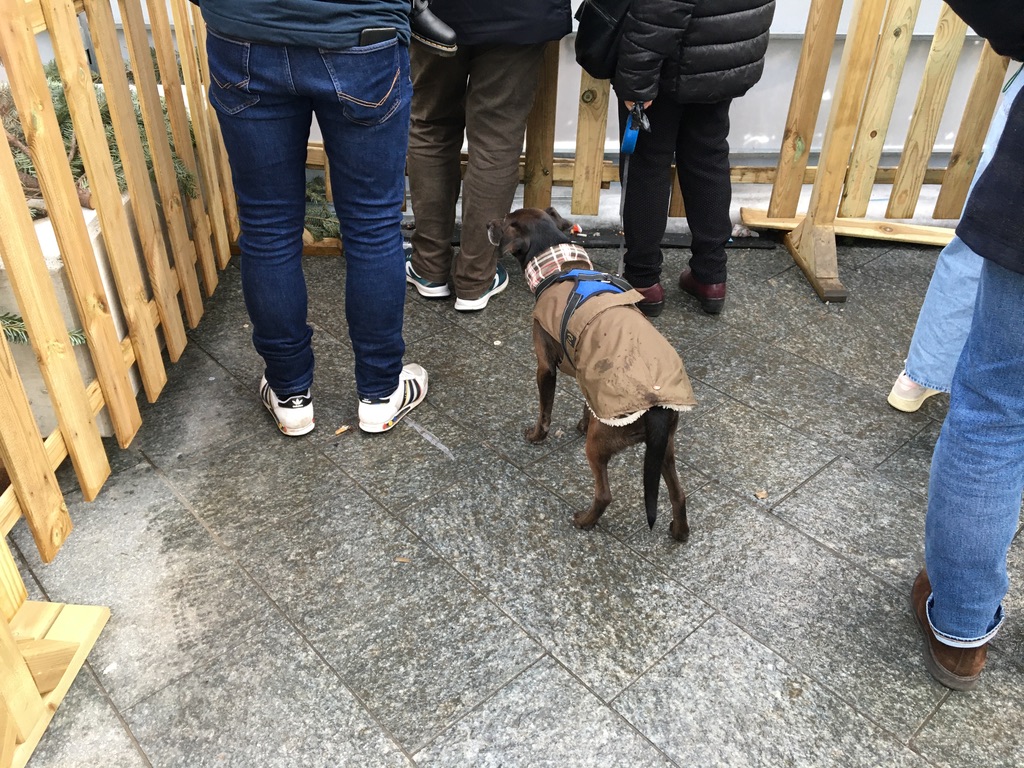 |
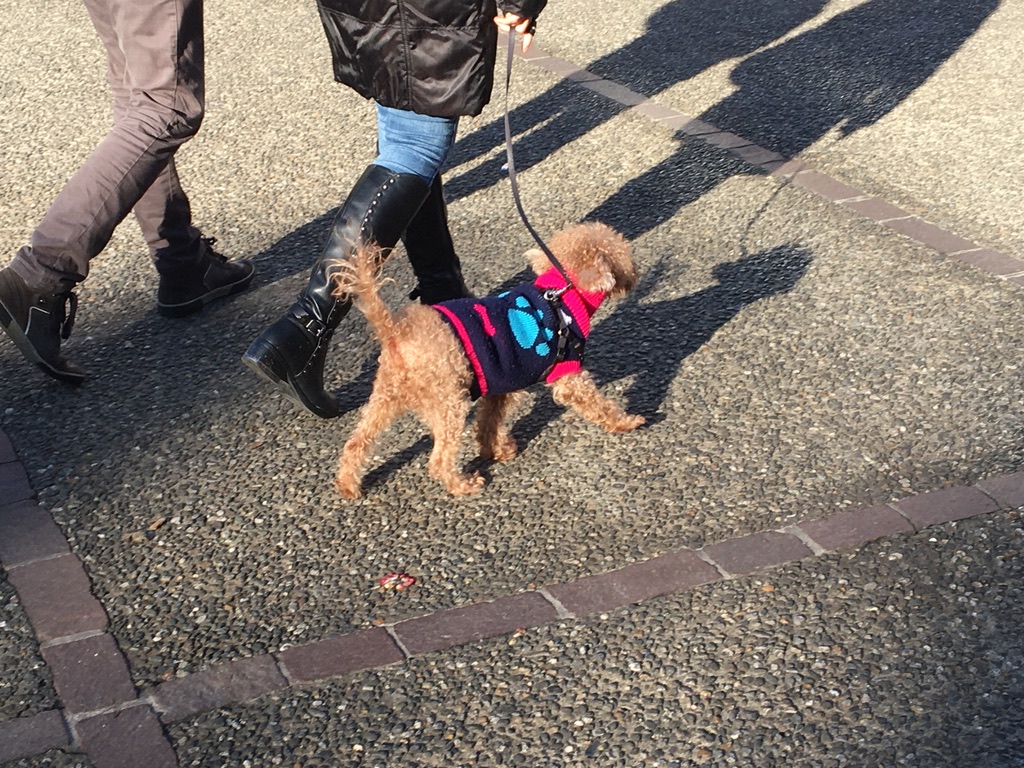 |
Day 1
- Duomo
Probably the most famous landmark in Milan is the cathedral Duomo. I would start my visit with this stunning building and give it few hours to explore. Apart of visiting the cathedral itself, you can climb stairs (or take the elevator) to its rooftops and admire firstly the elaborate decorations of the church’s exterior and secondly the views at Milan (unless it’s foggy like during our visit, haha). In the extended ticket fare, you also can visit the Archeological site and Duomo Museum (located in Palazzo Reale). As you see, there’s quite much to discover about Duomo so make sure you will allocate enough of time to really enjoy the cathedral.
Dumo cathedral took almost six centuries to complete: construction started in 1386, and the final details were completed in 1965. It is the biggest church in Italy—the larger St. Peter’s Basilica is located in Vatican City (which is a sovereign state)—and second largest in Europe and third in the world.
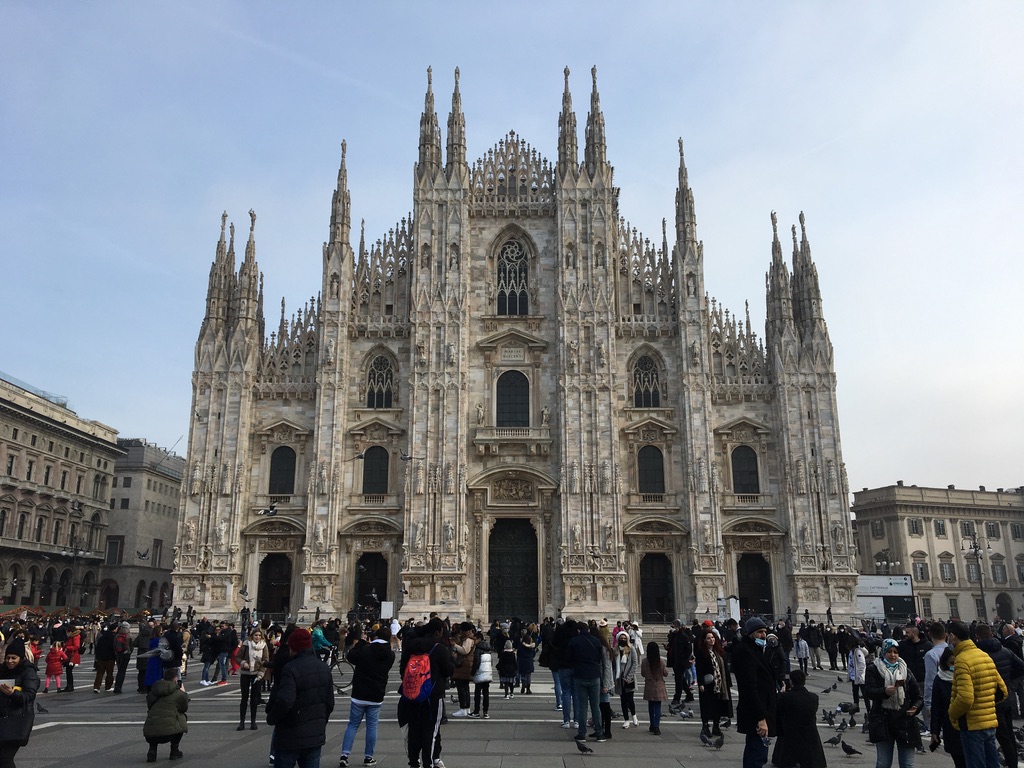 |
A bit of numbers
The Duomo grandeur can be expressed in numbers, the building boasts 3400 statues, 200 bas-reliefs, over 3600 personnages in the 55 stained-glass windows in total stained glass area of 4250 m2. Duomo has 135 spires, 150 gargoyles, 158m external length, 93 m external width of the Cross-aisle, 11 700 m2 internal surface area, 96 giants and 108,5m height from the ground.
Cool, isn’t it?
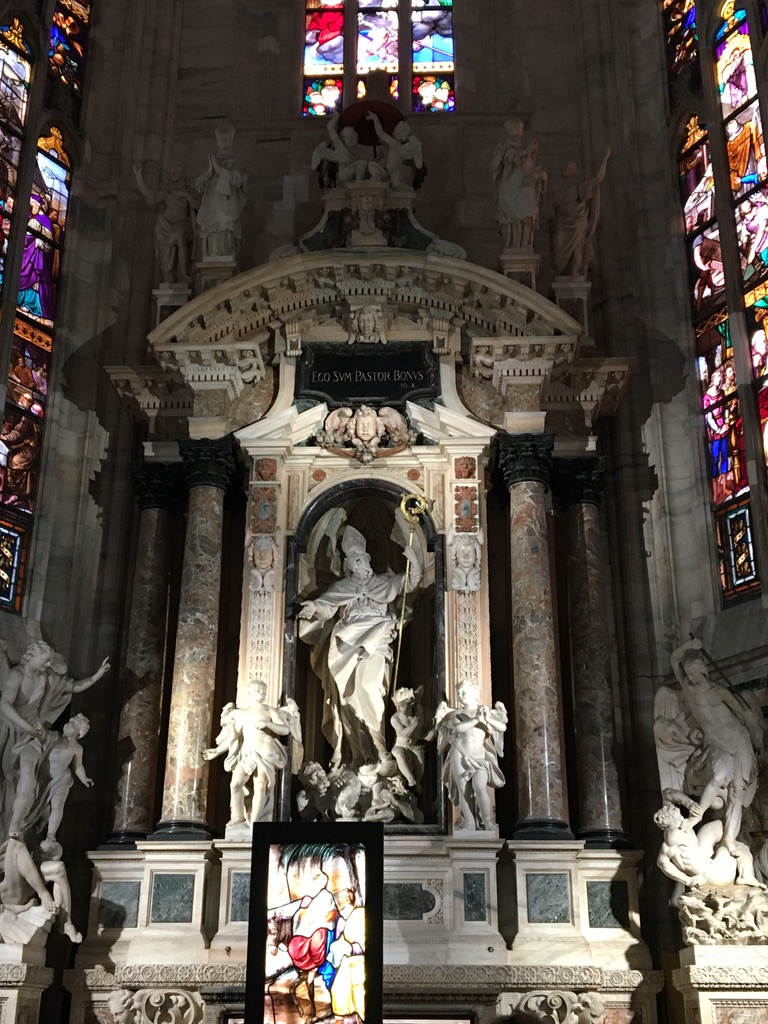 |
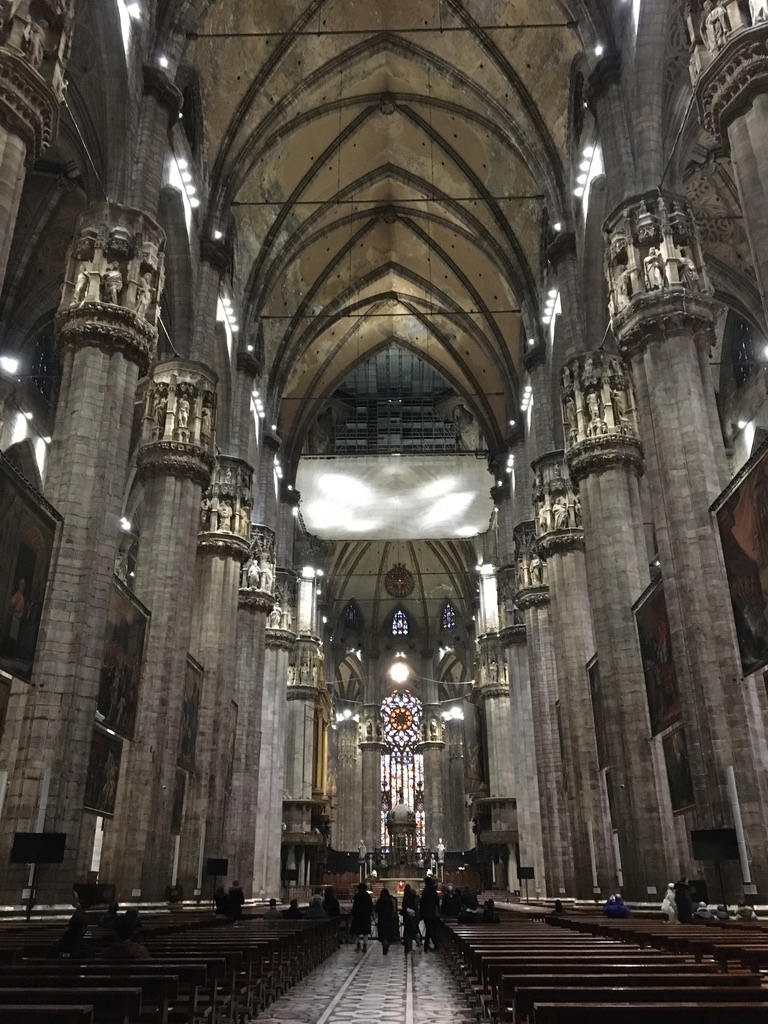 |
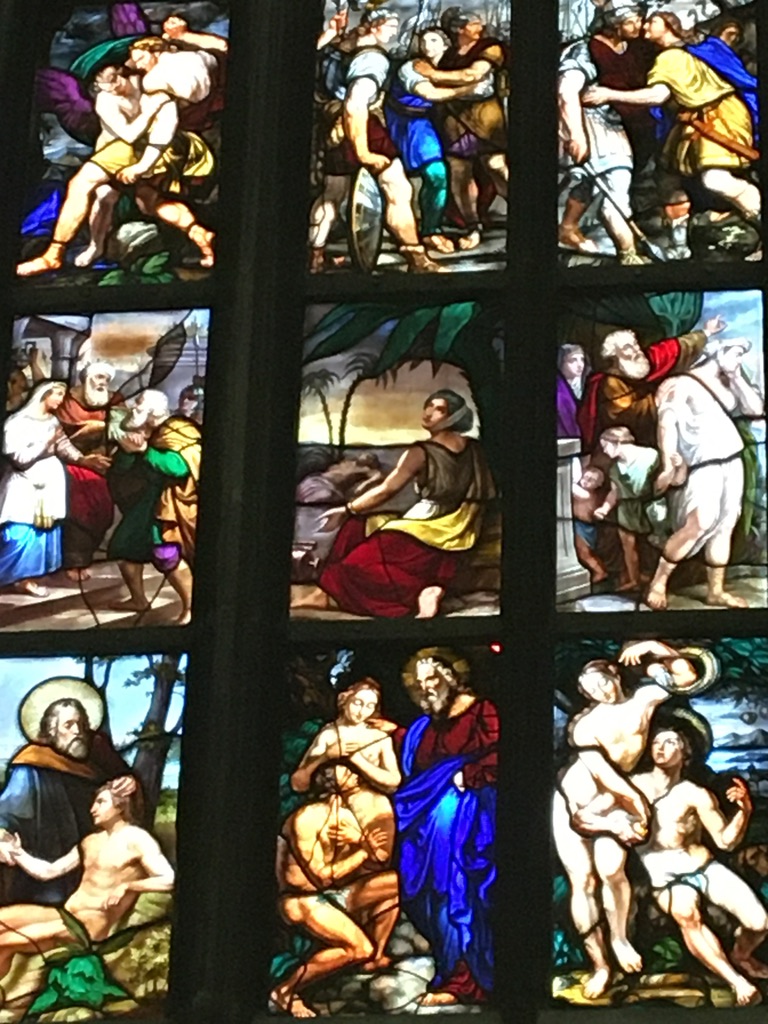 |
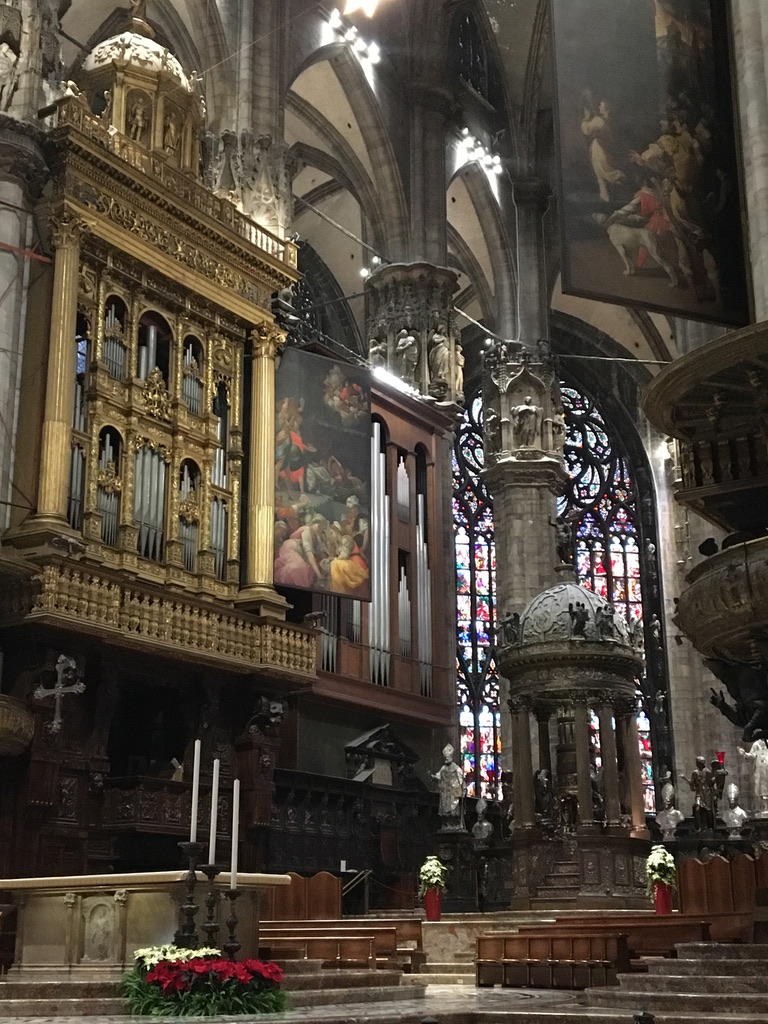 |
When you’re done with cathedral stunning interiors, you can take a look to the archeological crypt which can be accessed from the cathedral. This archeological complex is the result of excavations performed in 20th century which resulted in unveiling the structures of the Ambrosian baptistry and the remains of The Santa Tecla Cathedral. In the centre of this site you will find the remains of a large octagonal baptismal font, where, according to a legend, Saint Ambroise baptised Saint Augustin in 387.
Next, it’s time to get up to Duomo’s impressive rooftop from where you can admire a spectacular view of Milan and even of the Alps (on a clear day which was not the case during our visit). You can take the lift or climb to the top of the Duomo via a spiral stone staircase of 919 steps, the second way gives much more satisfaction at the end.
Attention: During summer months when the temperatures are high, getting up by stairs can be too exhausting. Make sure you have a bottle of water with you and adjust your pace accordingly, or take an elevator if you don’t feel well in severe heat.
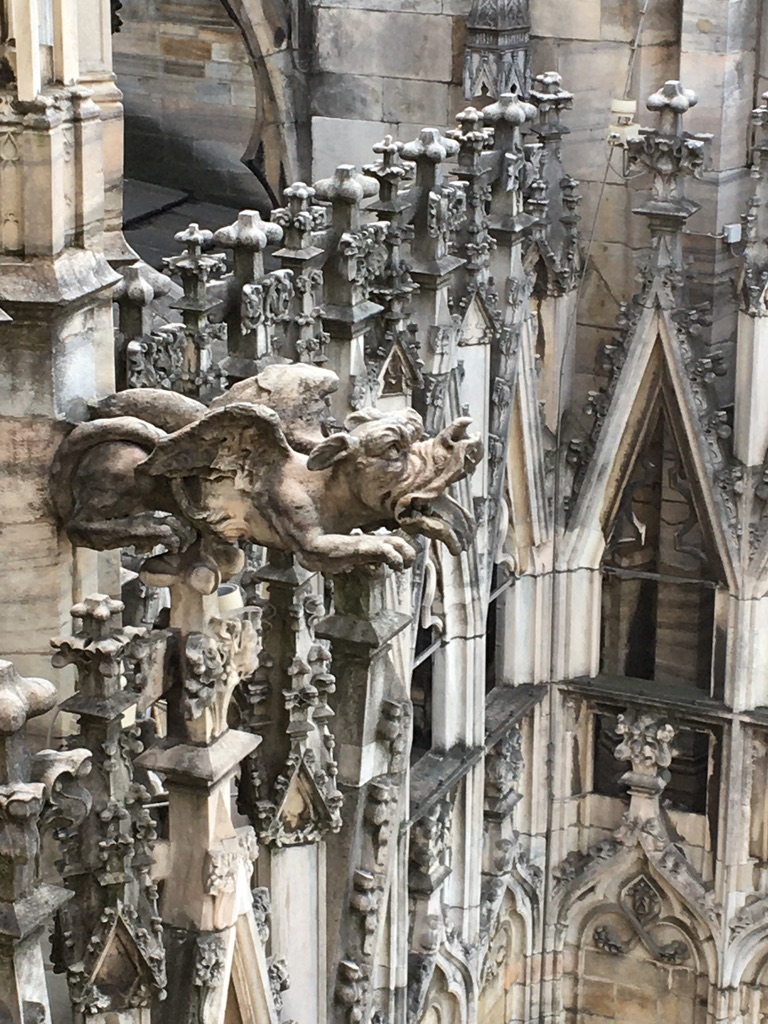 |
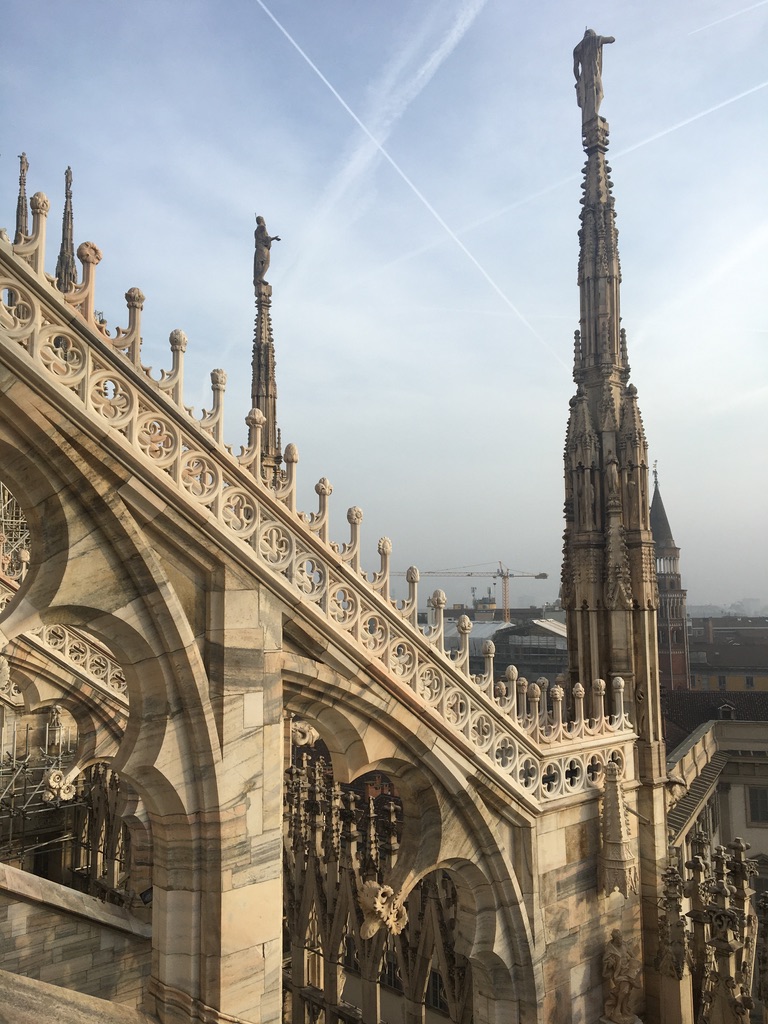 |
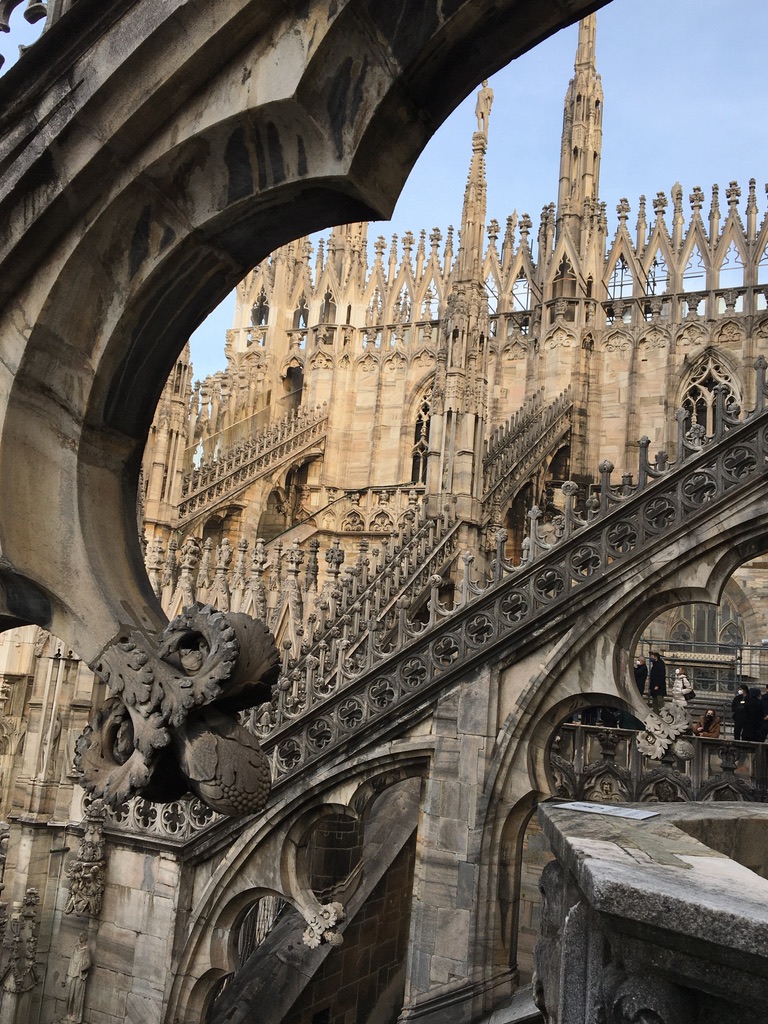 |
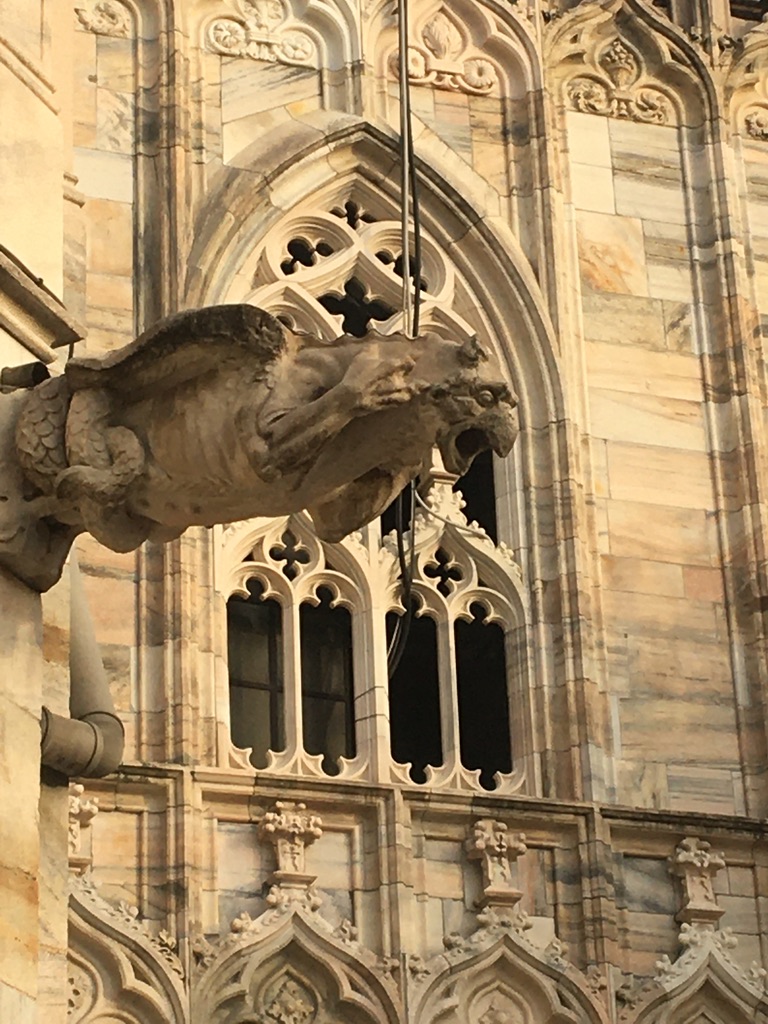 |
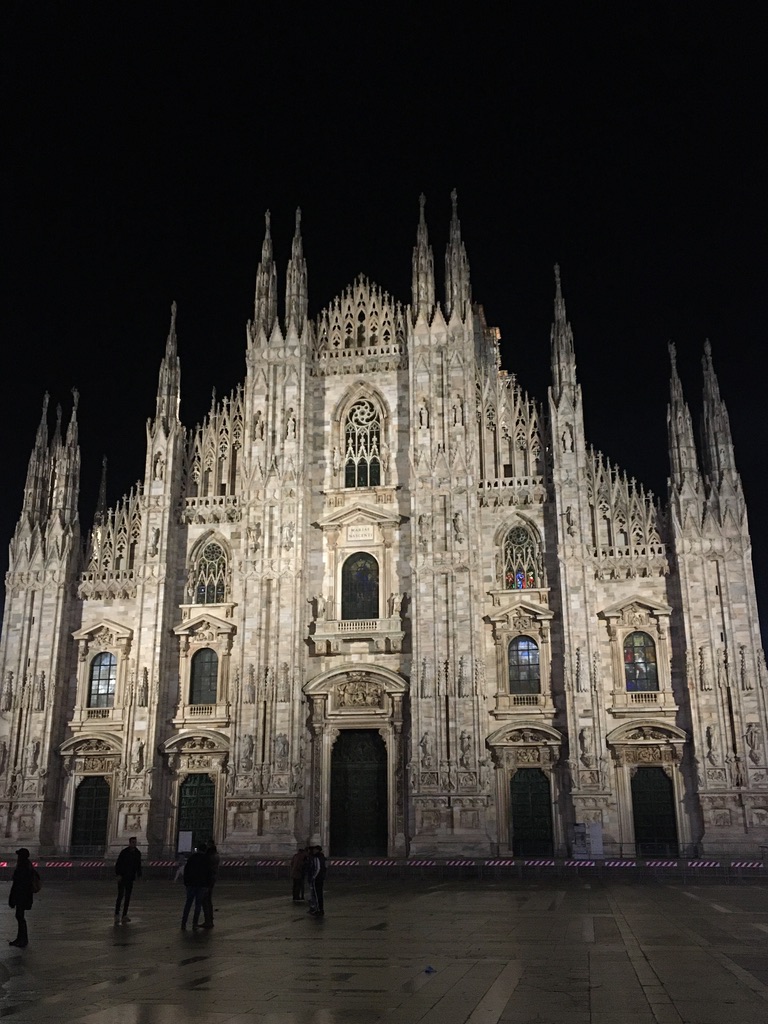 |
Lastly, we have visited Duomo Museum situated in the Royal Palace, you can also opt to visit it before entering the cathedral itself and treat the museum as a sort of introduction to Duomo’s heritage. You will find there sculptures which once were a part of Duomo cathedral and now can be admired from close up, you may also look closely at the details of unique works of art which had been placed on the monument, stained-glass windows, various paintings, tapestries and terracottas– all of them are original elements taken from the cathedral.
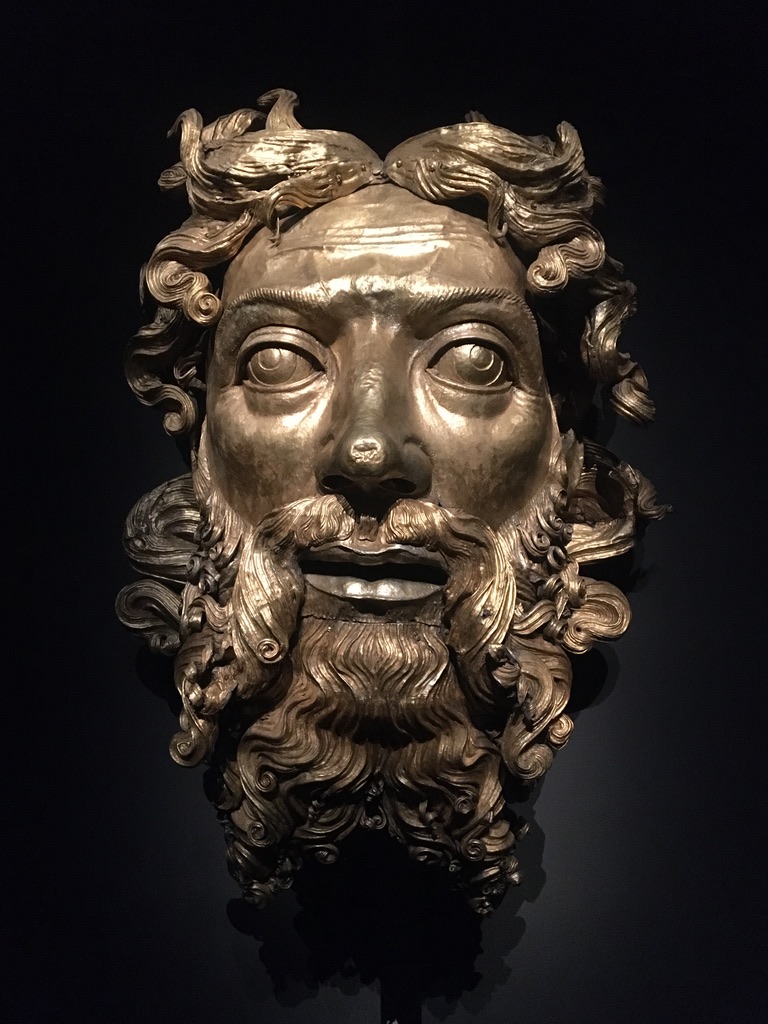 |
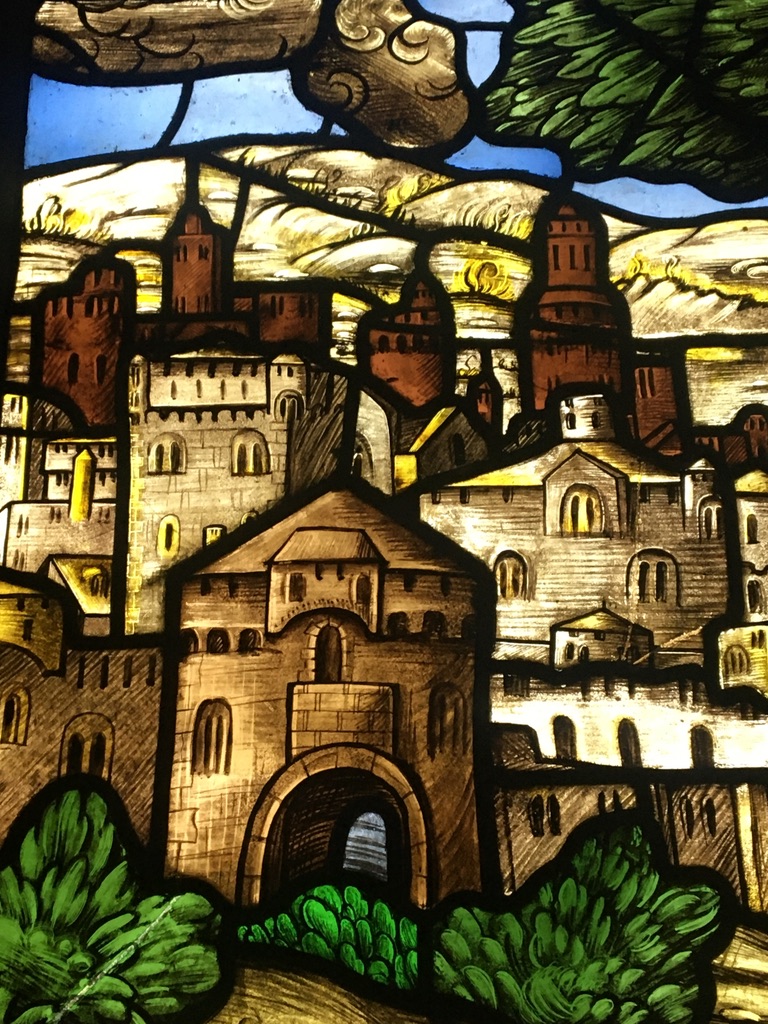 |
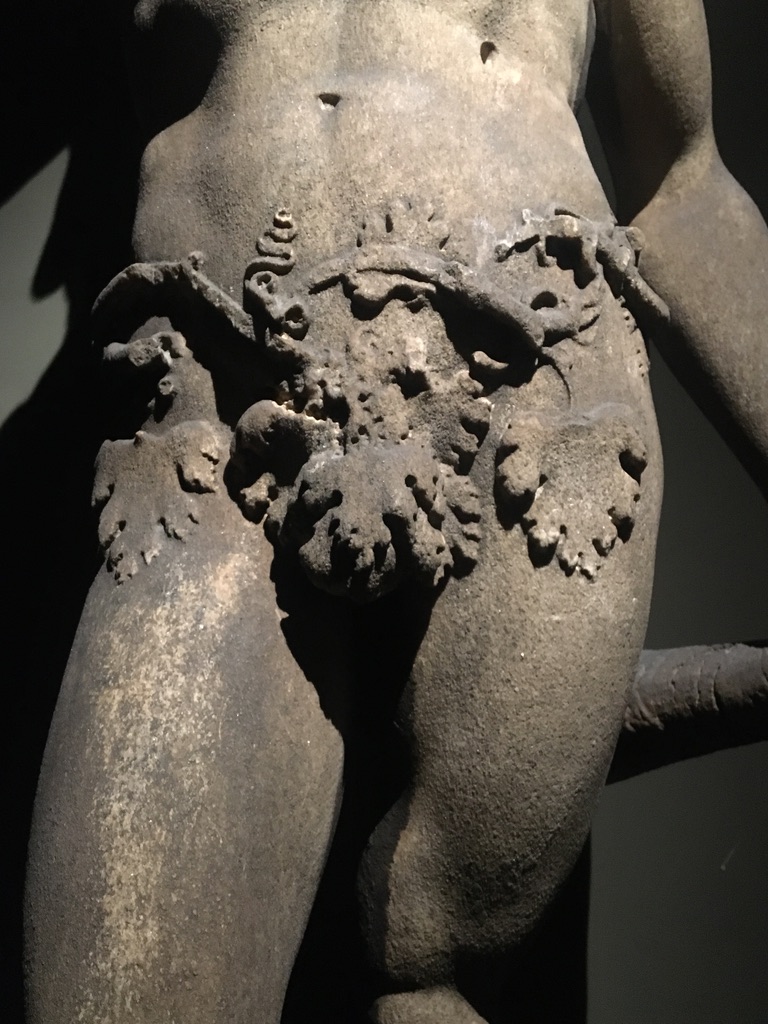 |
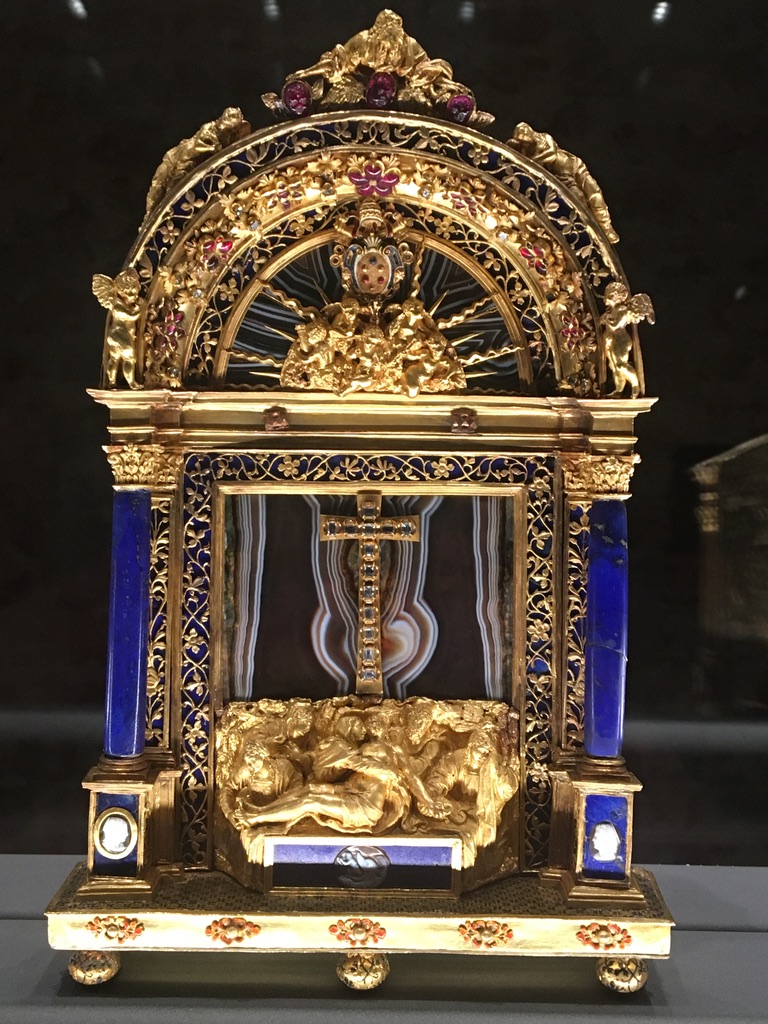 |
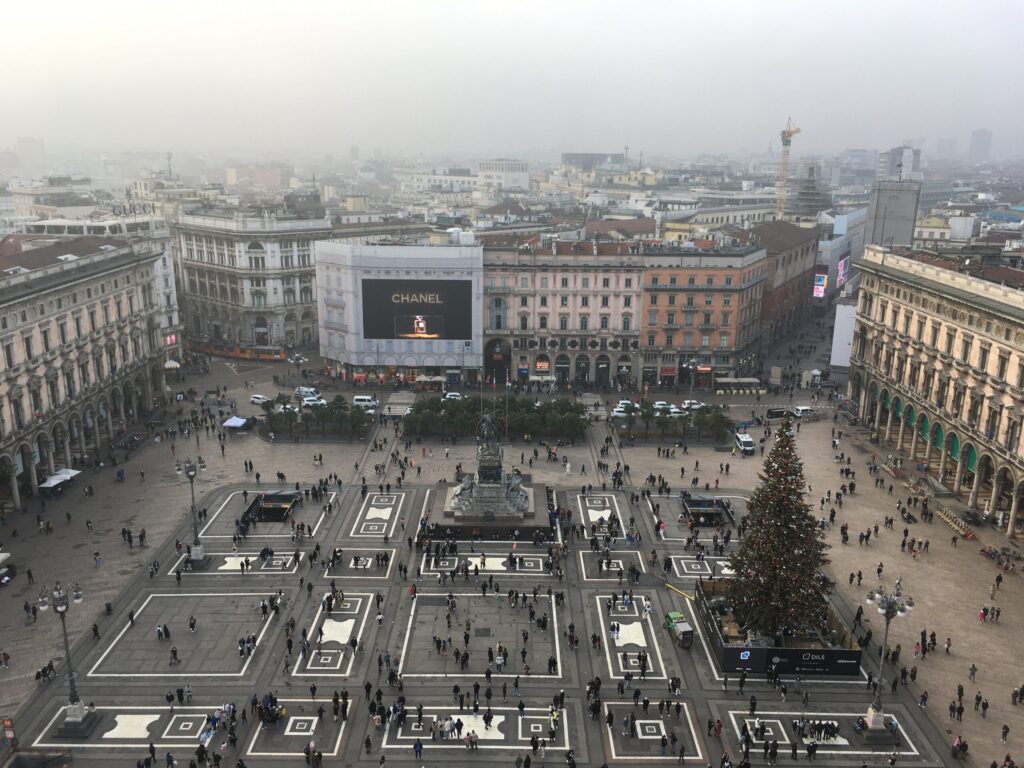 |
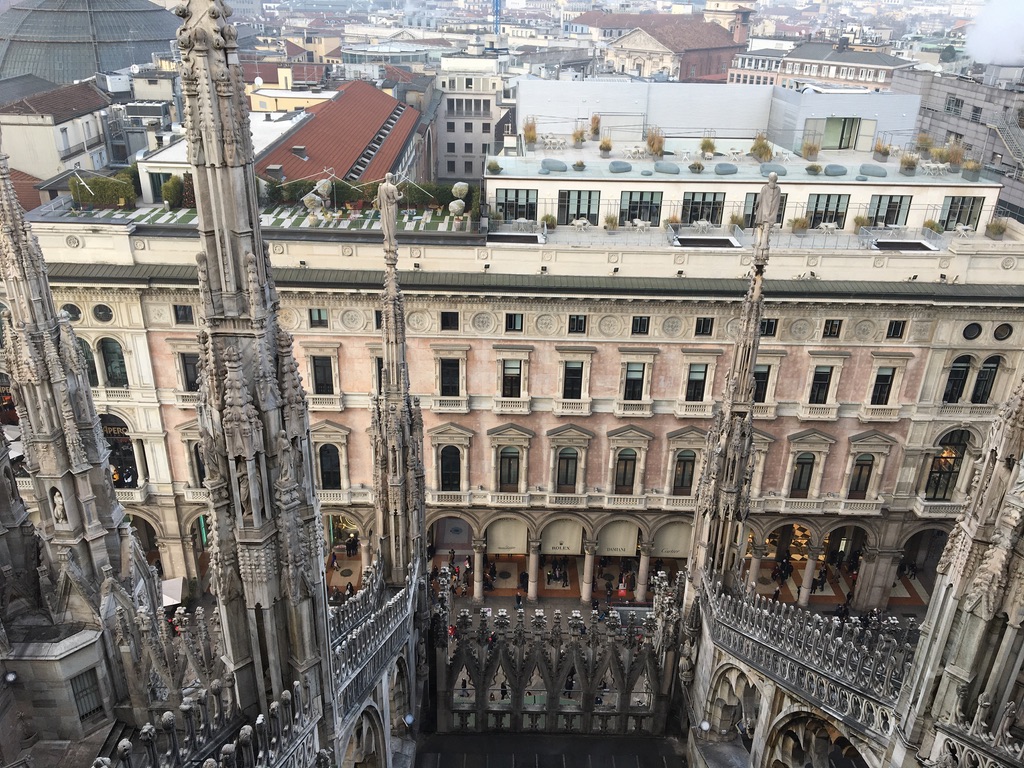 |
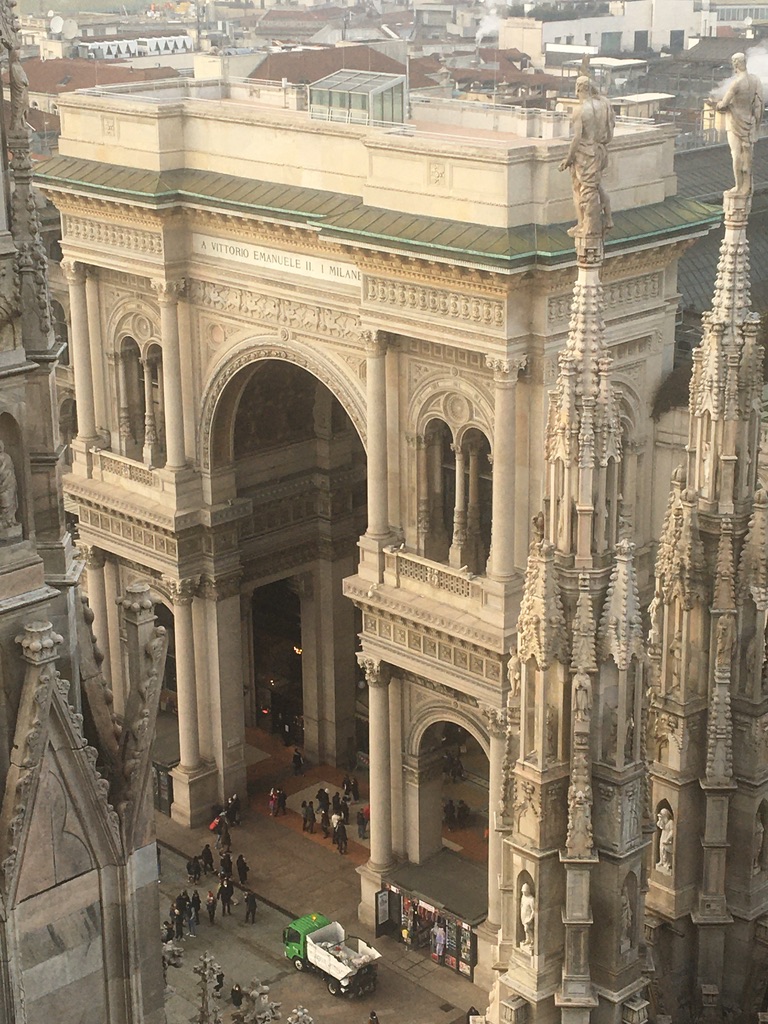 |
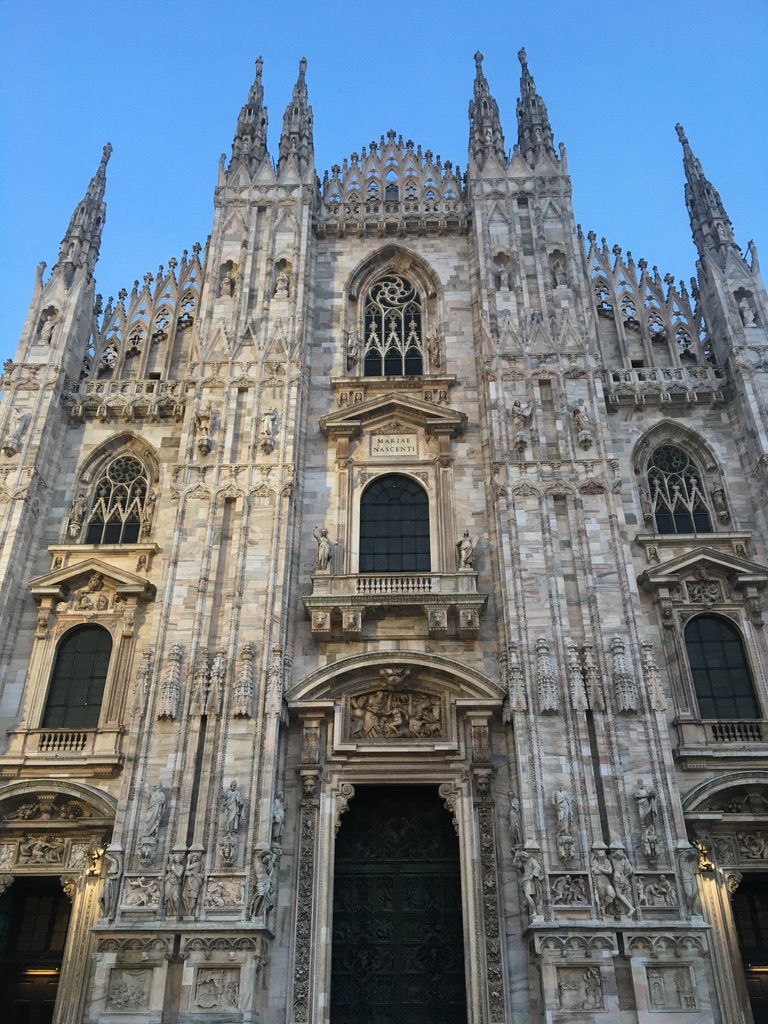 |
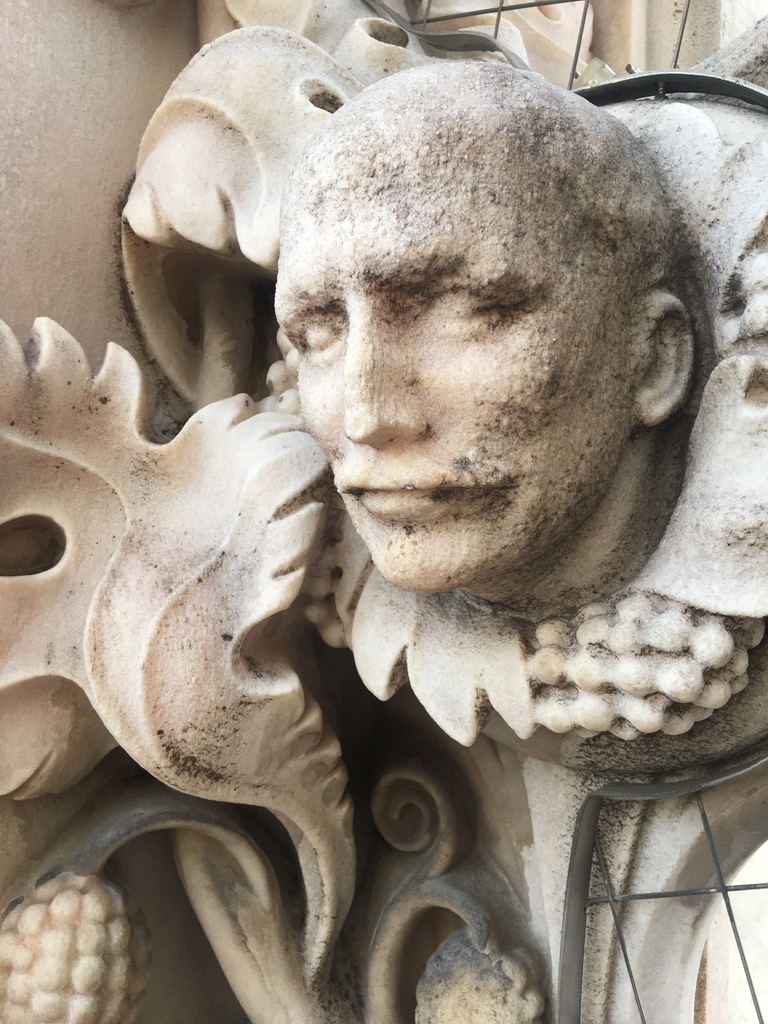 |
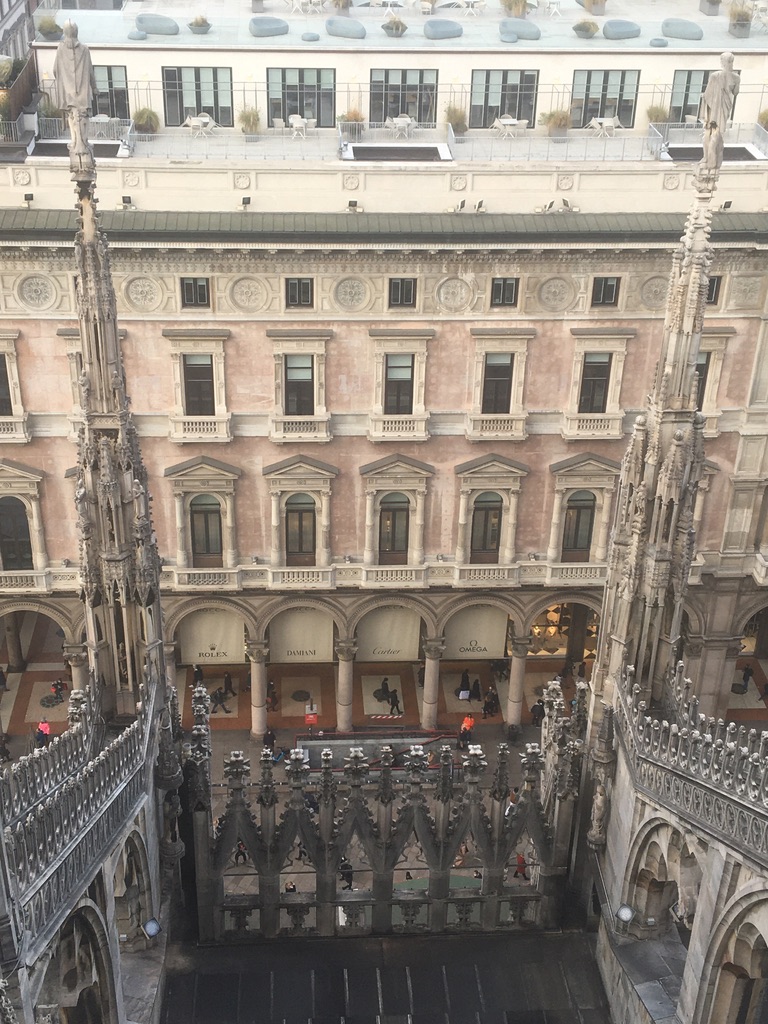 |
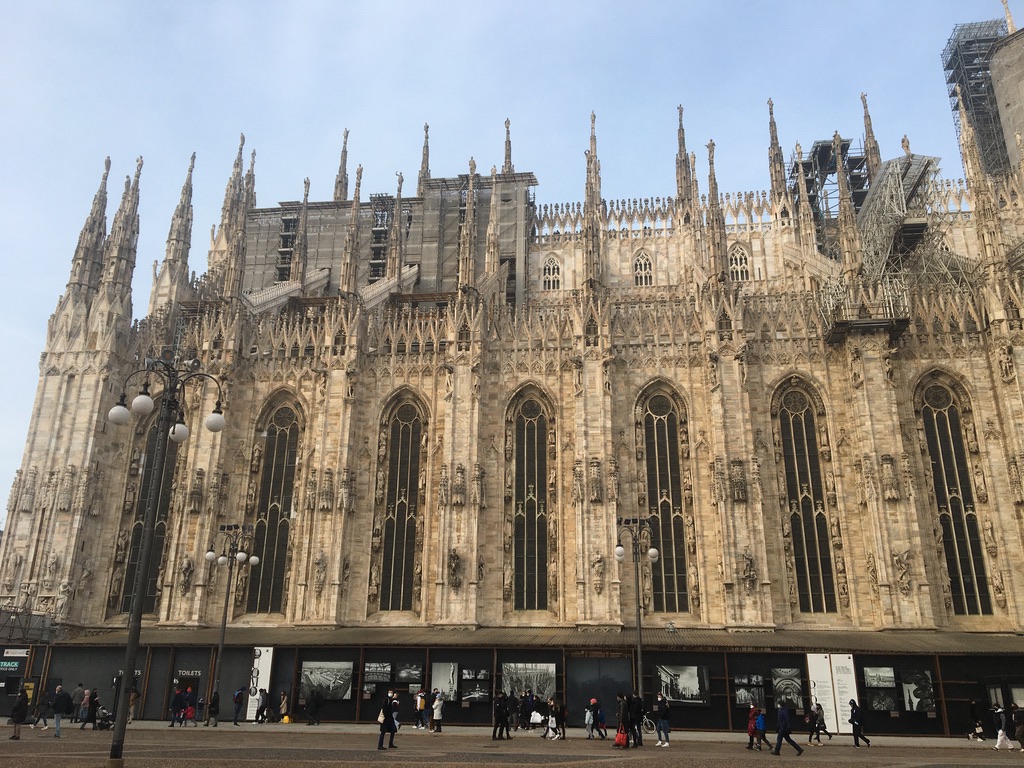 |
- Galleria Vittorio Emanuele II
After Duomo’s cultural feed, it’s time to relax. You can opt for a cup of espresso and just sit and observe the locals or enjoy the retailing vibrant scene, one of the most spectacular situated just few steps from Duomo–Galleria Vittorio Emanuele II.
This shopping gallery is one of the oldest in Italy and is named after Victor Emmanuel II, the first king of the Kingdom of Italy. The gallery is a very popular meeting and dining place for many Milanese, it also many retailers selling luxury goods: haute couture clothes, books or paintings. You will also find there many upscale restaurants and cafes.
In December the gallery is beautifully decorated for Christmas, you will find there a stunning Christmas tree, and the window shops are also adorned with festive exhibitions.
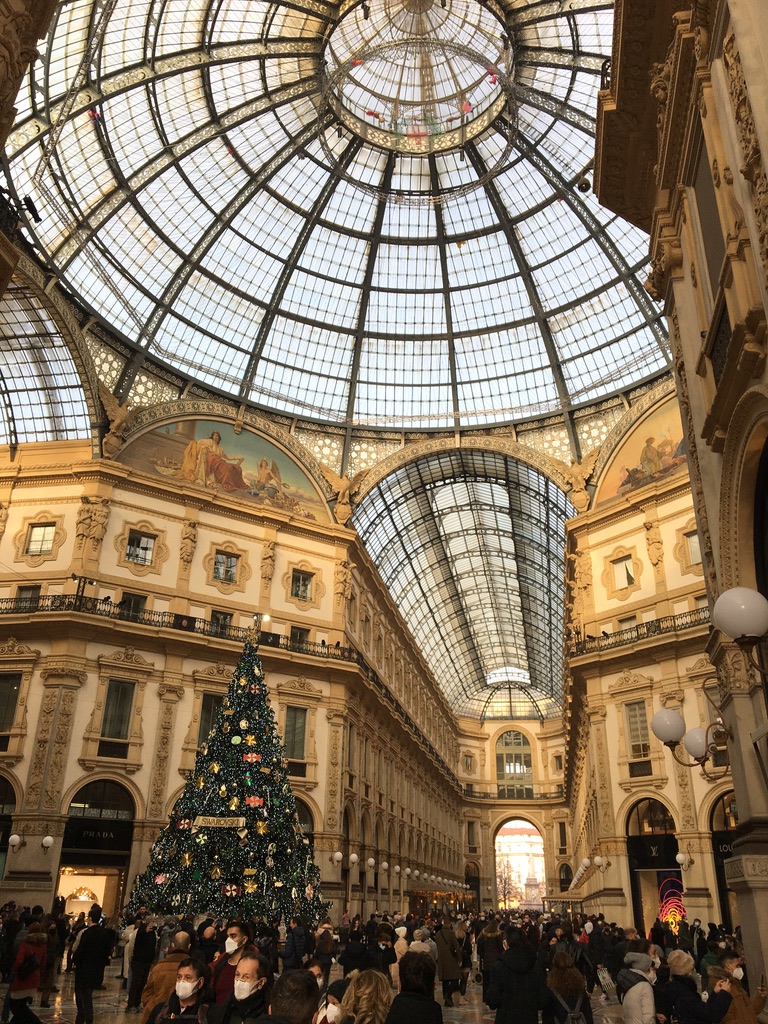 |
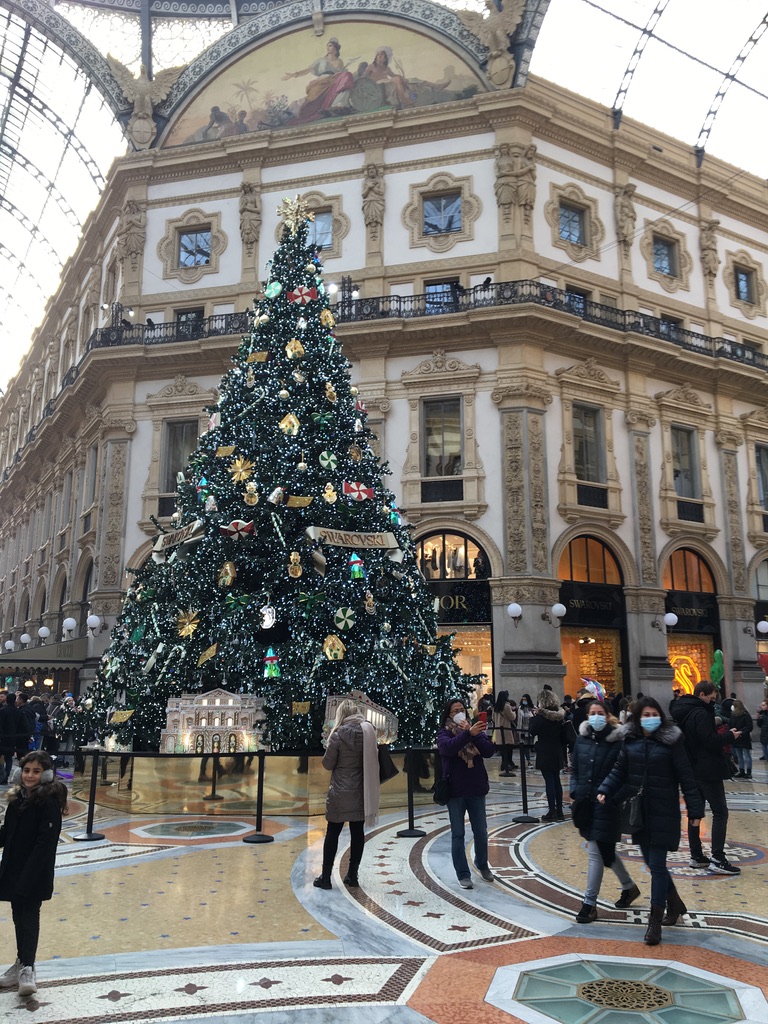 |
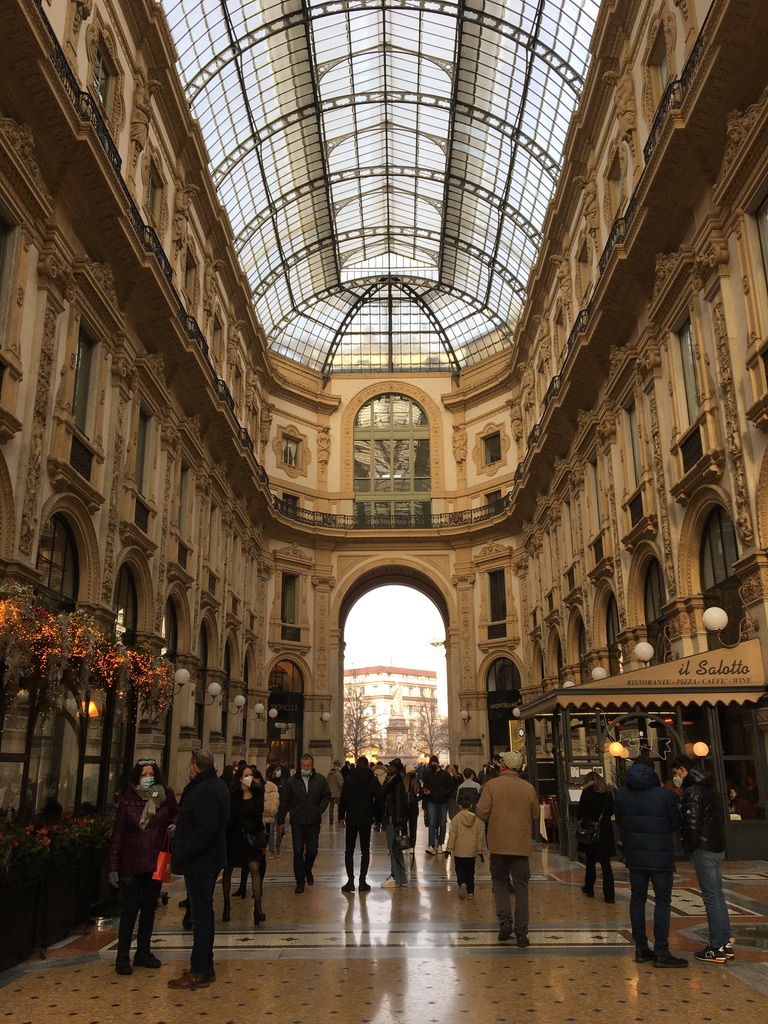 |
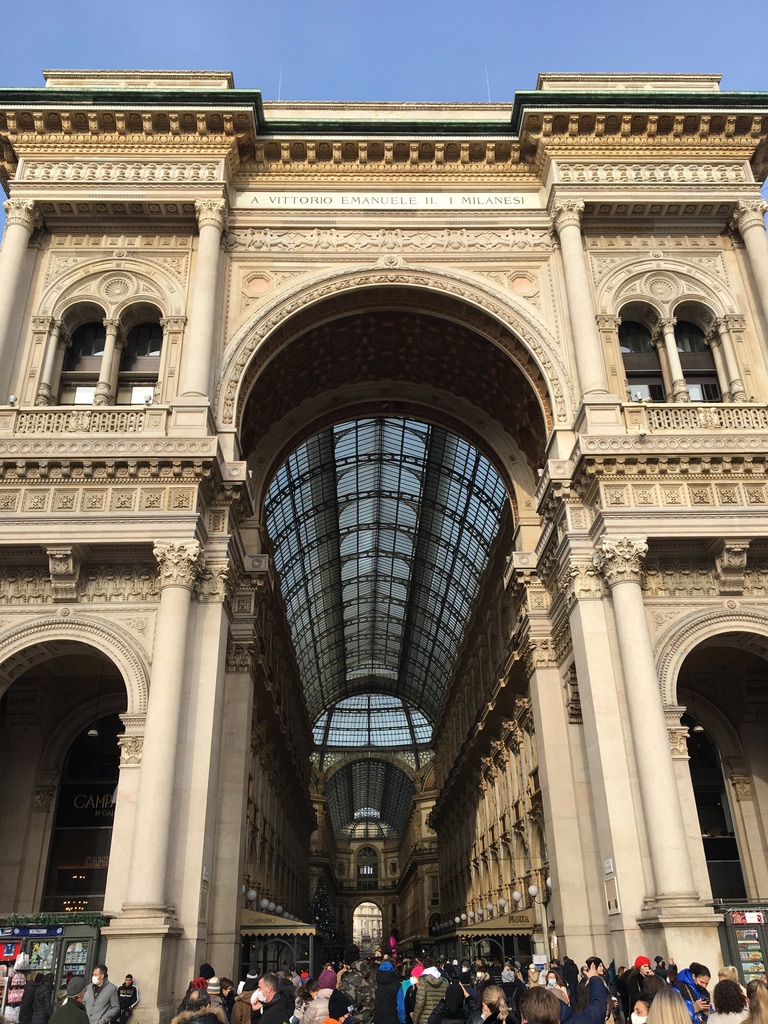 |
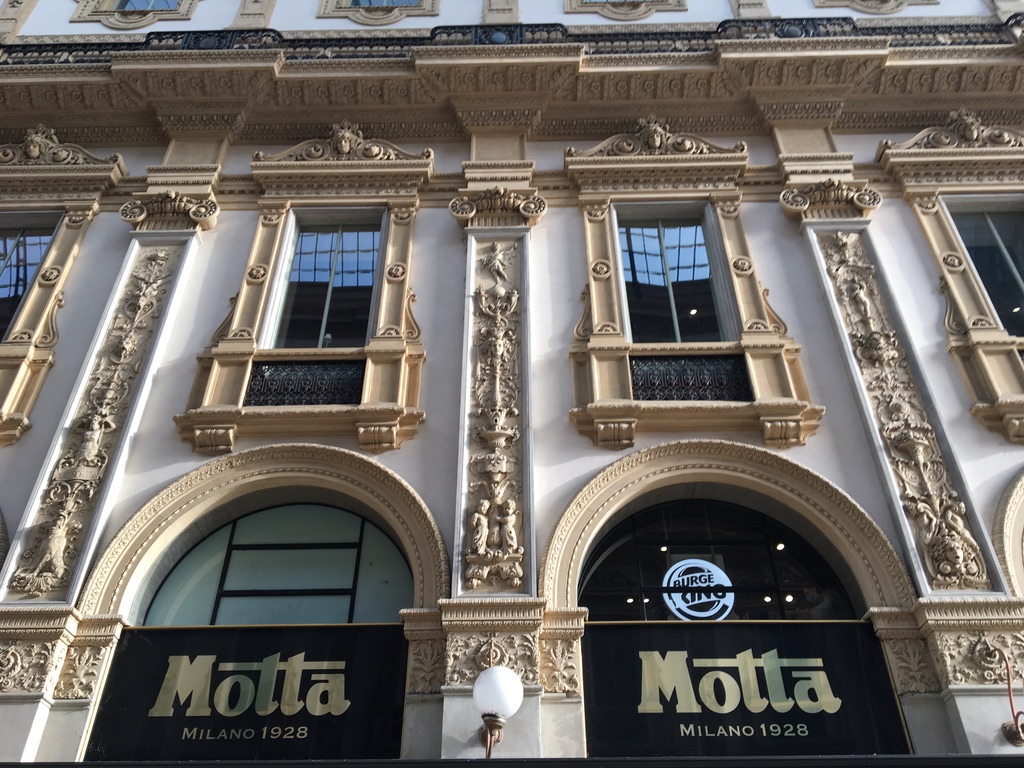 |
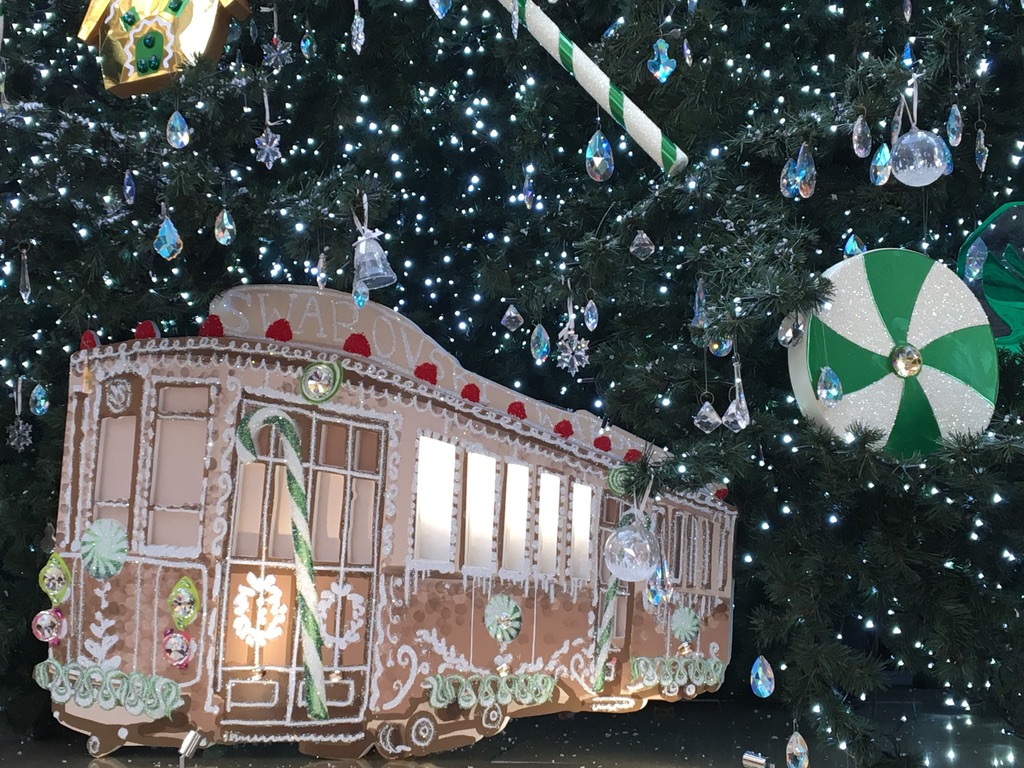 |
- Teatro alla Scala and how to get the tickets
Any stay in Milan wouldn’t be complete without visiting world famous opera La Scala.
Most of the most accomplished singers from around the world, have performed at La Scala. The theatre is one of the leading opera and ballet theatres globally, many famous operas have had their first production in La Scala, such as Othello, Nabucco by Verdi or Madame Butterfly by Giacomo Puccini.
We were planning to attend the ballet La Bayadère, but the performance was cancelled due to many Covid cases among the dancers. We were quite disappointed, but tried to keep optimistic, we gave a good reason to visit Milan again.
Obviously we were unlucky, however it shouldn’t deter you for snatching the tickets for the La Scala show. The program of the performances is available on their website and the regular tickets can be bought there too (click here). However, La Scala tickets tend to be expensive. To get better prices, it’s worth to check the opera website much more in advance (few months if possible) before your trip, since the cheapest tickets get sold much earlier. Another solution is to go for a last minute tickets (25% discount) available one hour before performances in the Box Office. Apart from that, for every performance the Theatre offers 140 balcony numbered tickets for seats with reduced visibility. The tickets are very cheap and are available on the day of performance, but the procedure is quite complicated including registering on the list in the early afternoon and then coming back around 17:30 to learn to purchase the tickets (see the instruction on the Italian version of the Theater’s website). Personally, I don’t find this description very clear so my advice is that if you want to try this approach, I recommend to go one day before to the Box Office and ask for explanation how this system works exactly, so you won’t make mistakes and lose your chance to get the tickets.
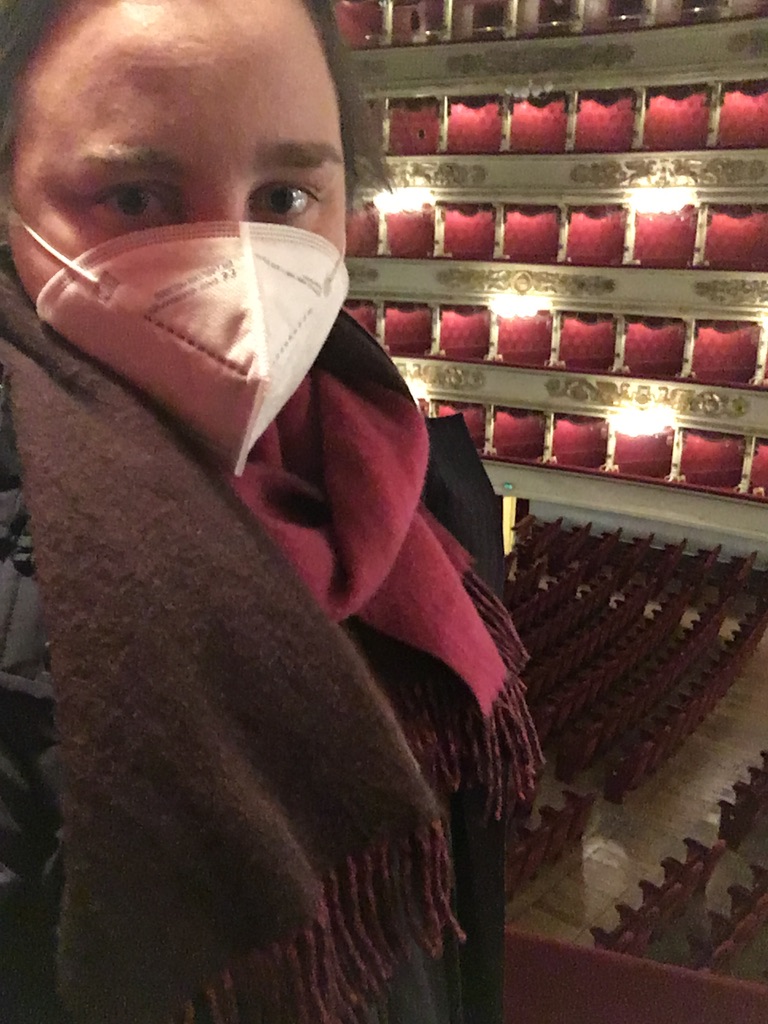 |
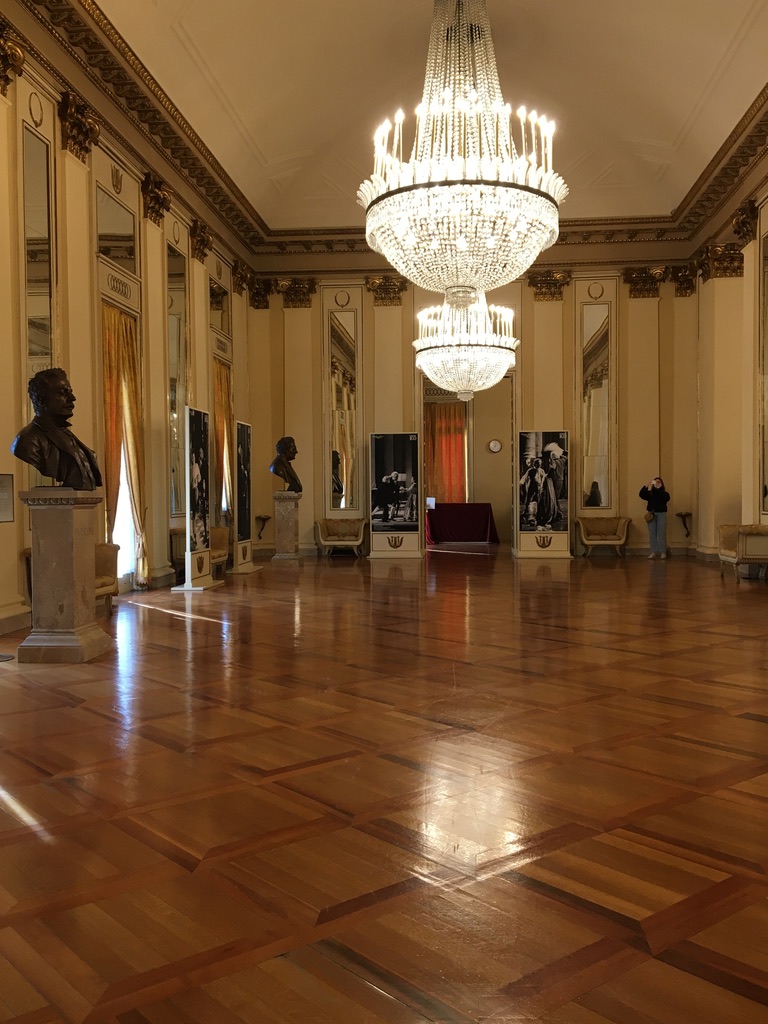 |
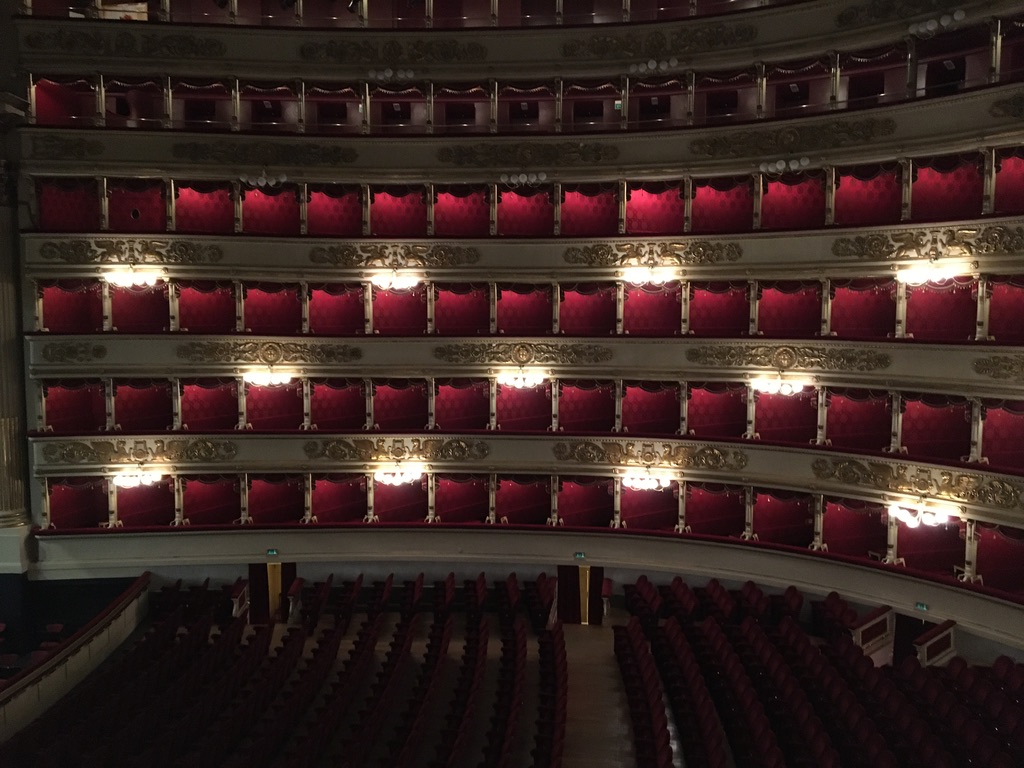 |
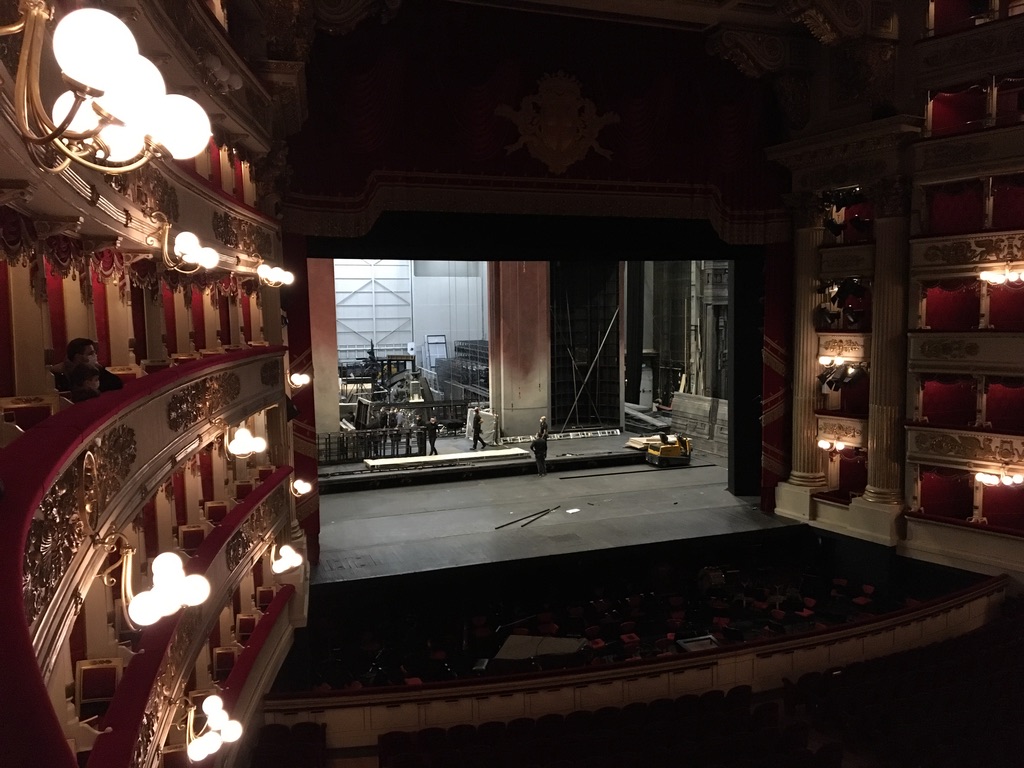 |
Since the performances were cancelled during our stay, we have decided to visit the Theater Museum, a good alternative for those who also didn’t manage the tickets for the performance. The Theatre Museum includes an impressive collection of paintings and busts. You will also find costumes from the past performances and several other objects and props related to the history of the Theater. The visit leads through theatre’s grand foyer, a chic and sparsely decorated hall. All along the walk you will find poster announcements of historical shows (some of them from previous centuries and some are contemporary). The visit continues to the small box seats decorated in red satin, where the spectators watch the various operas and ballets performed in La Scala. The impressive auditorium is made of wood and covered in red velvet, decorated with golden coloured stuccos. The stage is lit by a huge Bohemian crystal chandelier with 383 bulbs.
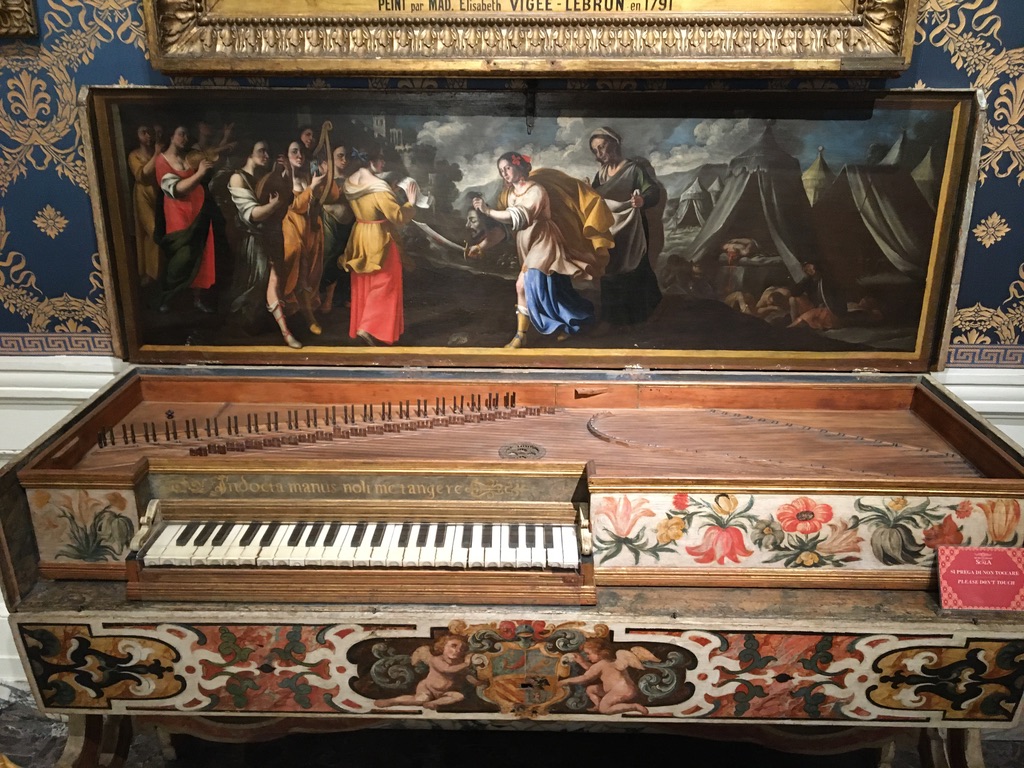 |
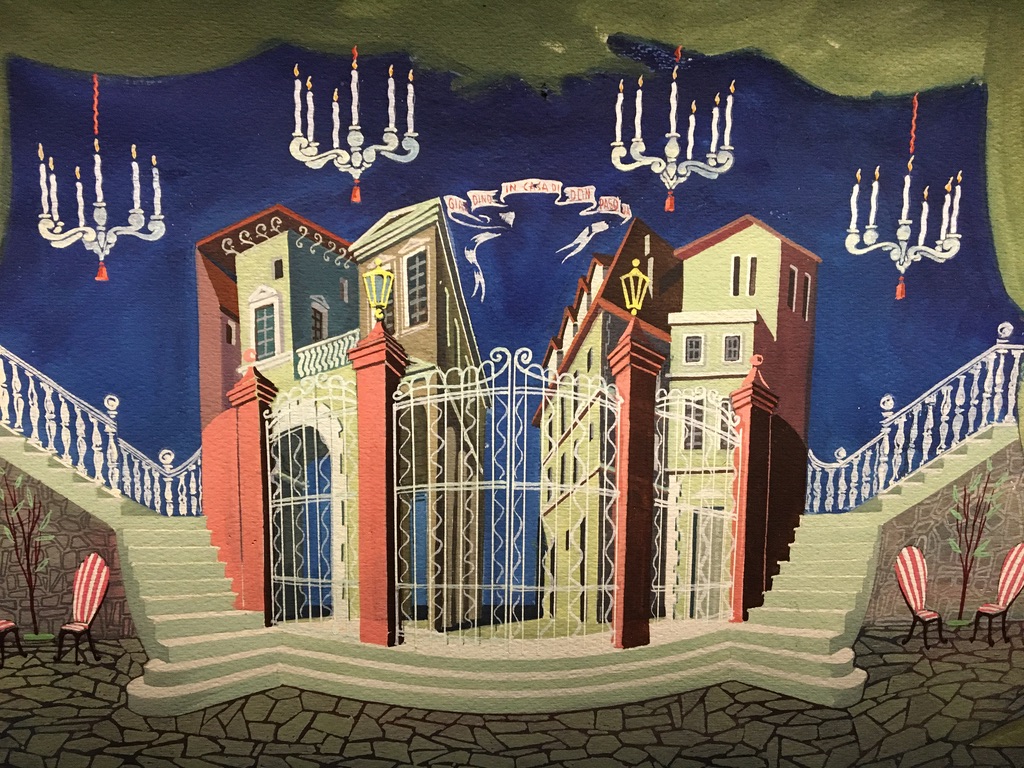 |
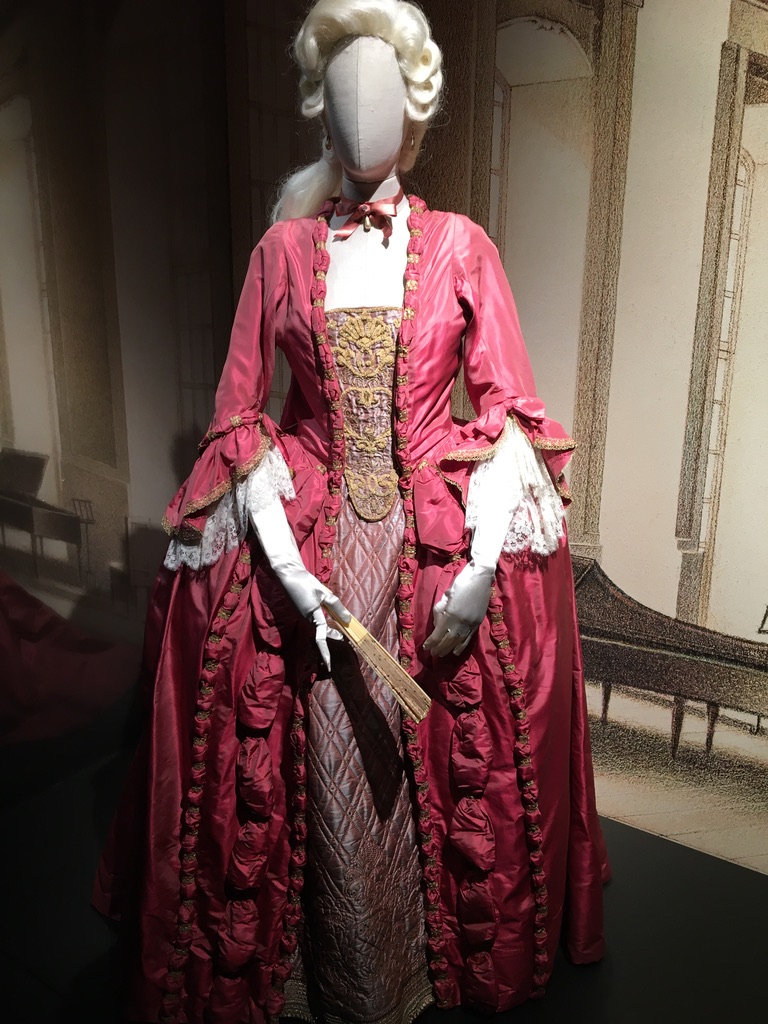 |
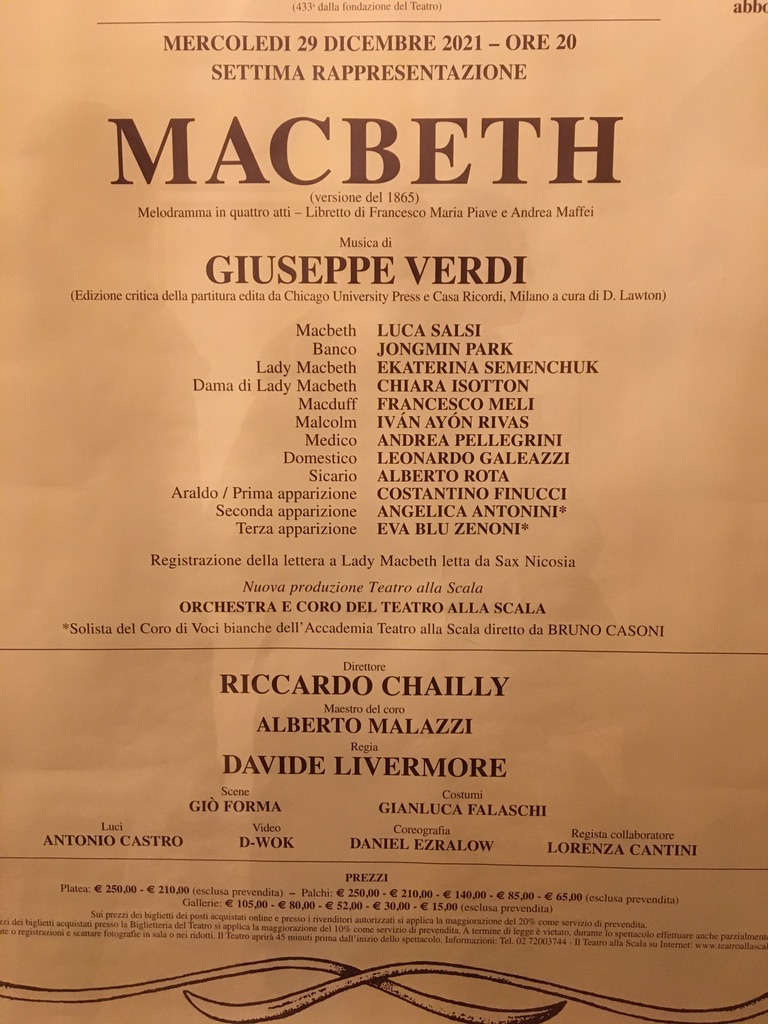 |
Day 2
- Pinacoteca di Brera
We started our day with famous art gallery Pinacoteca di Brera situated in Palazzo di Brera.
In this museum, you will find one of the finest t collections of Italian paintings including such masterpieces as St. Mark Preaching in Alexandria by Bellini, The Marriage of the Virgin by Raffaello Sanzio (Raphael) or Supper at Emmaus by Caravaggio (Michelangelo Merisi) to name just a few.
The building deserves attention on its own, erected as a Jesuit college, the grandiose Palazzo di Brera is not only a house to Brera Art Gallery, but also other prestigious bodies such as Academy of Fine Arts, the Astronomical Observatory and Lombard Academy of Sciences and Art.
The palace is organized around an elegant rectangular courtyard with two orders of arches on coupled columns, linked to a double flight of monumental steps.
At the beginning of 19th century the palace received works from oppressed churches and convents which formed first nucleus of the Art Gallery, later expanded with further acquisitions being now one of Italy’s major museums.
For the opening hours and online ticket purchase, consult the Pinacoteca di Brera website.
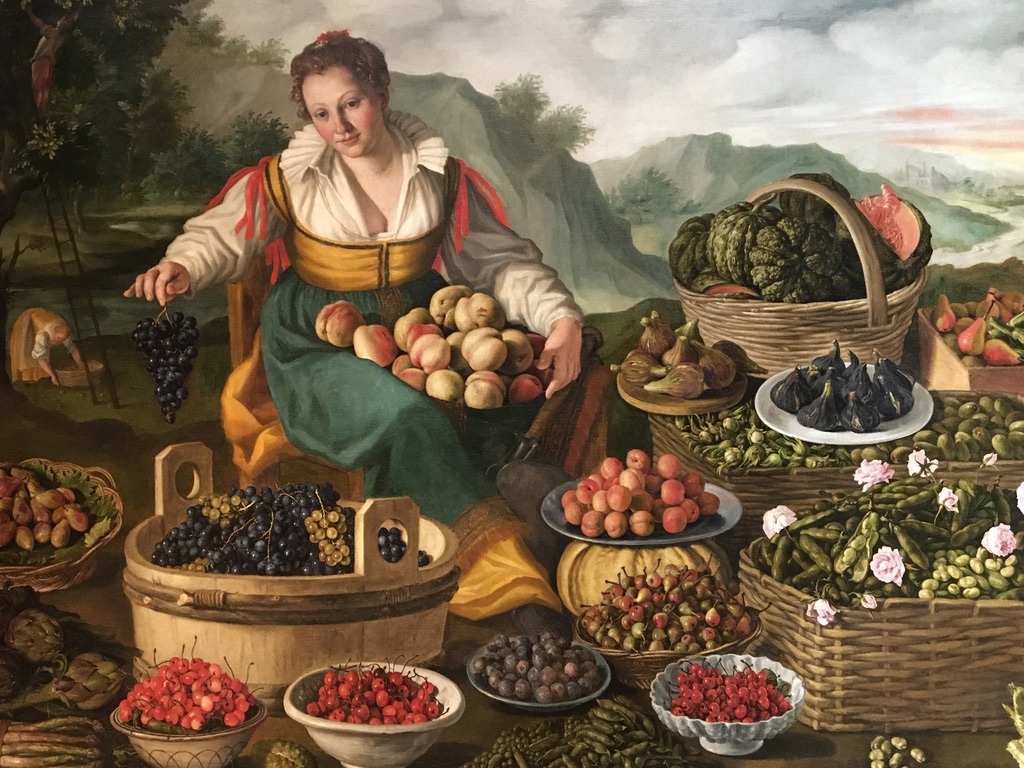 |
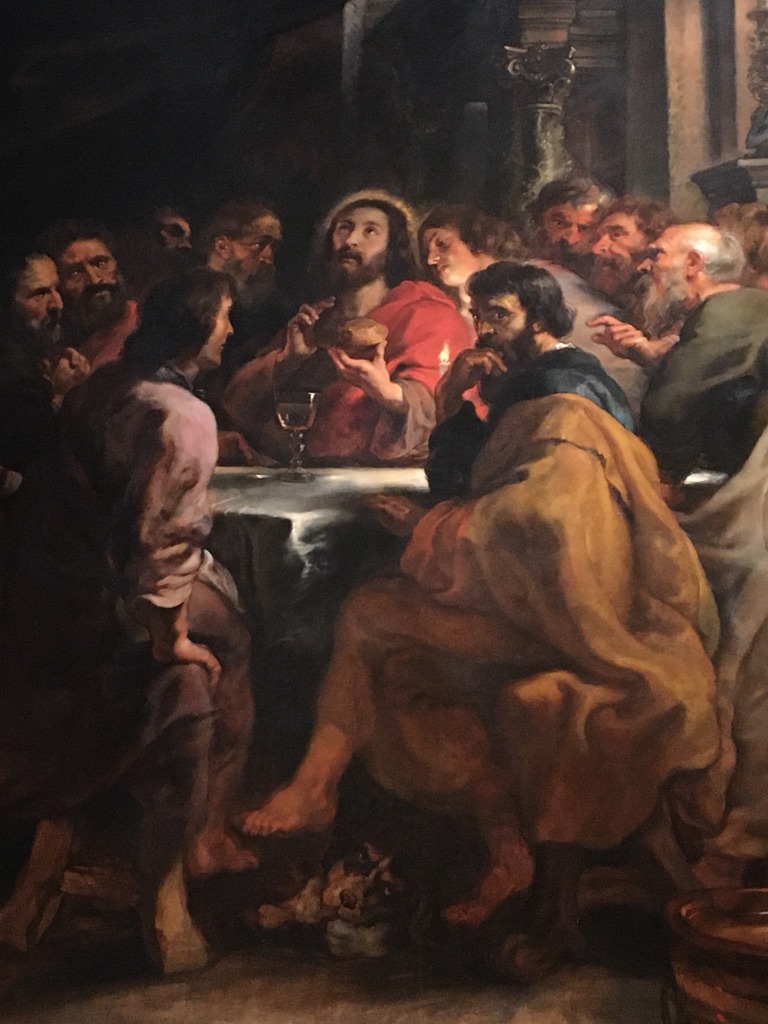 |
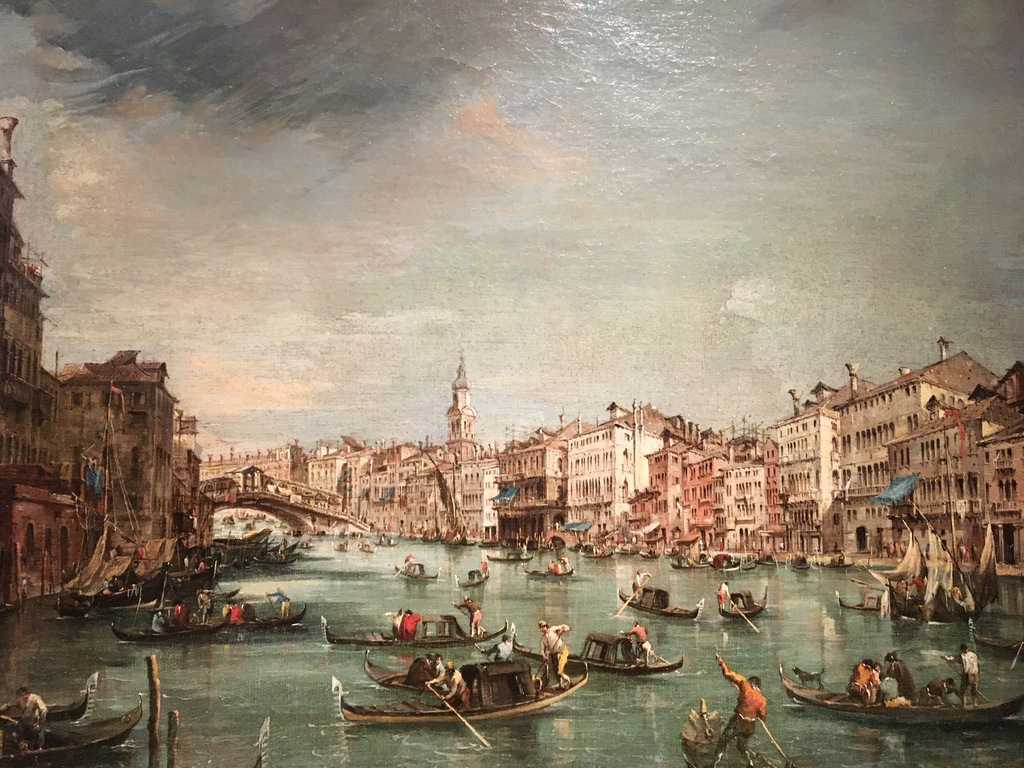 |
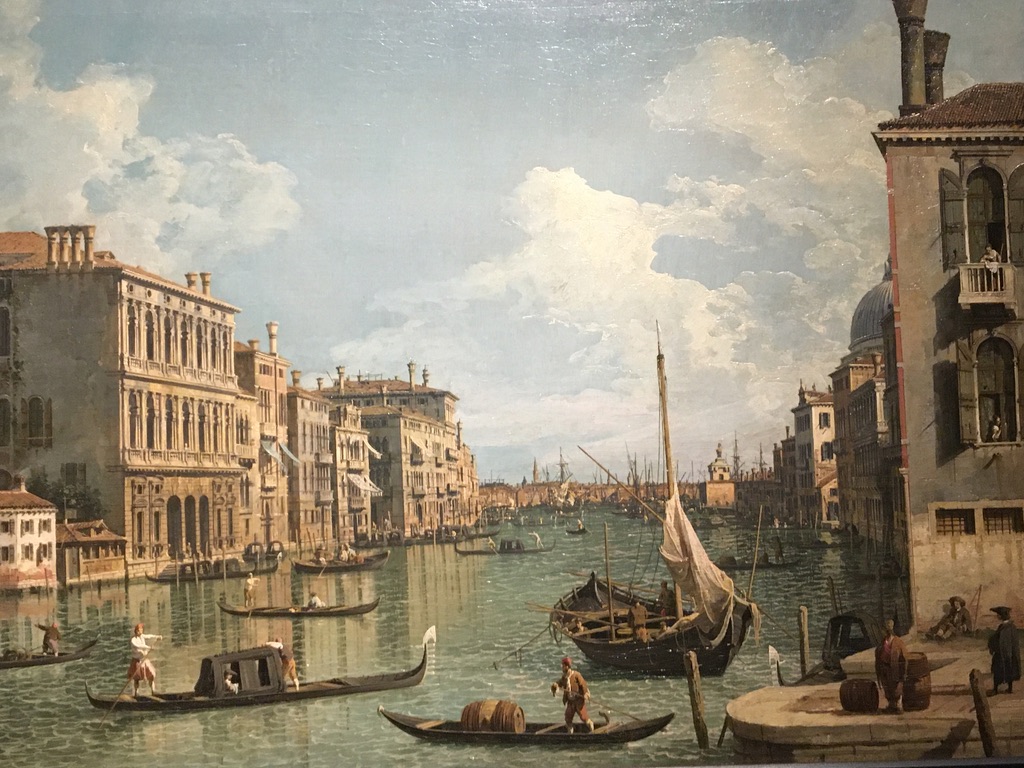 |
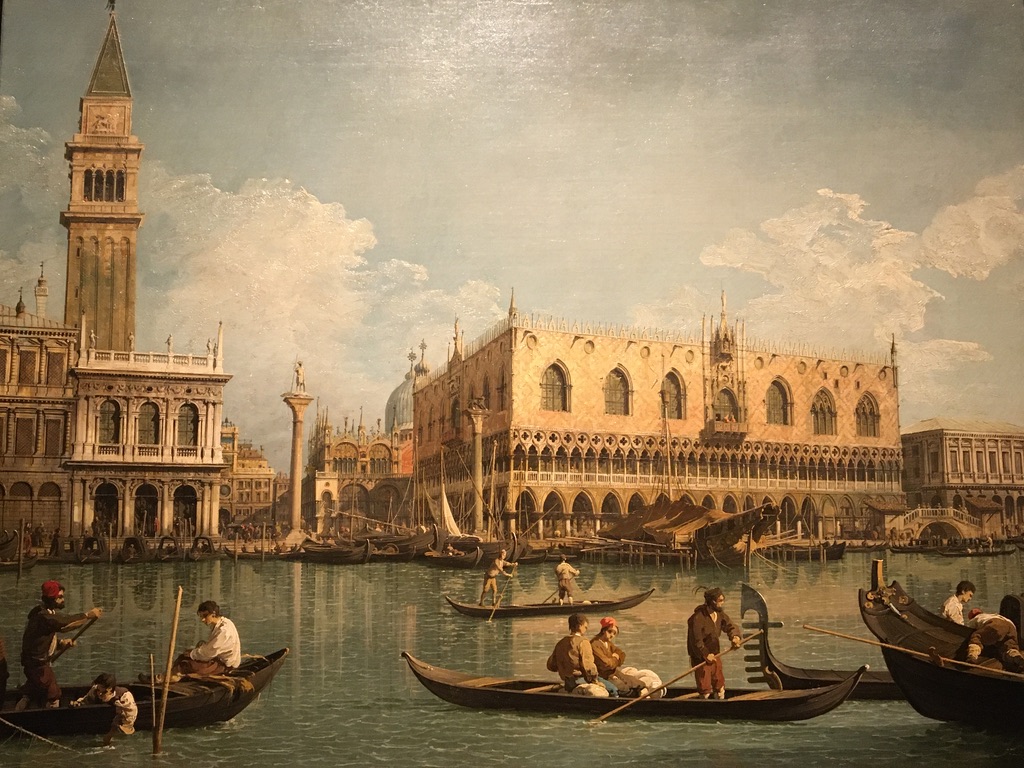 |
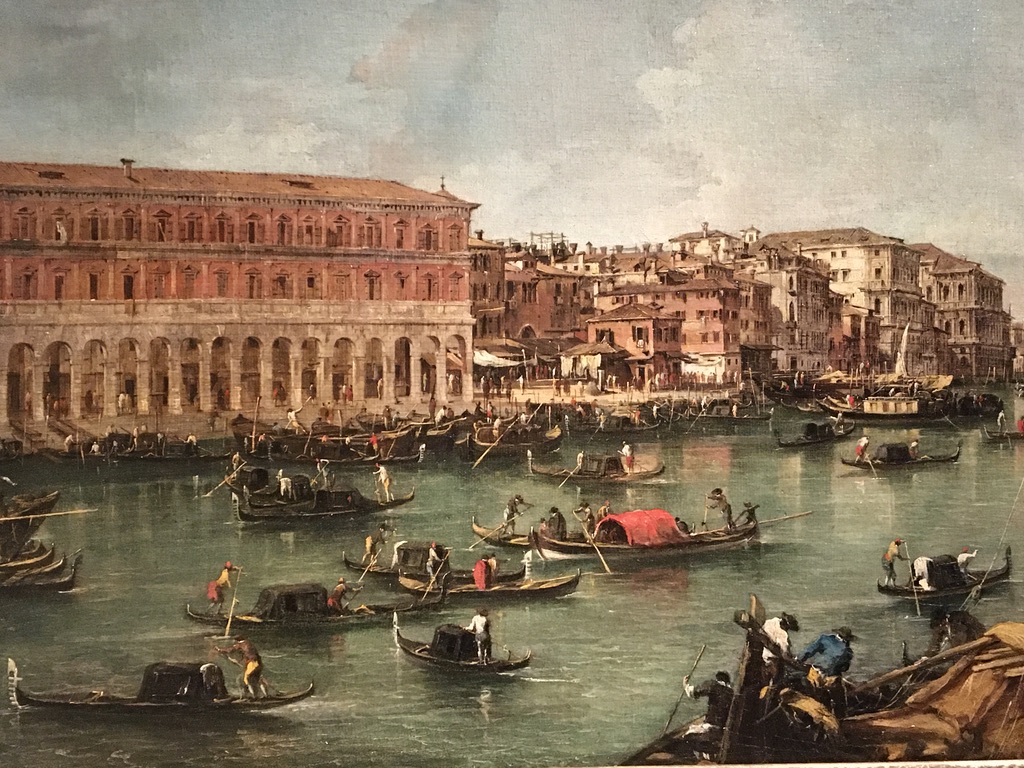 |
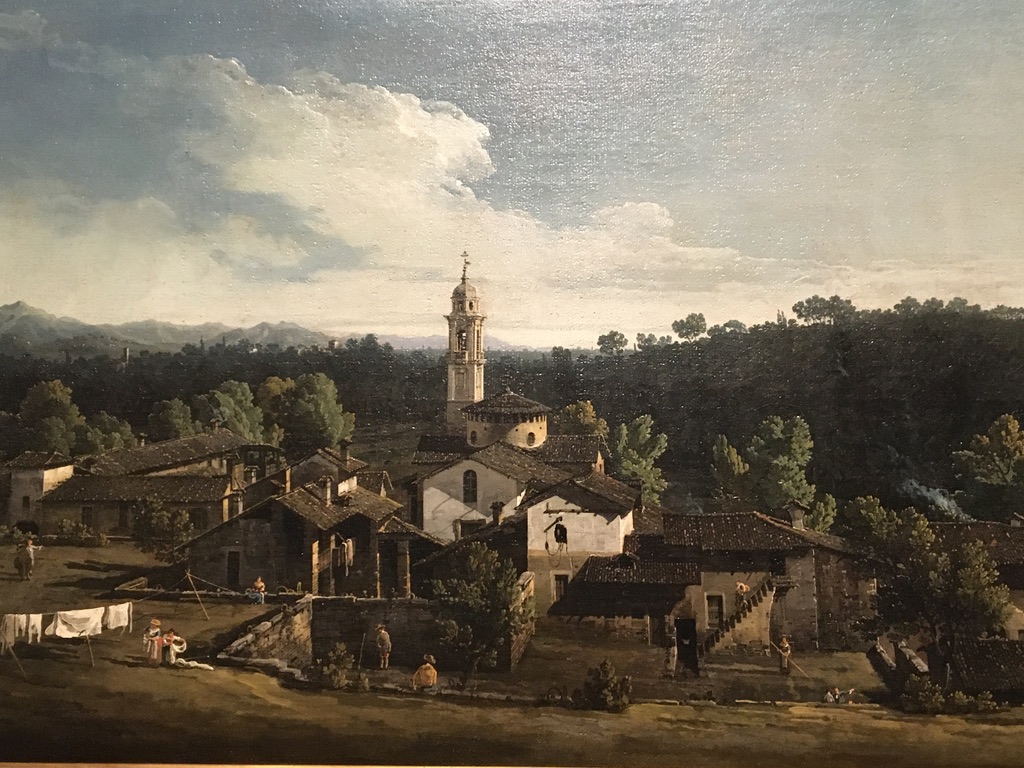 |
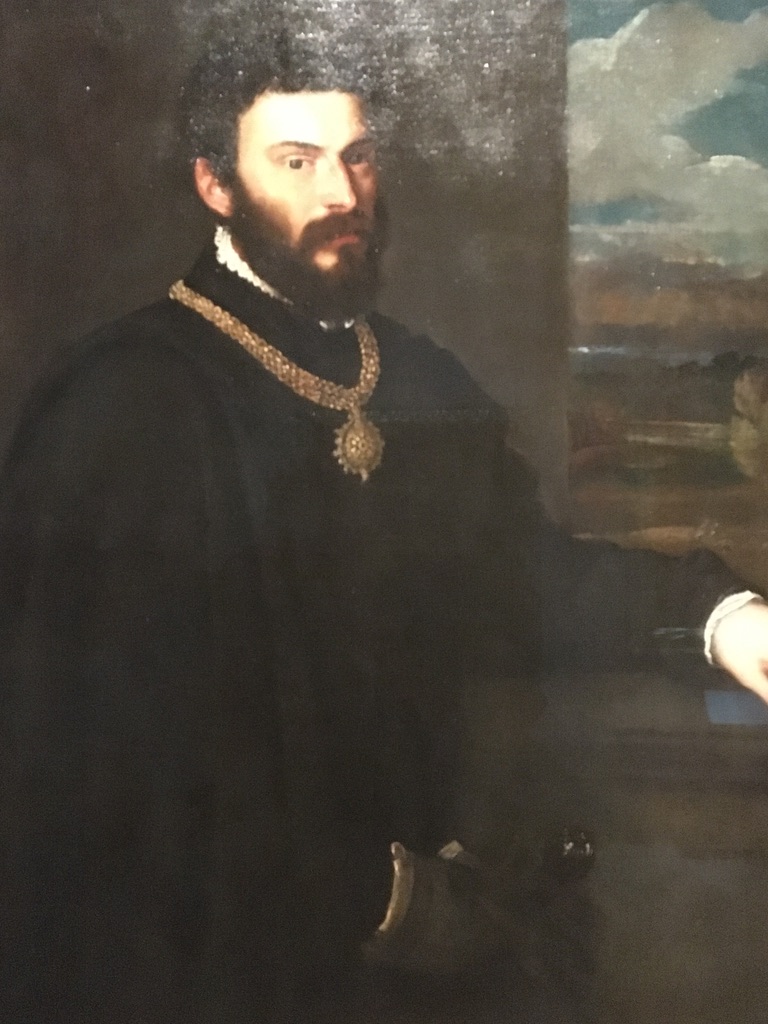 |
- Golden Triangle
After a huge cultural feast in Pinacoteca di Brera, we wanted to walk around Milan city center. Since Milan is so famous from fashion and its luxury shopping options, we decided to visit the Golden Triangle–Via della Spiga, Via Sant Andrea and Via Montenapoleone–Milanese most upscale shopping streets where many well-known fashion designers have their high-end boutiques. You will find there jewelry shops, read-to-wear collections from famous designers and many other shops selling luxury items. In December/early January period most of the windows of the boutiques are beautifully adorned with Christmas decorations, also the streets are illuminating with tasteful installations of colorfoul lights. I recommend to come there in the evening, when the shops are closed and you have all those charming streets to yourself, and since all this area is very chic and prominent, don’t hesitate to turn to some smaller streets hiding even more of the small luxurious shops, ateliers and art galleries, as well as elegant hotels, bars and cafes.
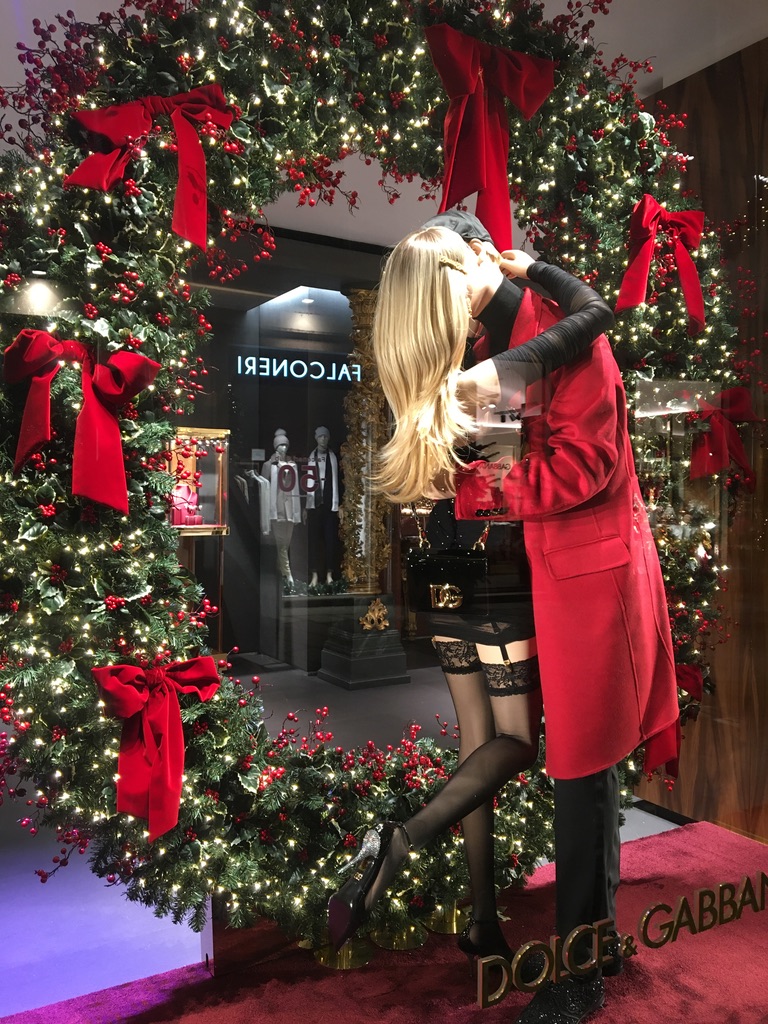 |
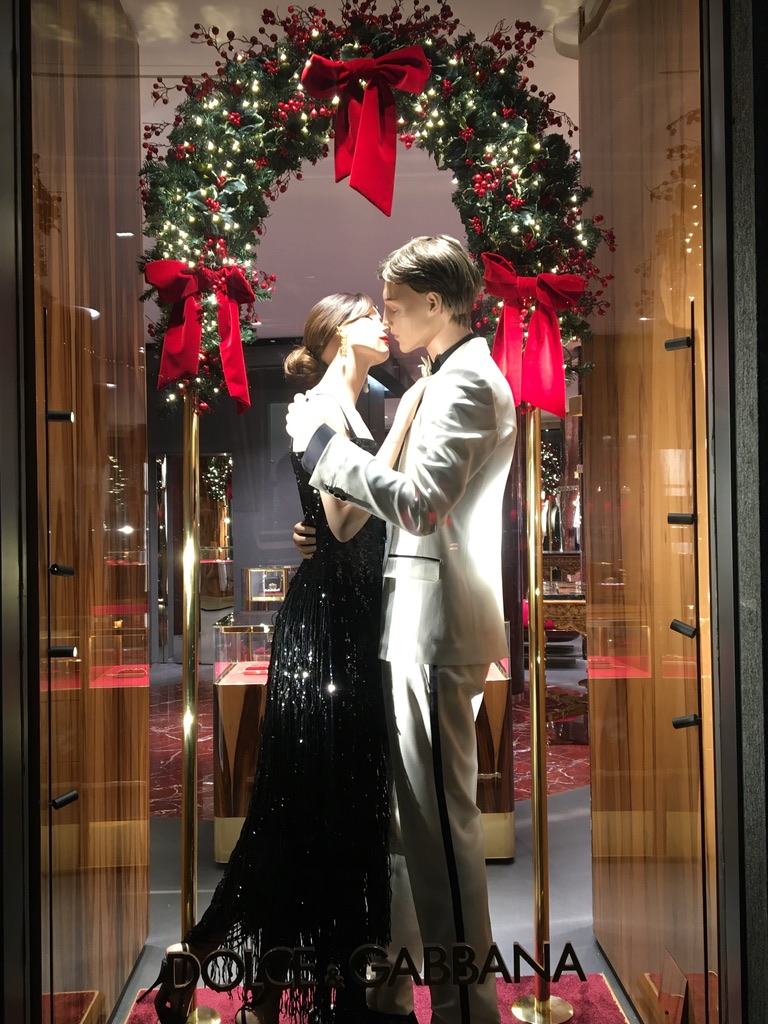 |
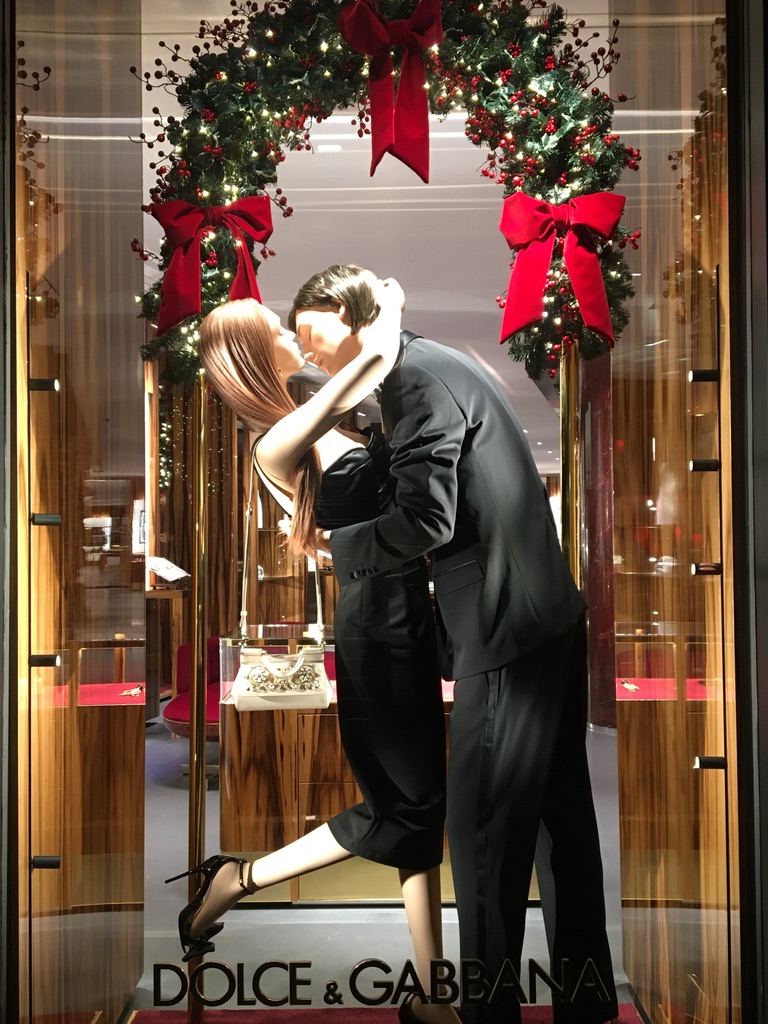 |
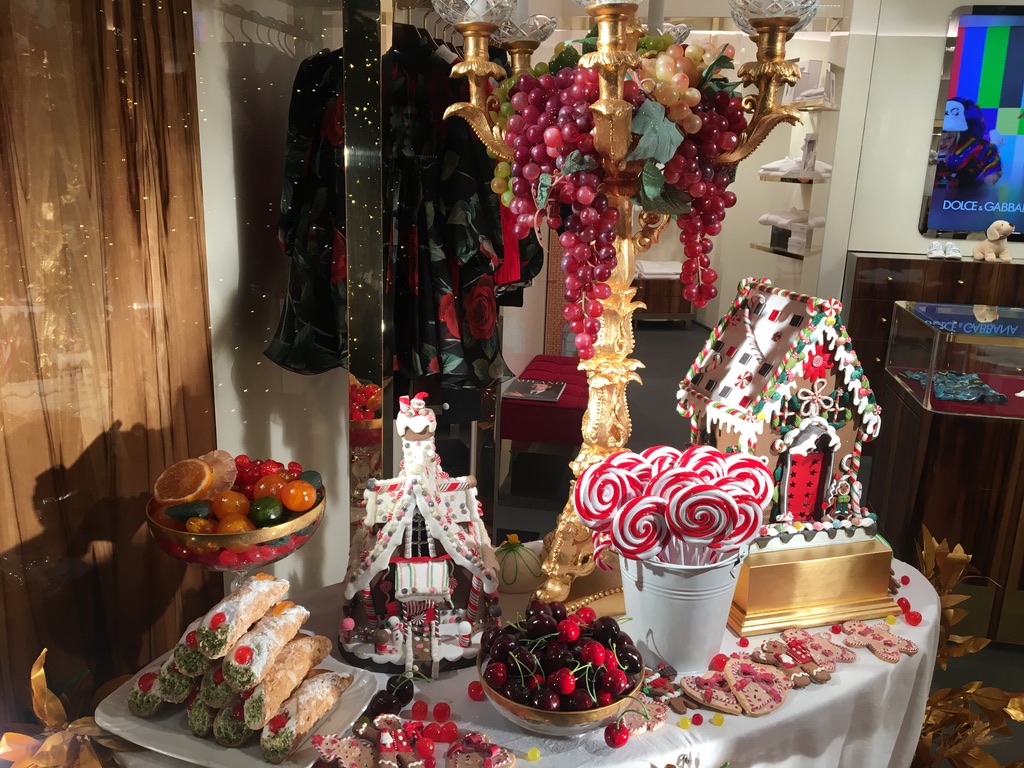 |
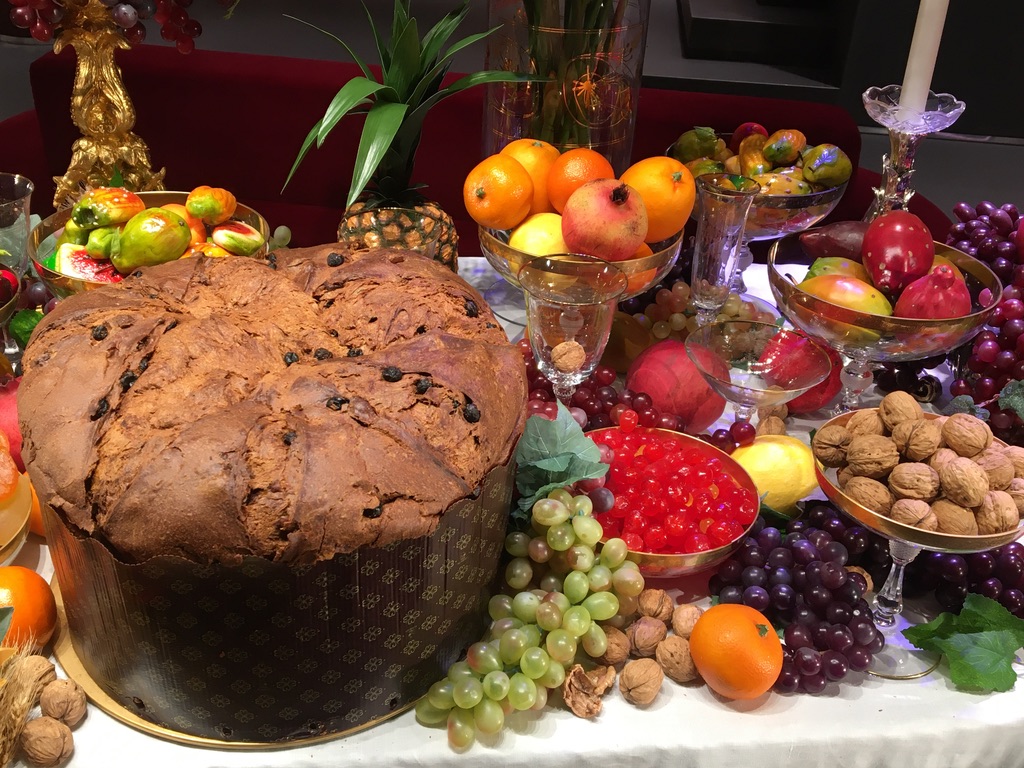 |
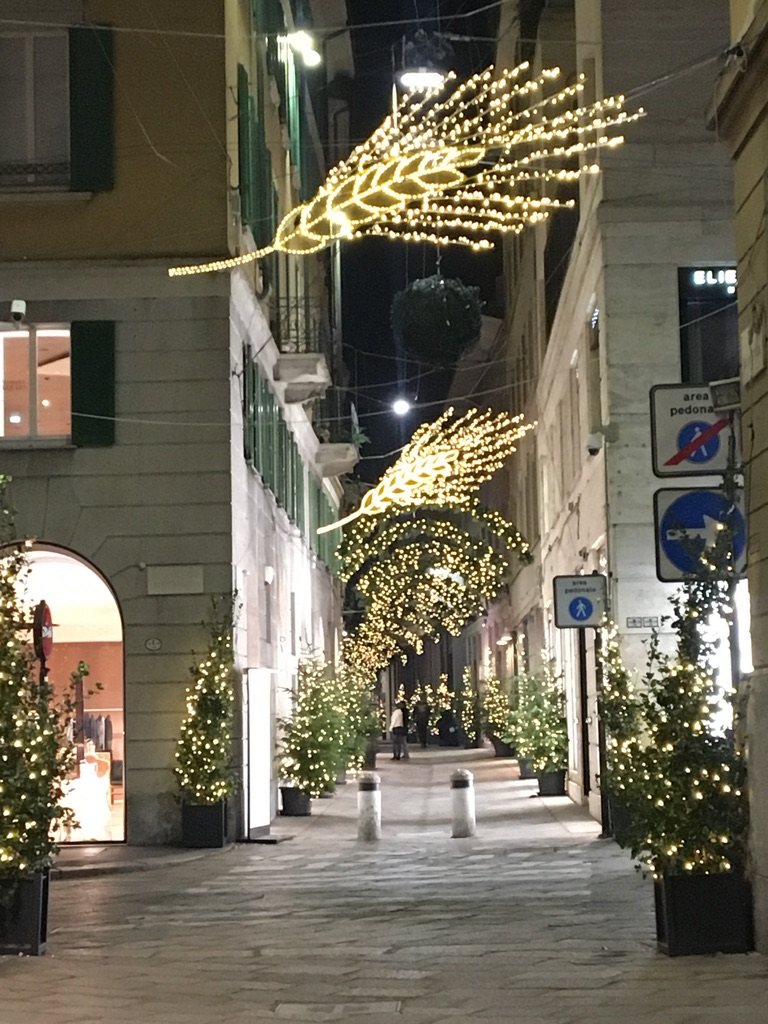 |
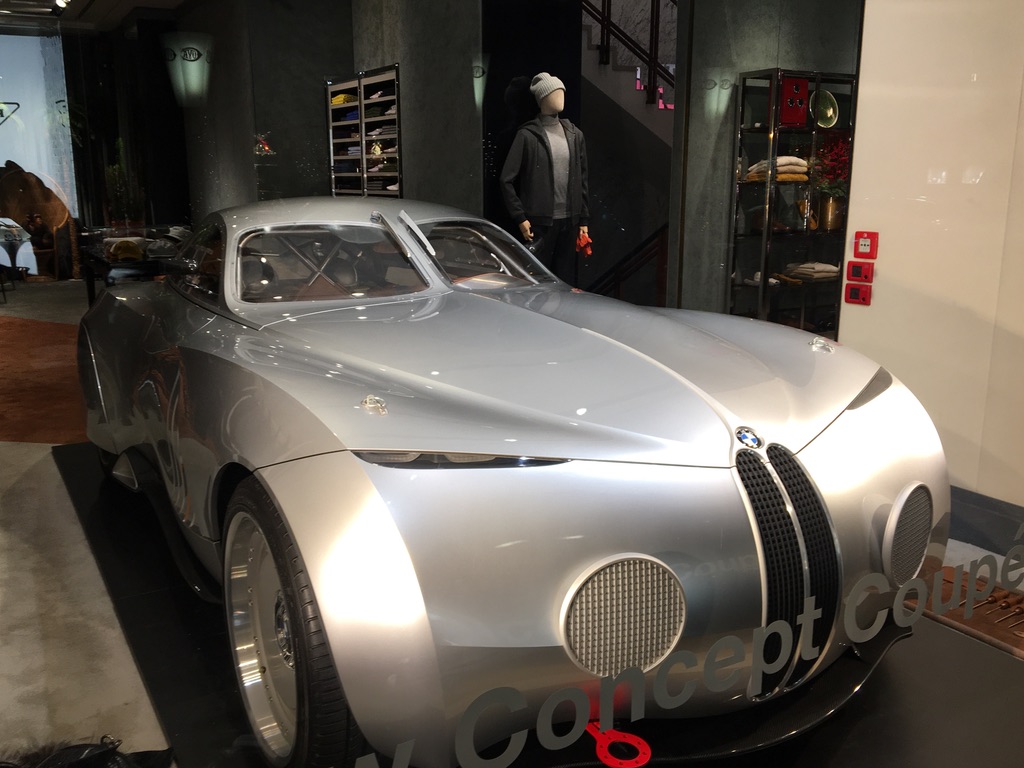 |
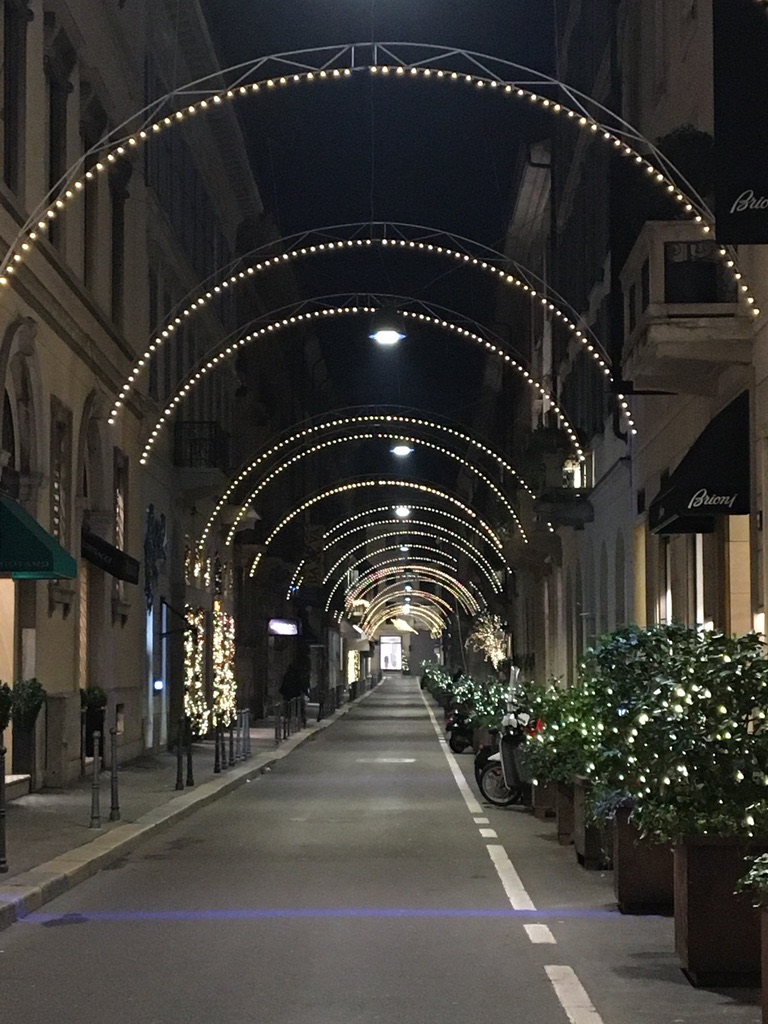 |
- Navigli district
Preparing ourselves for a trip to Milan, we have found a lot of recommendations to visit Navigli district, famous from its water canals, and most of the activities concentrating around Naviglio Grand canal. This place is full of little restaurants and bars, visited both by locals and tourists and can be a bit crowded during lunch/dinner time or in the afternoon/late evening when people come here for a drink (or two).
We ate in the charming Italian cuisine restaurant Asso Di Fiori Osteria Dei Formaggi where we had perfectly balanced risotto and pasta, I was especially seduced by their gorgonzola ice cream dipped in sweet and spicy sauce–really perfect combination of sharp, salty, and earthy taste of the gorgonzola cheese and sweetness of the sauce. Meraviglioso!
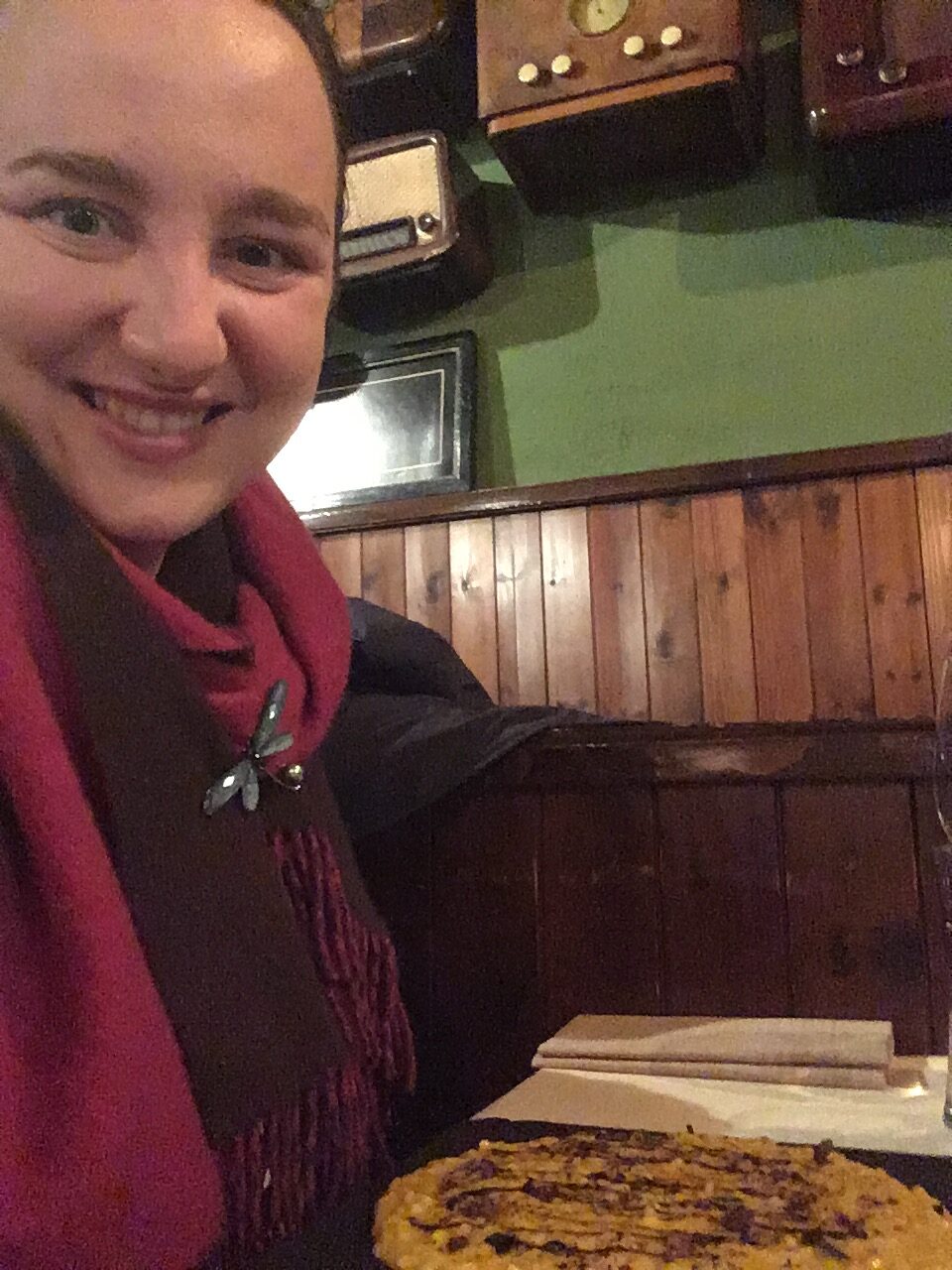 |
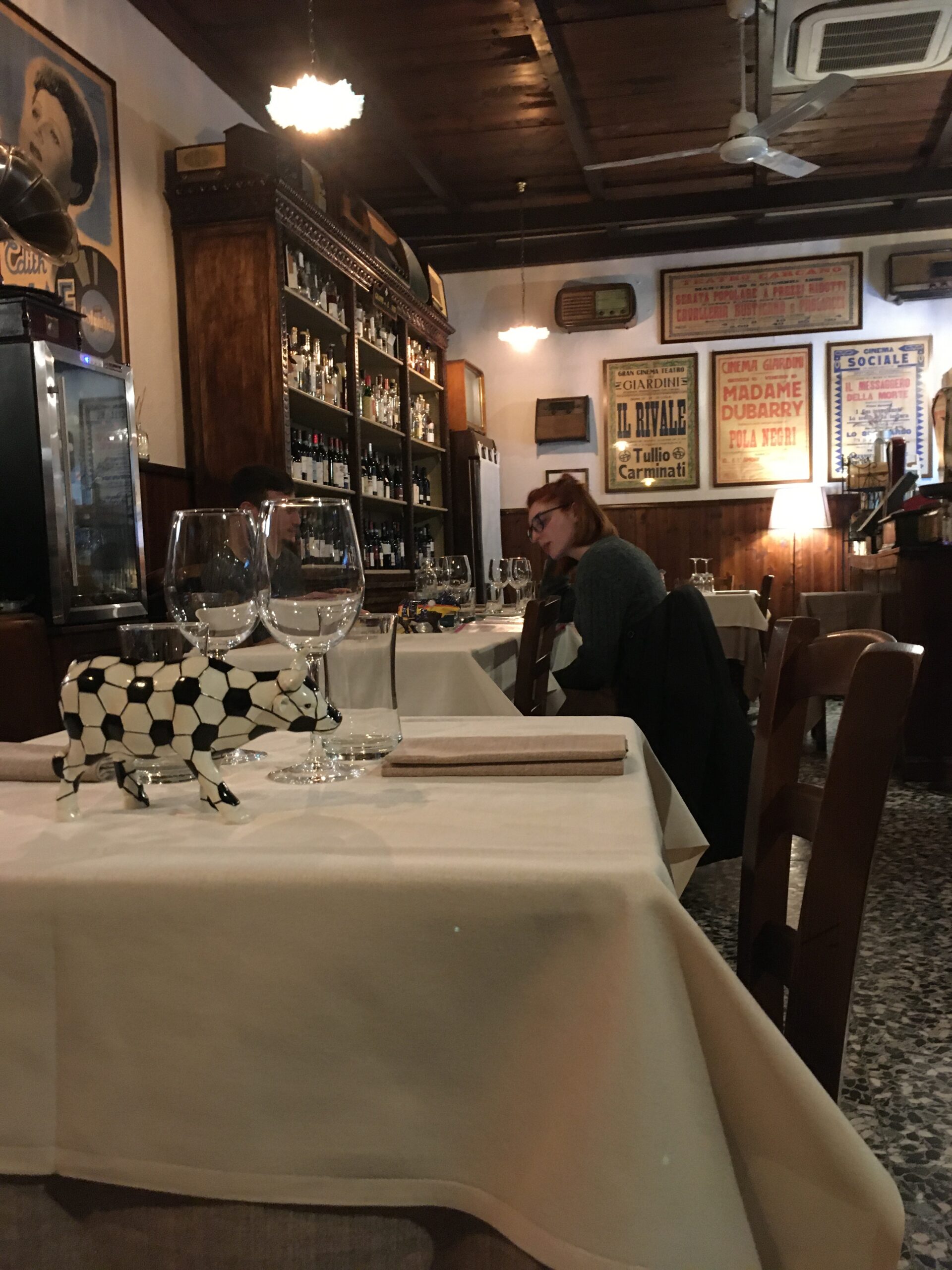 |
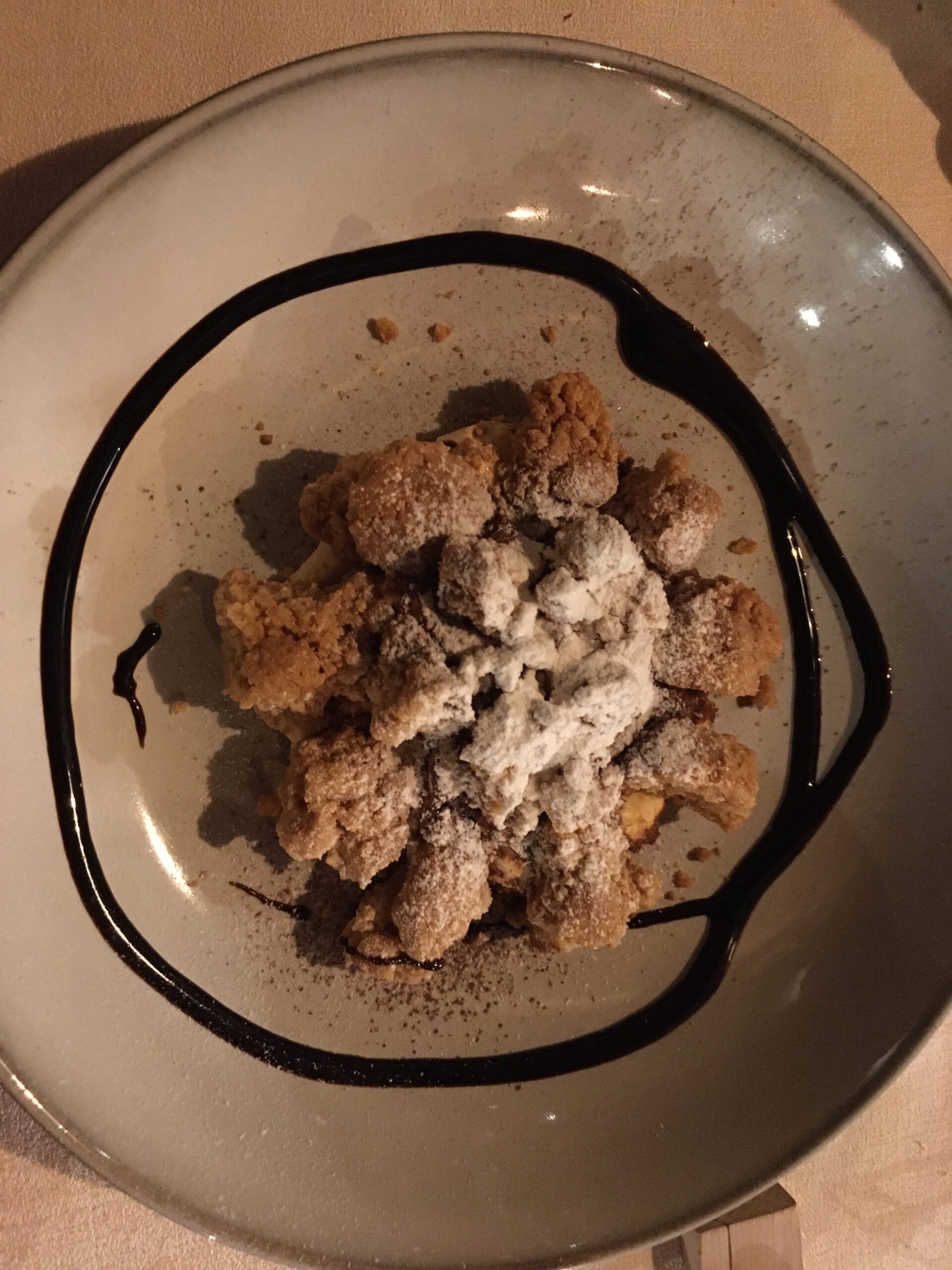 |
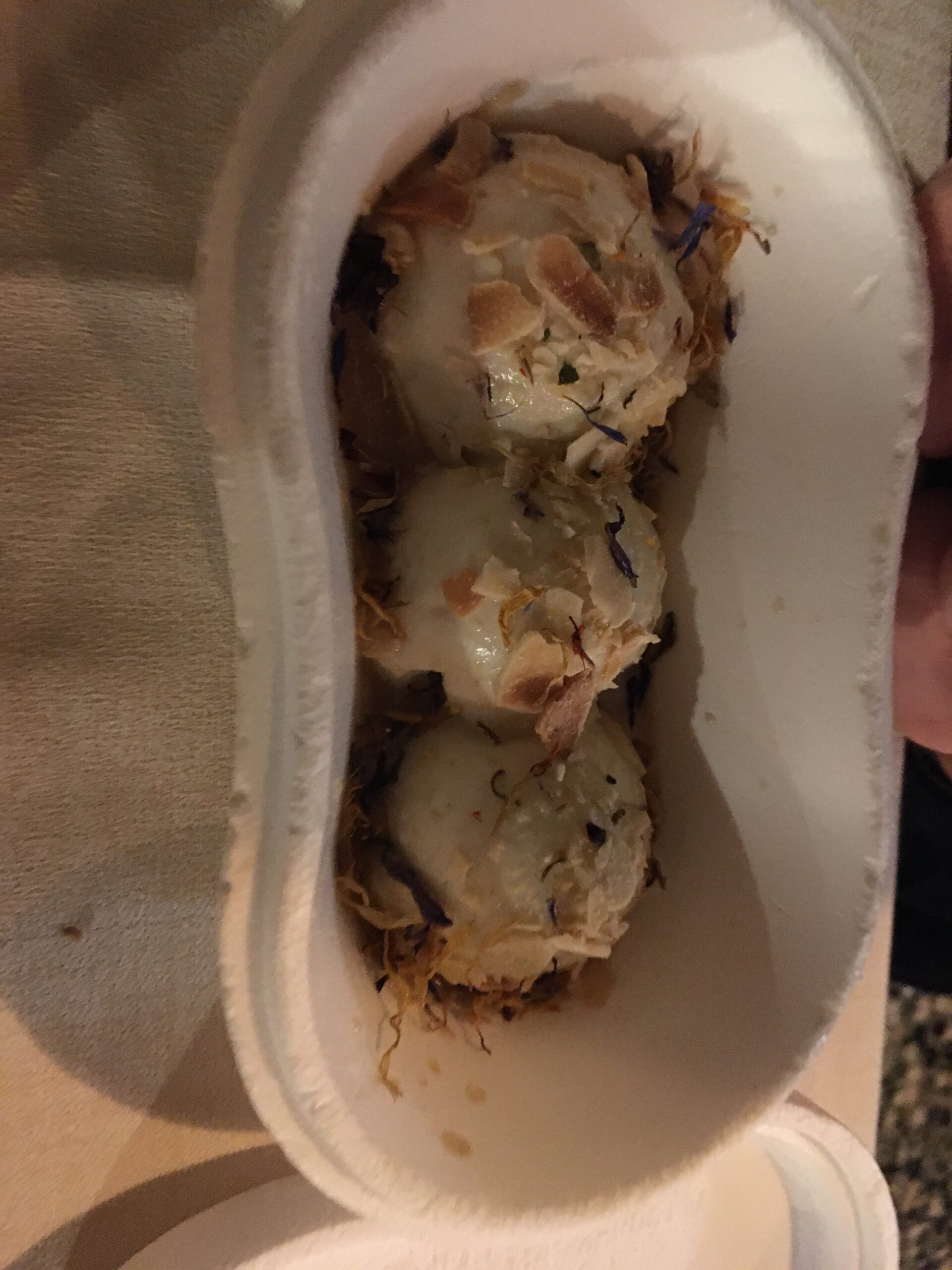 |
After the delicious dinner, we decided to have a walk along the canals, and here a bit of the magic faded, the small streets are really crowded and loud from the numerous bars with outside tables (full of slightly drunk young people), so you really need to rub your shoulders with the big groups of people switching bars, and if you are coming with your boyfriend/girlfriend you will be literally attacked by flower men, you are very determined to sell the couples their roses, even if you refuse, they put the rose on your shoulder or to your pocket saying it’s for free, and then running after you demanding money. I definitely don’t fall into this trap and allow my man to be intimated into buying, the roses are also quite frozen after many hours exposition to the cold, but the constant avoiding and refusing the flower men strips the walk around Navigli from any romanticism.
I recommend to get there just for your lunch/dinner, but if you like partying, then plan to stay there for longer for the vast offer of local bars.
Day 3
- Lake Como
4 full days in Milan allow to not only enjoy the city but also to discover other interesting places in the region during one day trips.
We have chosen to go to Lake Como, a convenient one hour trip from Milano Centrale railway station. The station which gets you the closest to Lake Como is San Giovanni, from were a short walk takes you to a small charming chic town Como–located just at the lake, the walk from the station to the lake will take you around 10 minutes.
Lake Como has been and still is a very popular retreat for aristocrats and wealthy people (since Roman times), and is very frequently visited by tourists attracted by rich offer of artistic and cultural gems. Along the lake you will find a lot of elegant villas and palaces such as Villa Olmo, Villa Serbelloni, and Villa Carlotta. Many celebrities have had and have homes on the shores of Lake Como (probably one of the most famous one is George Clooney with his villa Oleander–interestingly, available for rent though Airbnb!, the price is quite prohibitive though).
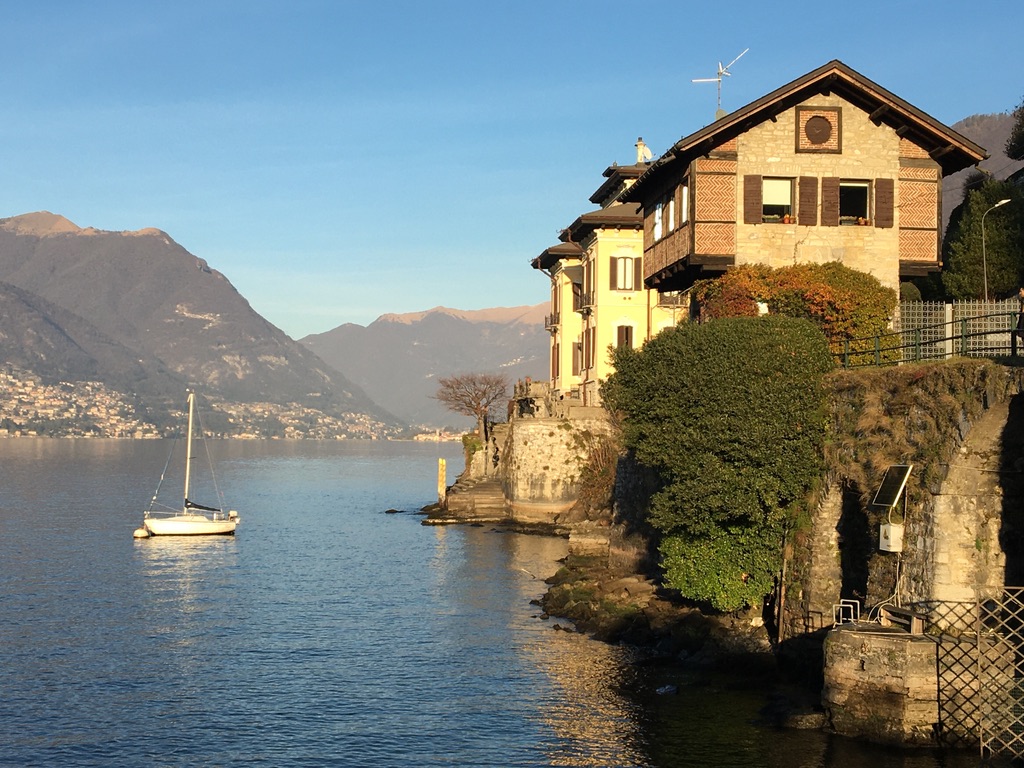 |
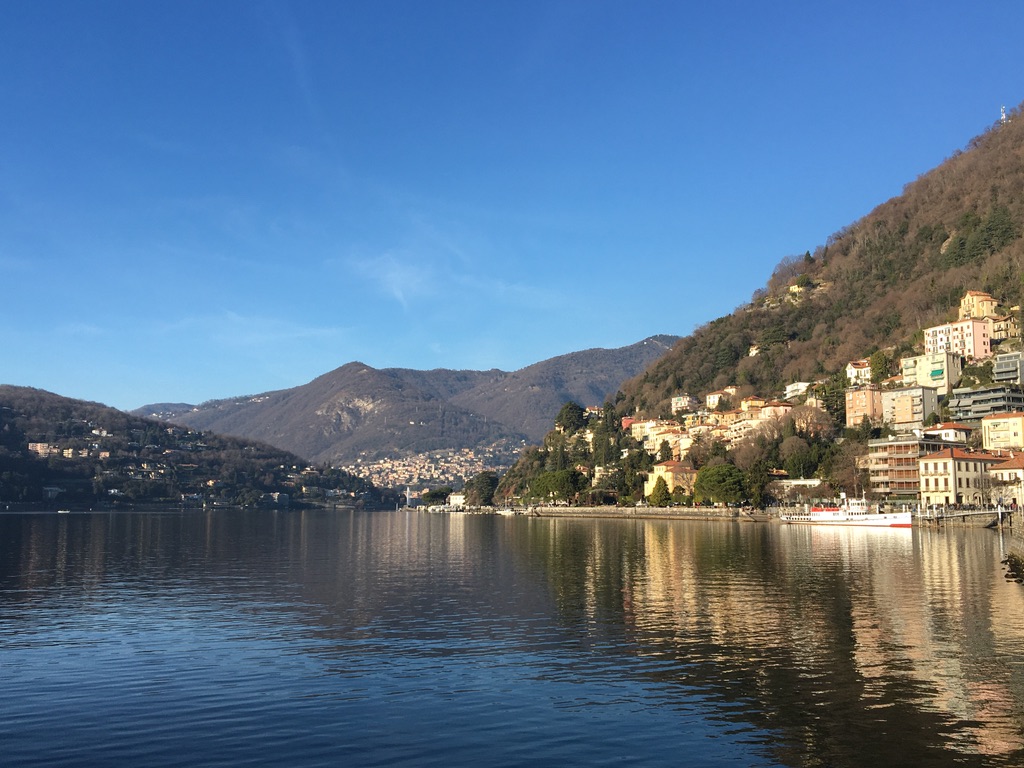 |
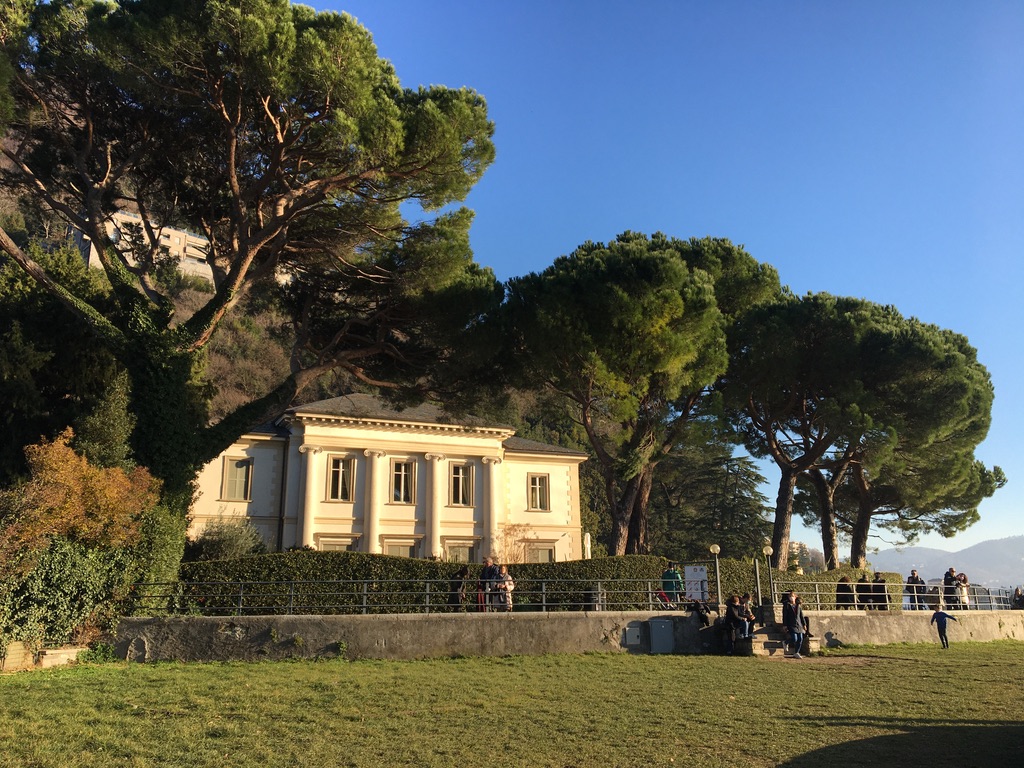 |
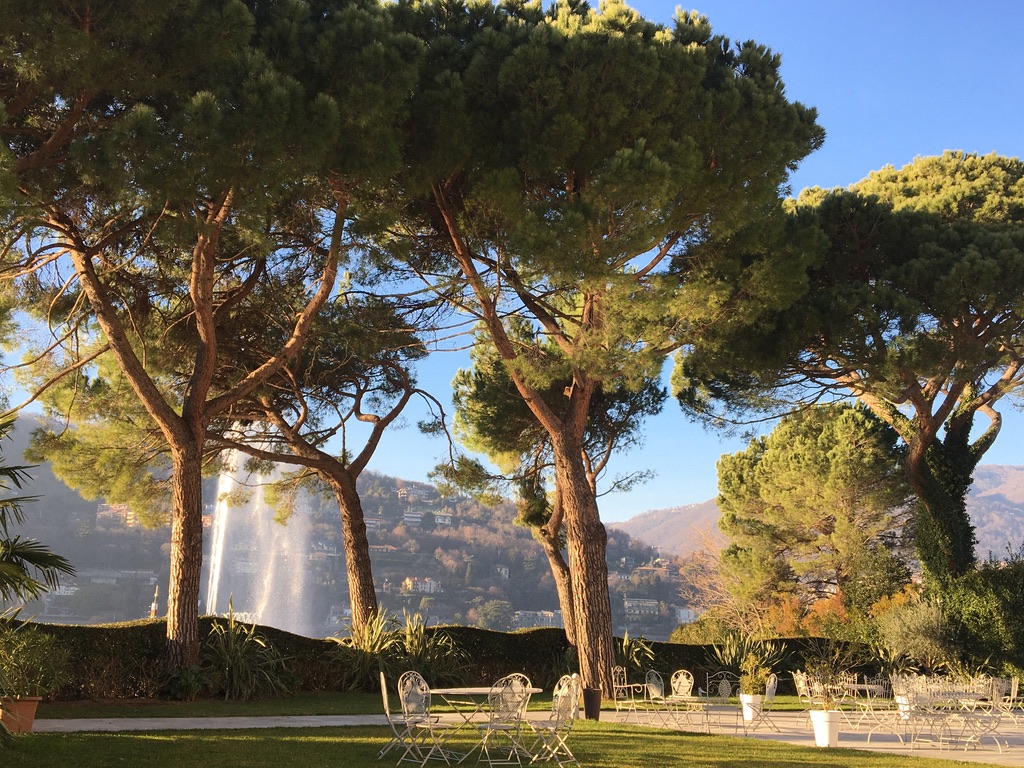 |
The luxurious houses of rich and famous are far away from Como town which can be widely accessed by tourists via direct train connections. However, you still can enjoy the dramatic scenery when walking the promenade along the lake, watching the stylish Italian villas set against the foothills of the Alps.
The small town of Como is also worth to look around, with its impressive Cathedral of Como, erected in the 14th century and featuring a Gothic design. The cathedral completed in the 18th century. The front façade amazes with a plethora of ornate stone work, stone statues and is topped with a series of small decorative towers.
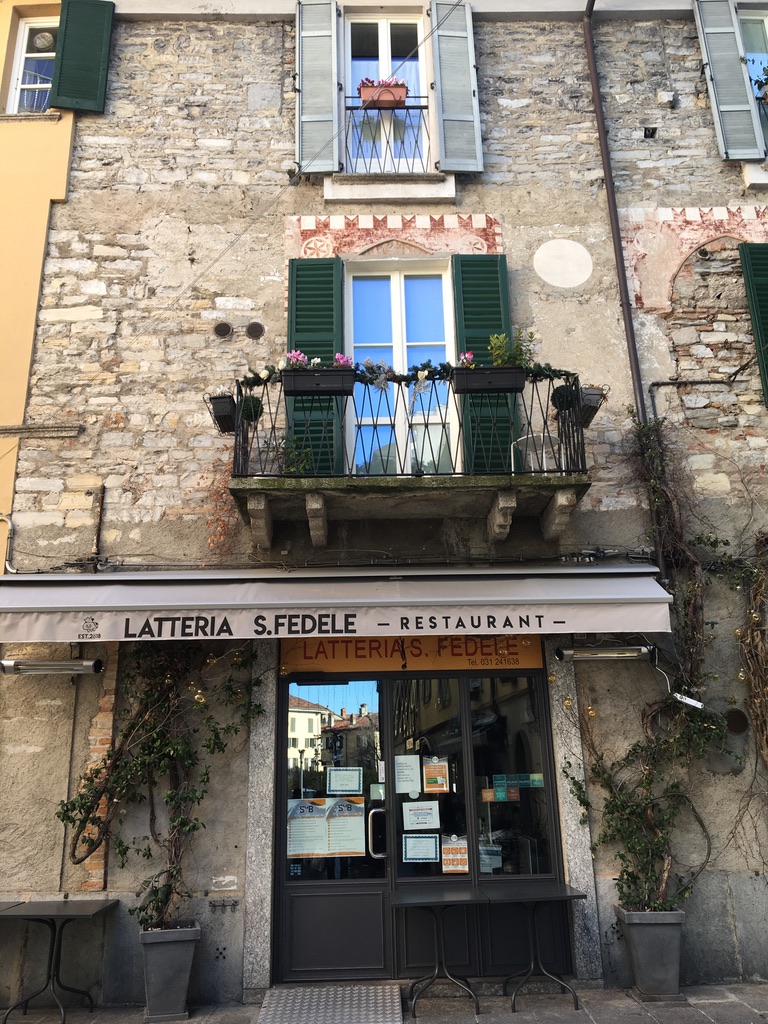 |
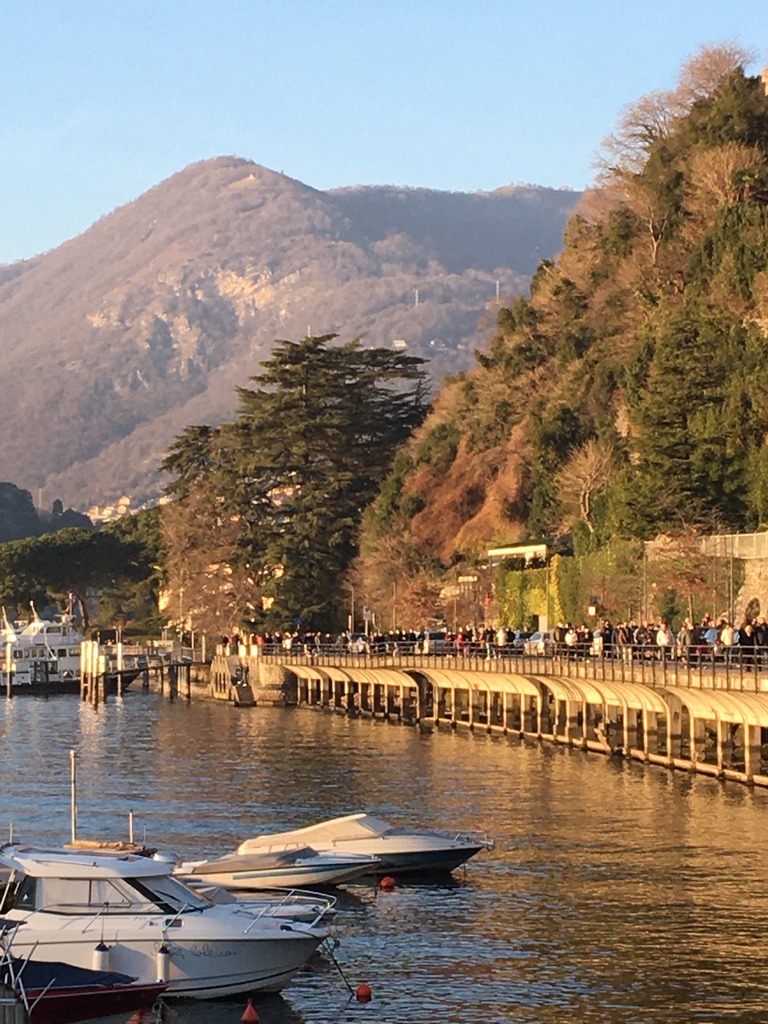 |
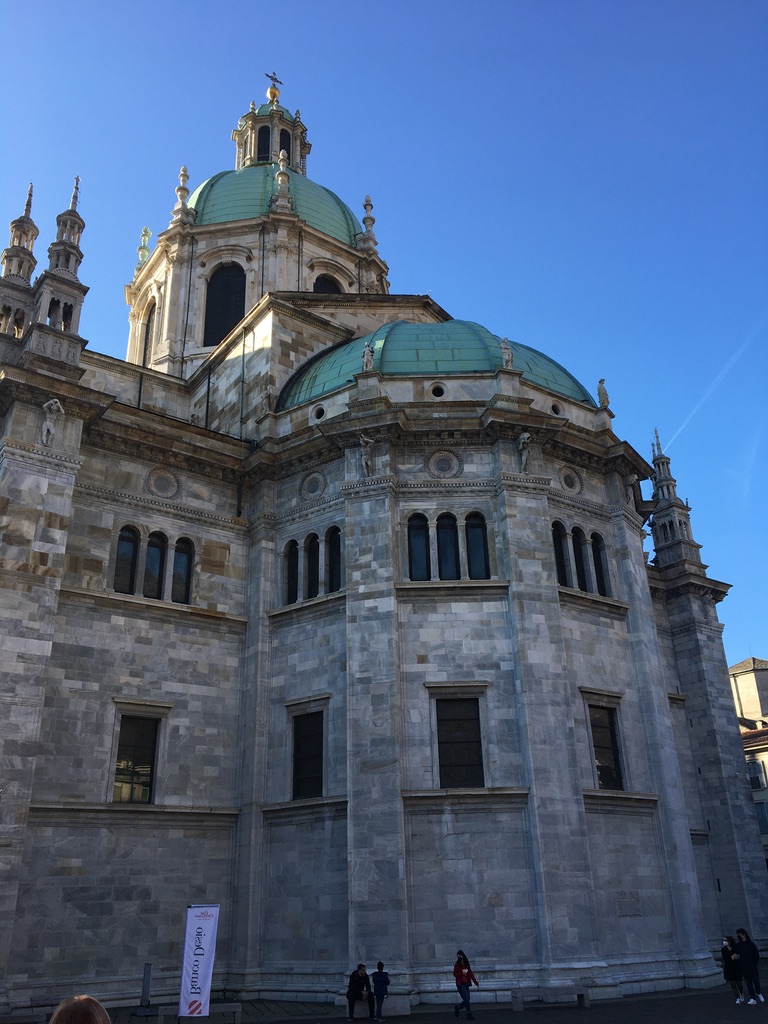 |
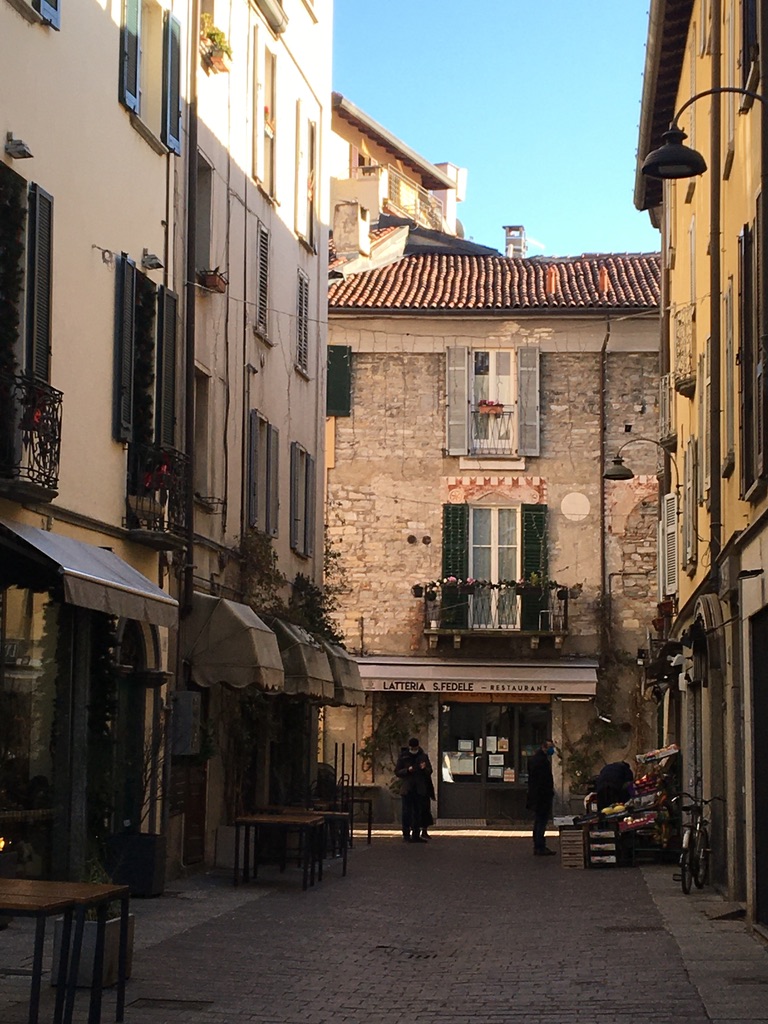 |
In the December/ January festive period, the façade of the cathedral is illuminated with Christmas light animations which in the evening transforms the square where the church is located in a dreamy winter fairly land. All around the church you will find Christmas market stands with Italian cheese and sausages among many other Italian food delicacies, there is also a lot of handcrafted items such as warm wool socks, caps and scarfs, leather goods among many other charming objects which will make a nice souvenir.
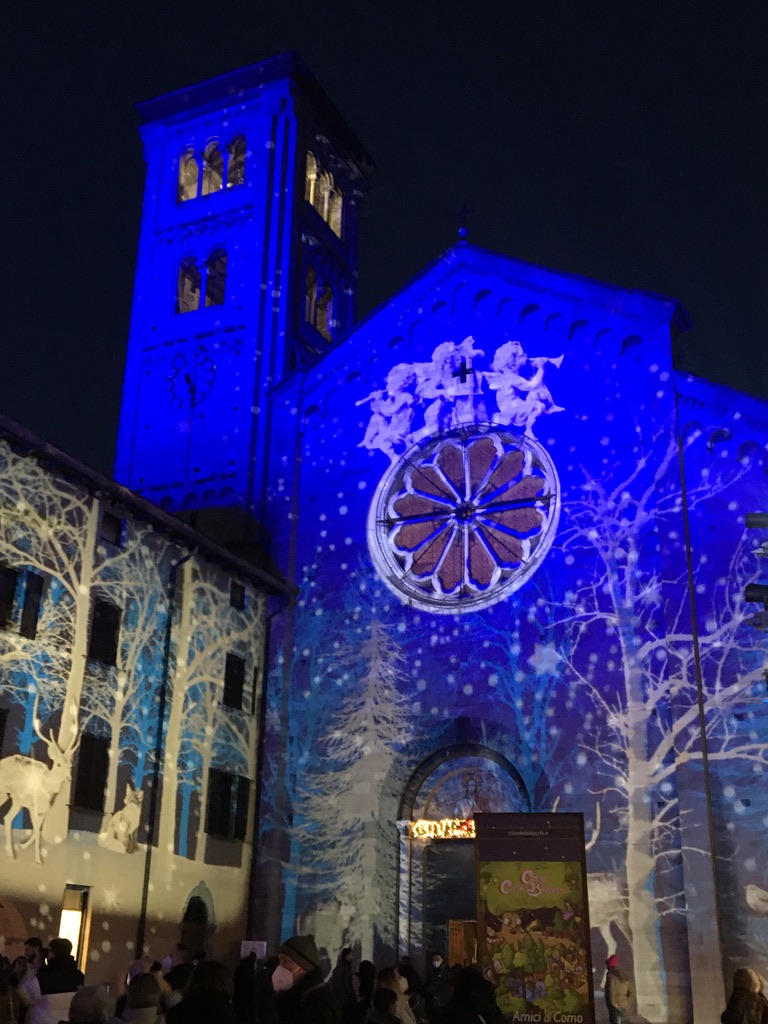 |
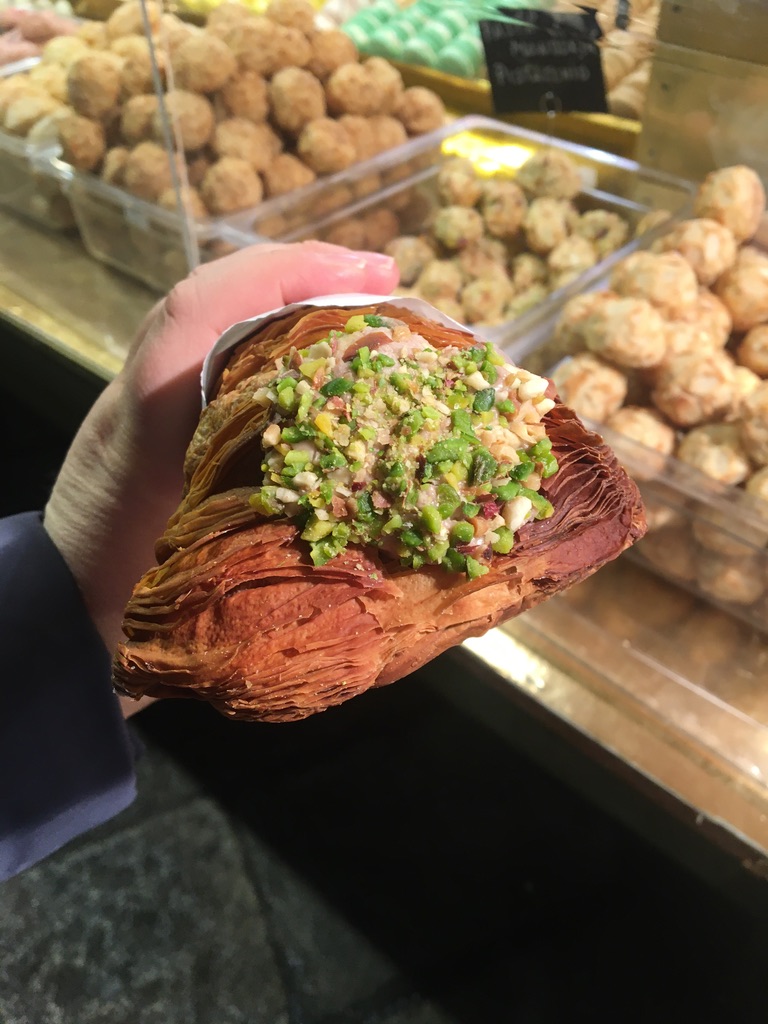 |
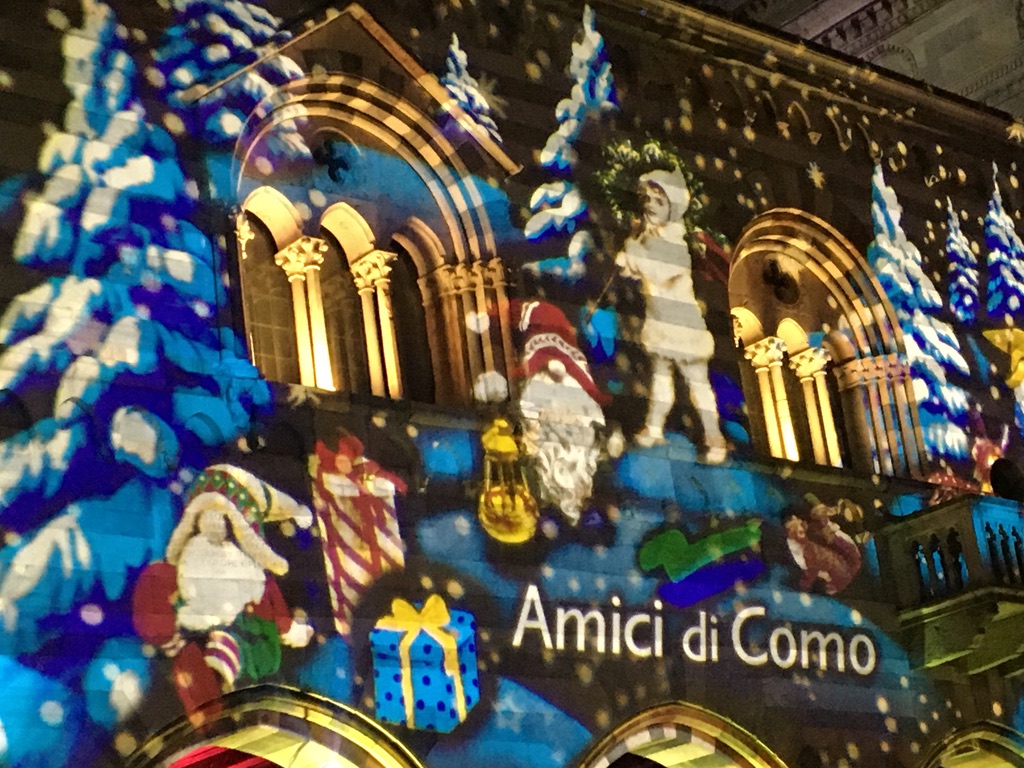 |
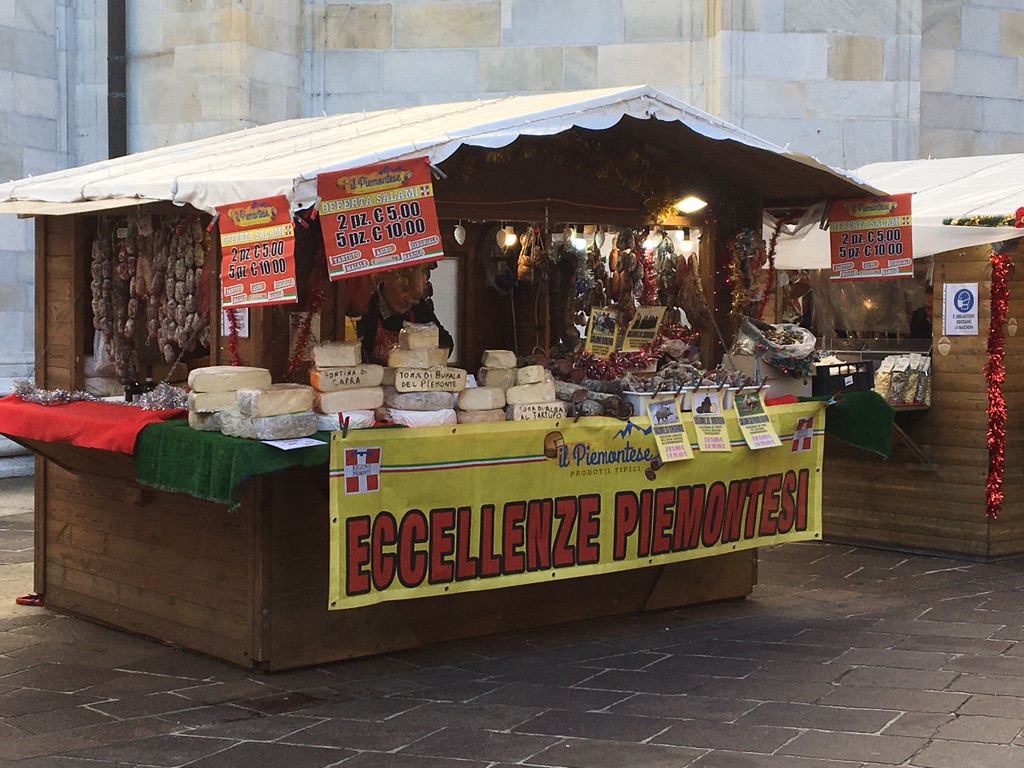 |
The charming Como town is very pleasant to just have a walk along its small narrow streets absorbing the relaxed Italian vibe and observing the stylish locals (and visitors) wondering around with their fashionably dressed dogs or sipping their expresso when reading a newspaper in one of many small enchanting cafes all around the town.
In case you are still thriving for museums after few days in Milan, you can visit Como Archeological Museum or Museo Storico Giuseppe Garibaldi (in a very chic villa with lavishly decorated rooms that have been restored to show traditional living from various eras in Italy).
Apparently very popular attraction (judging by a long queue) is furnicular up to Brunate ( a small town high up in the mountains surrounding Lake Como), with a dramatic views at the Lake Como and the villages around. We heard it’s best to get there to admire the sunset, but since the queue was very long, we realised there is no chance to get there before it will be completely dark.
Another interesting attraction is a boat ride along Lake Como. In the harbour attached to Como town you will find many companies offering different tours (but I have impression the offer is smaller than during summer months). You can opt for a tour which will take you to other coastal small towns like Bellagio and Cernobbio, or you can choose just the ride along the lake when you will enjoy the scenic landscapes surrounding the lake while your guide will provide you more information about the region and its historical landmarks.
Surprisingly, Como has a very diverse gastronomical offer tailored to every budget so we suggest to have a dinner here before your return to Milan.
Overall, you can have a very busy and intense day in Como, with the boat rides, museums, trip up to Brunate and many other attractions.
We opted for a calmer day, just with a walk on the promenade along the lake, taking our time to admire its scenic landscape, lavish Italian villas, and absorbing somewhat Mediterranean vibe of the region. Then we simply wandered among the narrow streets of Como town, stepping in to its churches, observing the locals and trying Italian delicacies on the Christmas market.
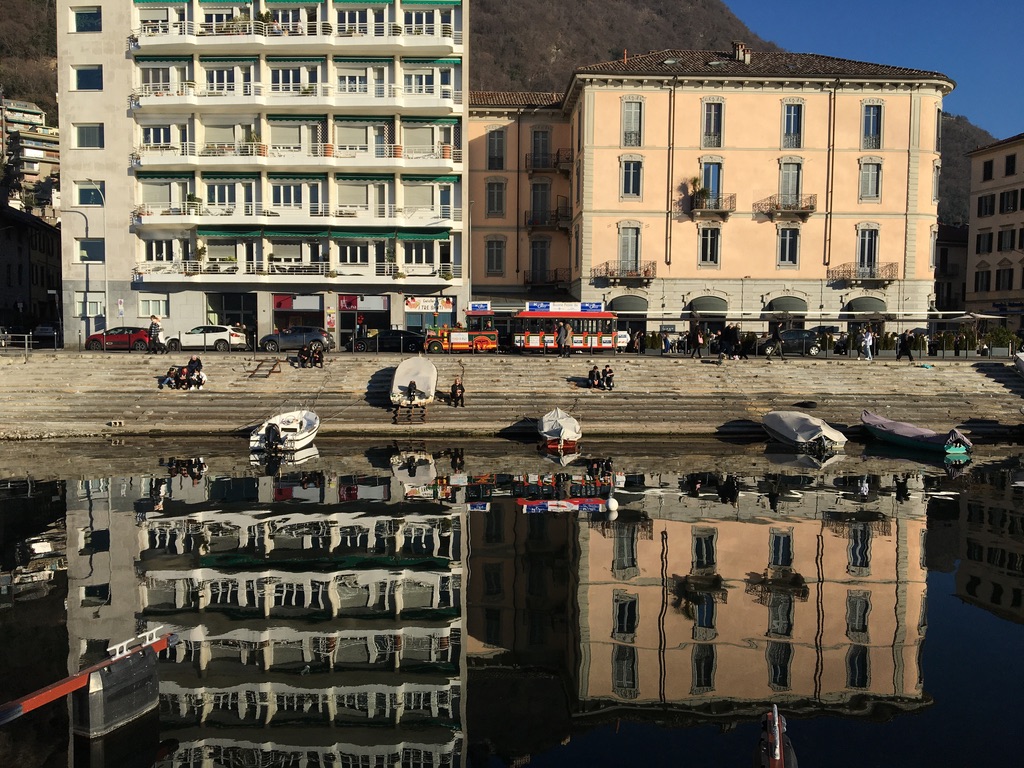 |
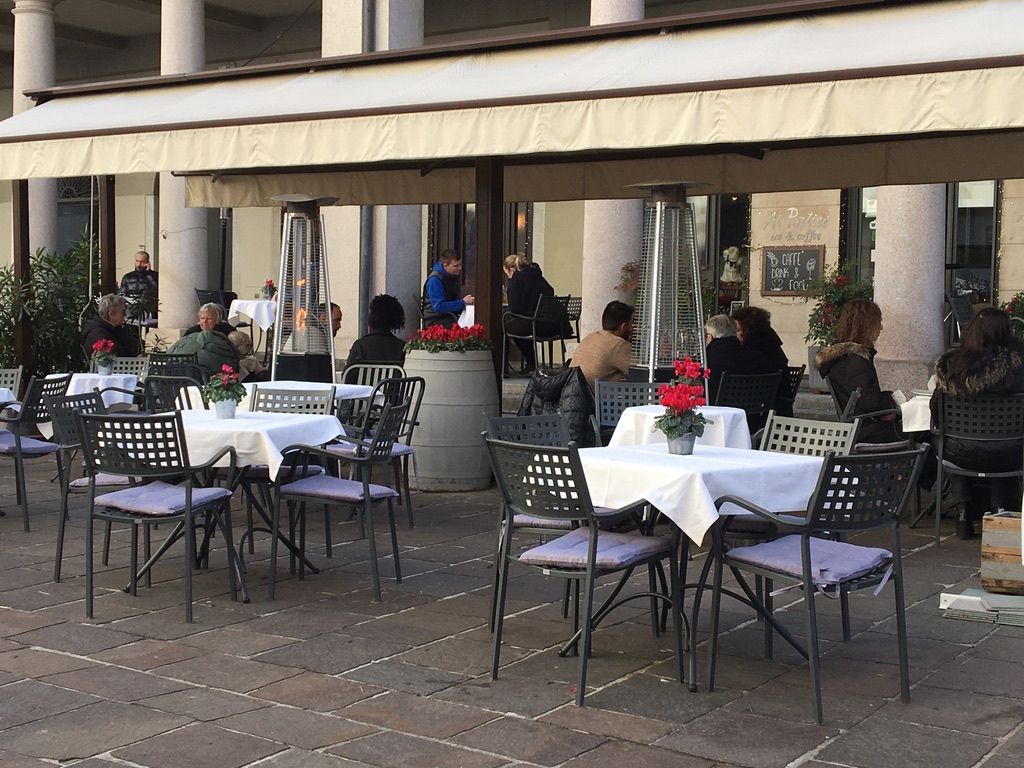 |
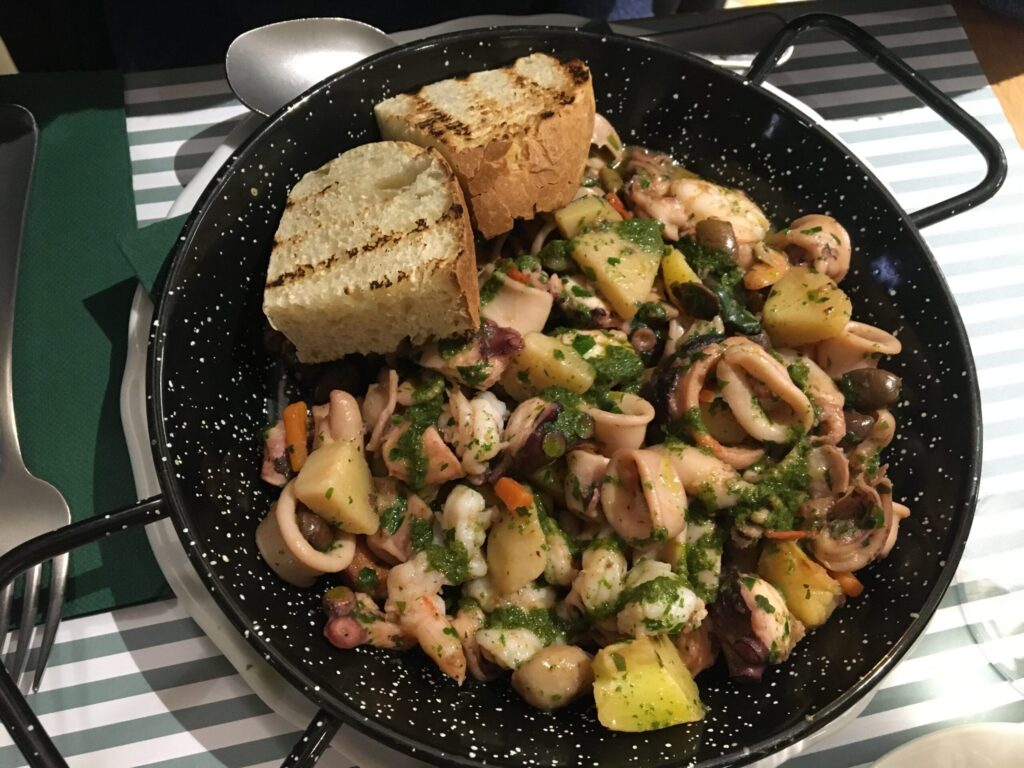 |
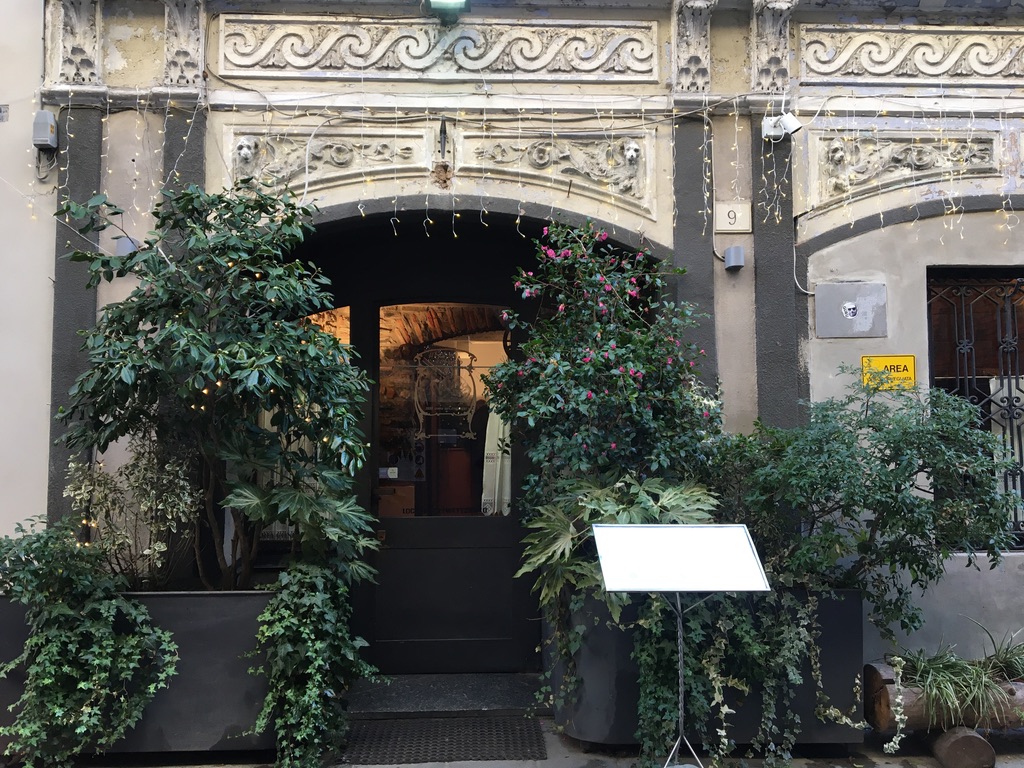 |
For sure you can make yourself busier if you like, it’s possible to spend your time very active, but also is a calm retreat for those who search for relax and tranquility.
Certainly, it’s possible to stay longer to discover Lake Como, you have interesting towns and landmarks all along its coast, in the summer one can enjoy few of the beaches attached to the lake (even if Lake Como is not really a beach destination).
- Daily trips from Milan
We have chosen to go to Lake Como for a day, because we were curious of that place, but Milan is very well connected with many other interesting cities and sites. Below we provide you with few other suggestions for a day trip:
- Venice (2,5 hours by train)
- Florence (2 hours by train)
- Turin (1 hour 25 minutes by train)
- Lake Maggiore (1 hour 25 minutes by train)
- Verona (1 hour 50 minutes)
Italy has really fast and reliable train network and travelling between the cities is really a pleasure so if you are in Italy for longer time, this is a really good way to move around the country.
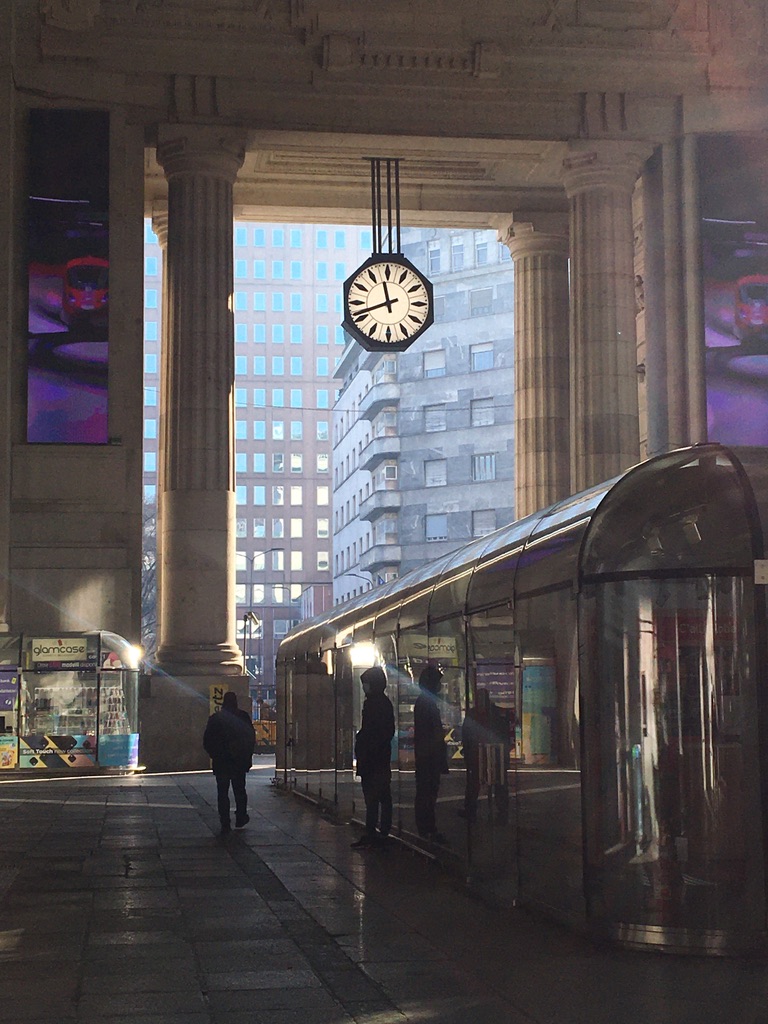 |
Day 4
- Leonardo da Vinci’s Last Supper
The highlight of our last day was admiring the Last Supper–a famous fresco by Leonardo da Vinci. Last Supper is undoubtedly one of the most famous masterpieces in the world, created by Leonardo probably between 1495 and 1498 for the Dominican monastery Santa Maria delle Grazie. Famous fresco depicts the dramatic scene of final meal that, in the Gospel accounts, Jesus shared with his apostles in Jerusalem before his crucifixion.
Leonardo’s Last Supper is found in its original place, on the wall of the dining room of the former Dominican convent of Santa Maria delle Grazie, exactly in the refectory of the convent. Leonardo Da Vinci’s masterpiece is a huge fresco of 4.60 meters high and 8.80 meters wide. It was made with tempera and oil on a gypsum preparation instead of the technique commonly used in the fresco period. Several initiatives have now been taken to protect the paint from deterioration. One of the measures is to keep the painting in a room temperature, since the last restoration, and to maintain it, the visitor’s’ entry has been restricted to a group of 30 people every 15 minutes. This restriction means that the number of daily visits is seriously limited with the tickets being sold out even few weeks in advance.
Thus, if you want to see Last Supper, I strongly recommend to book your tickets as soon as you know the exact dates of your trip. You can do it through the official website (click here). When you have your reservation conformation on your email, you need to come 15 minutes before your time slot to exchange your voucher for a real ticket. You will need to show your identity card for a verification. When you retrieve your ticket you can enter the convent with a fresco 6 minutes before your time slot (the yellow building). During this time you will be waiting in a corridor with a small exhibition about the history of the painting, the fresco is separated from the corridor by automatic door which will open exactly at the beginning of the time slot.
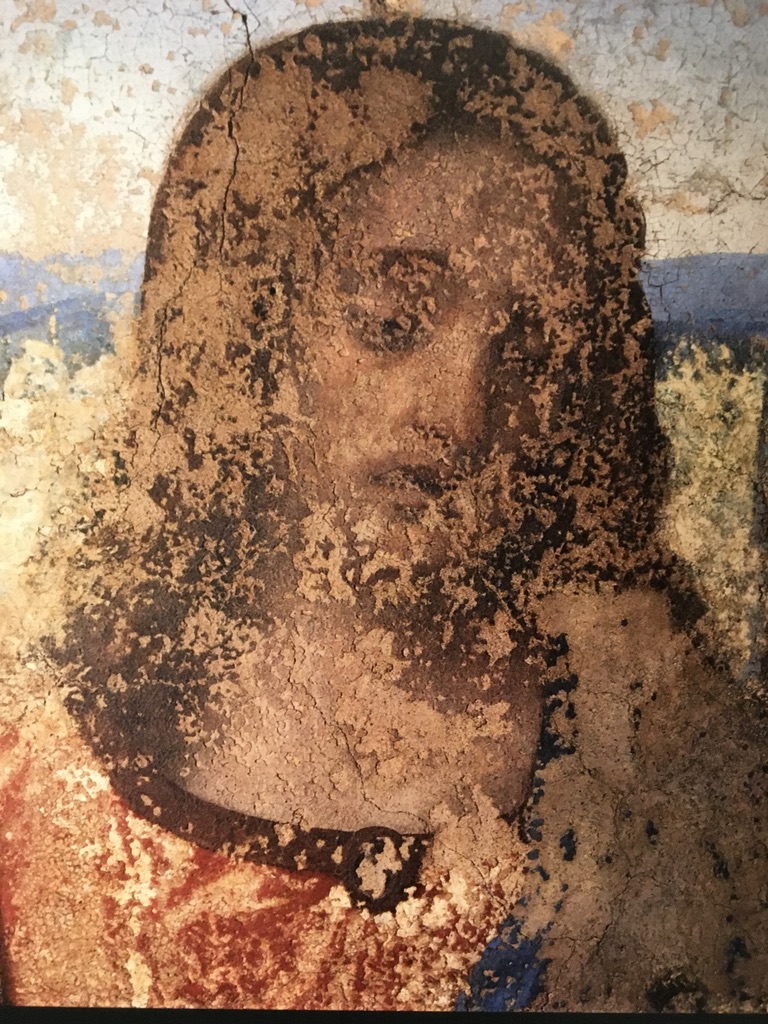 |
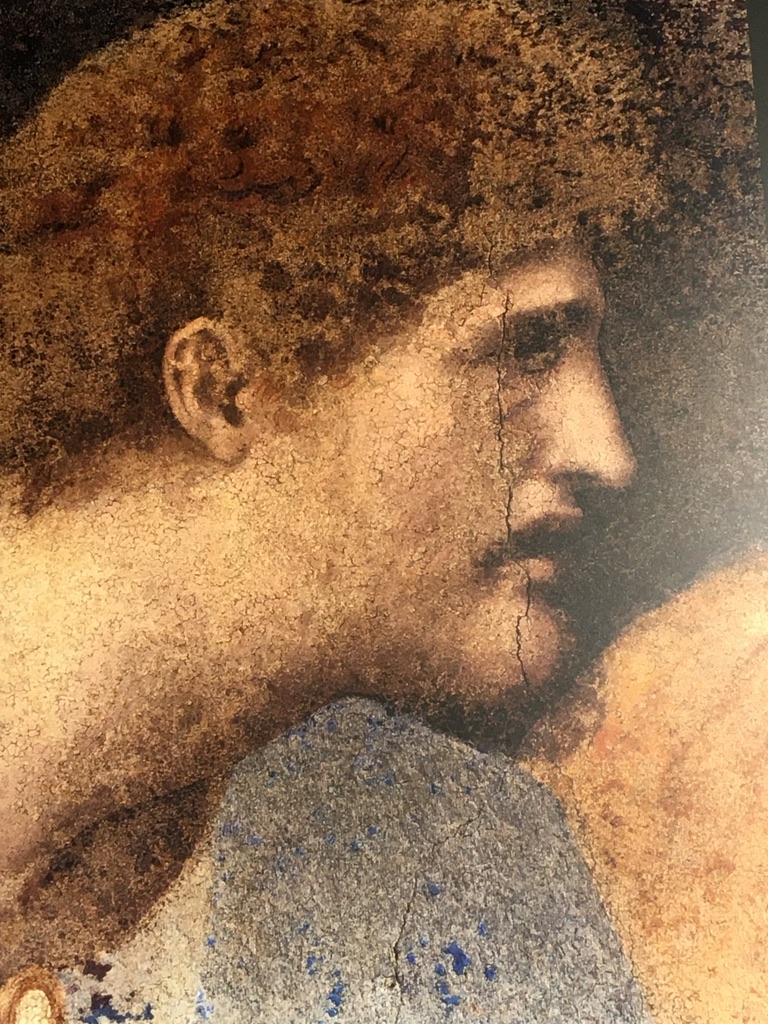 |
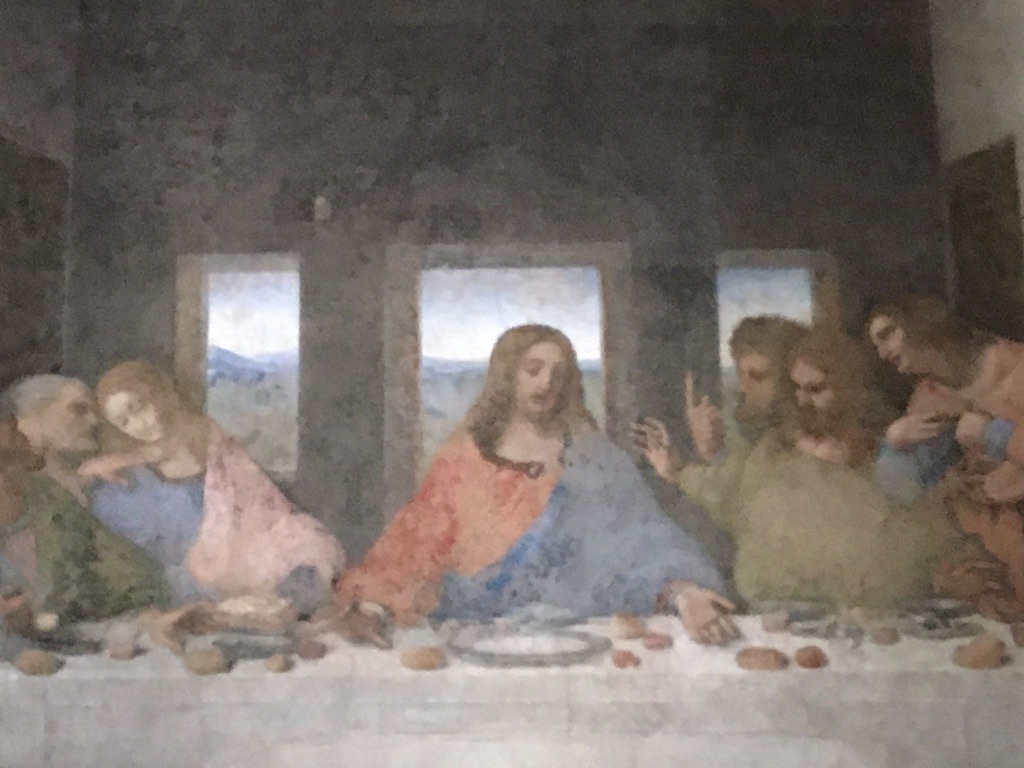 |
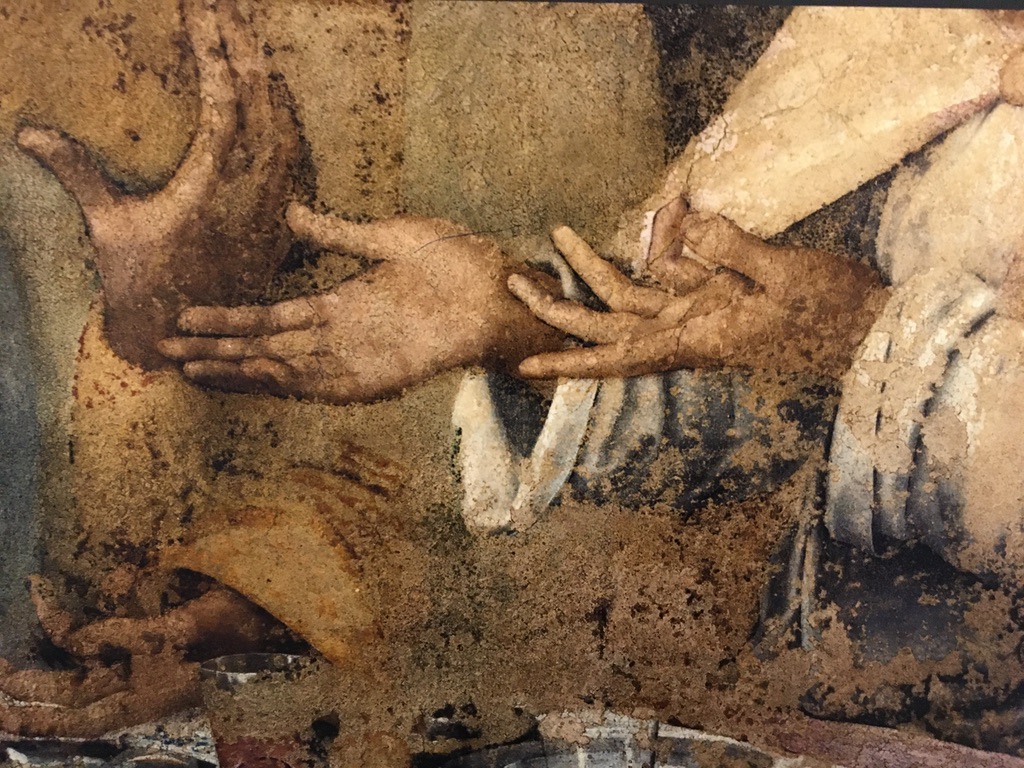 |
Then you can enter a quite big room with a fresco painted on one of the walls. You can take pictures with flash during your visit. After 15 minutes the automatic door at the other side of the room are open and you are invited to leave to make space for the next group. You will go through another corridor with exhibition about restoration works of Last Supper. At the end you can go to a small boutique selling souvenirs related to Leonardo and his works.
Attention: When entering the building with Last Supper, you need to leave all your personal belonging in the storage room attached to ticket office. Thus, if you plan to make some purchases in the souvenir shop, make sure to take with you a wallet/credit card.
With your mind set on Last Supper, don’t forget to pay a short visit of the church Santa Maria delle Grazie just on the right to the entrance to Last Supper, it’s free of charge, and the church’s interior is very impressive.
• Castello Sforesco
Our next stop was famous Sforza castle, an imposing symbol of Milan under the Sforza dynasty and one of the most monumental vestige of the city’s ancient past defense system. The original core was built by Galeazzo II Visconti between 1358 and 1368 and was enlarged in the 14th and 15th centuries. In the 15th century the castle was rebuilt as a square fortress with four towers at the corners and became a ducal residence of Gian Galeazzo Sforza, and Ludovico il Moro. Leading artists of the time such as Bramante and Leonardo da Vinci worked on the main parts of the castle including Piazza d’Armi, the Ducal Courtyard, the Rocchetta and the Ponticella. Nowadays, the castle complex houses the Civic Museums. The castle courtyards and outdoors area are open for visitors free of charge, but you need to buy the ticket to get to the museums located inside of the castle.
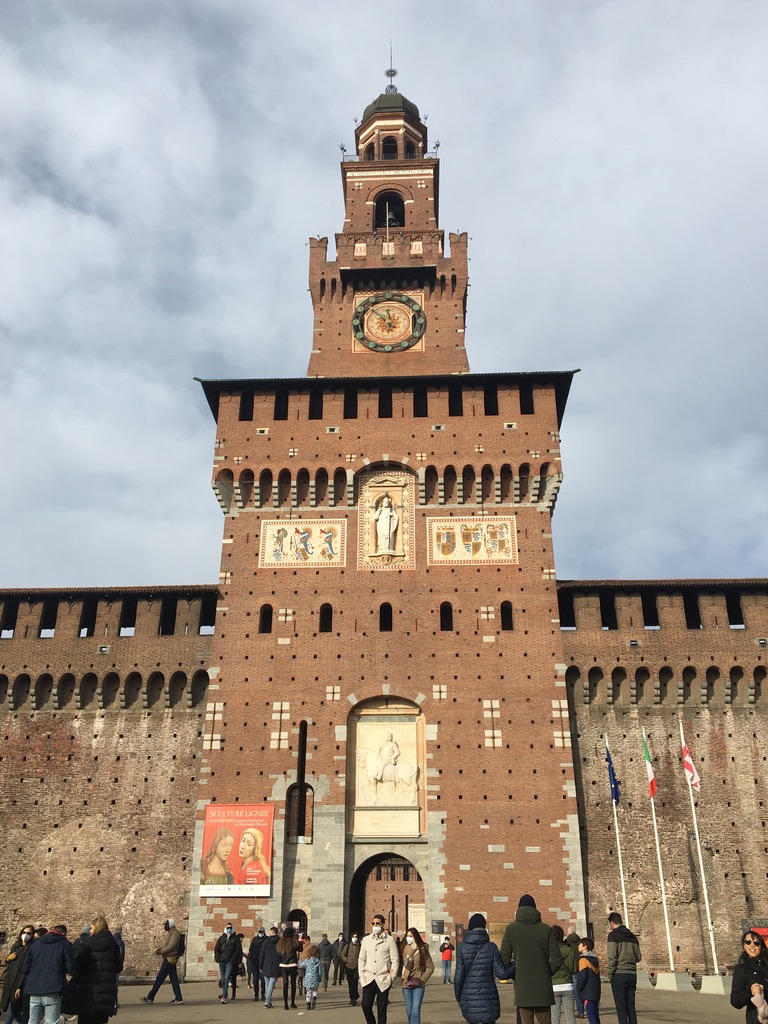 |
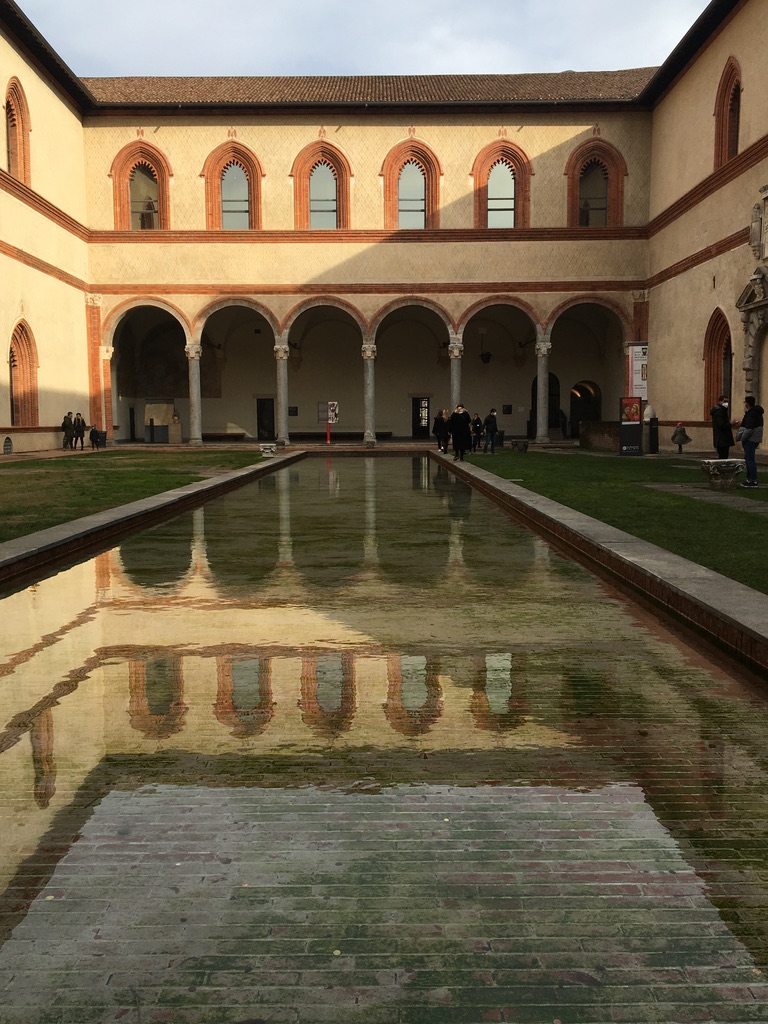 |
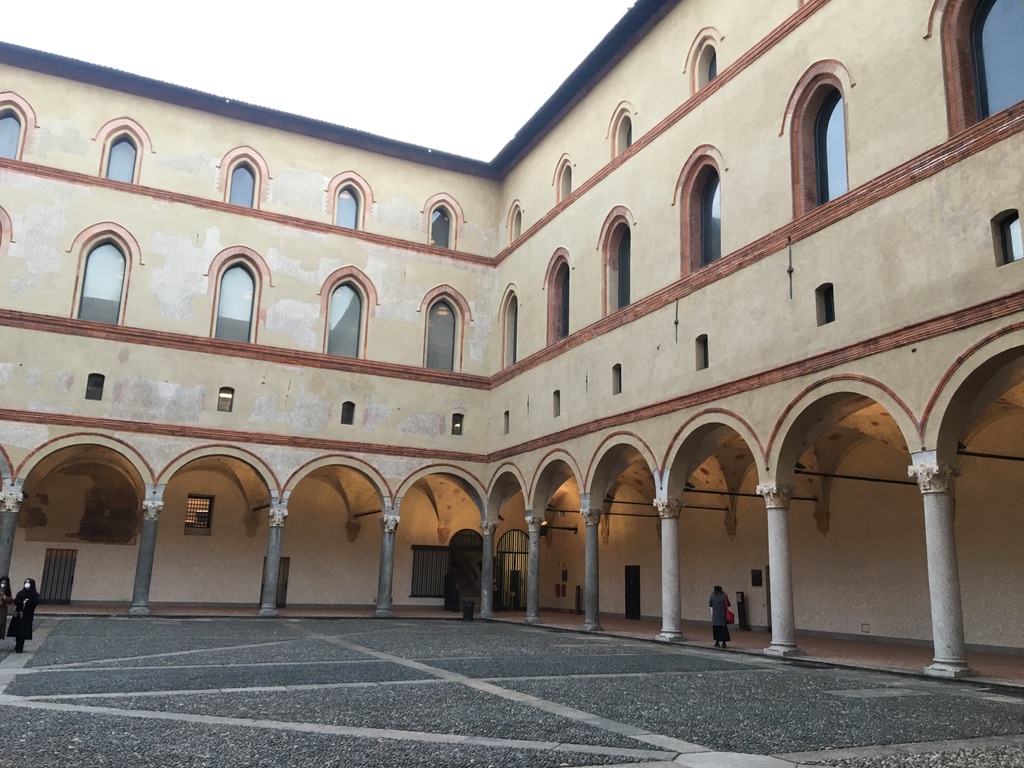 |
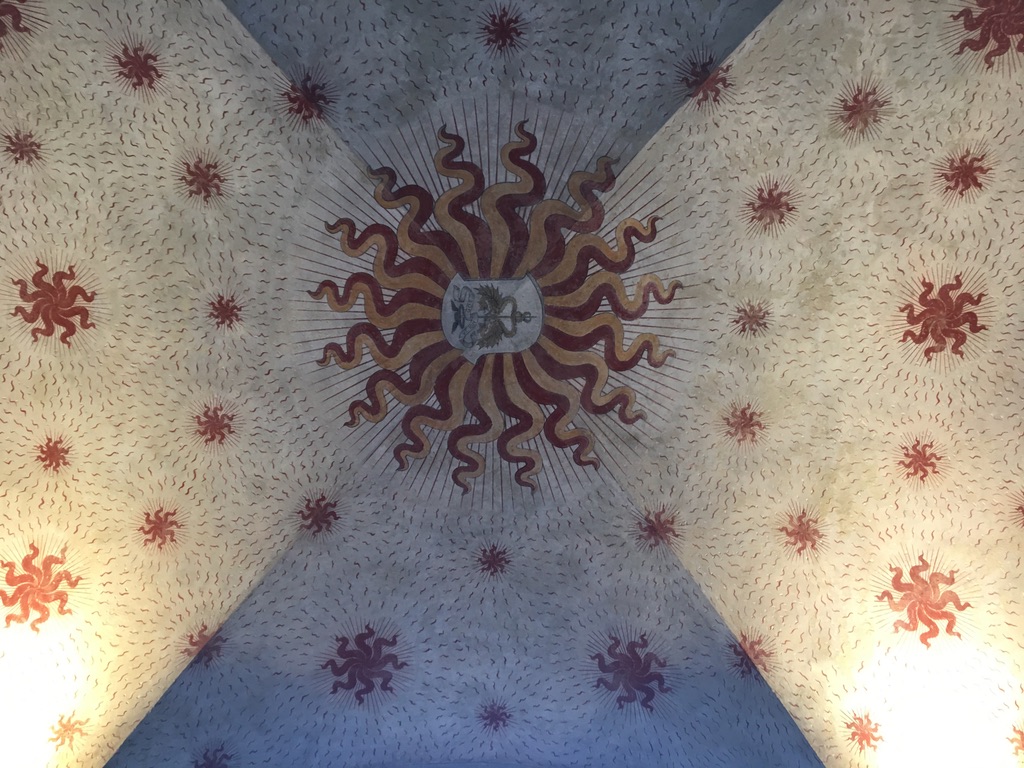 |
We decided to buy the ticket since we wanted to visit the Museum of the Rondanini Pietà which includes Michelangelo’s last sculpture (the Rondanini Pietà), the Pinacoteca del Castello Sforzesco with an impressive art collection including Andrea Mantegna’s Trivulzio Madonna and masterpieces by Canaletto, Tiepolo, Vincenzo Foppa, Titian and Tintoretto. Our third site we wanted to visit was Biblioteca Trivulziana which has a manuscript by Leonardo da Vinci, the Codex Trivulzianus.
I won’t hide it, while the castle grounds (free to enter) are very impressive, the Civic Museums were rather disappointing. We managed to see Pietà sculpture, but the Biblioteca Trivulziana is open for visitors on special appointments only and Pinacoteca was closed without known reason to us. Some of other museums were also closed for renovation. Maybe we were unlucky, but our visit to the site was much shorter than expected and we really were disappointed that the most precious parts of the exhibitions were not possible to see.
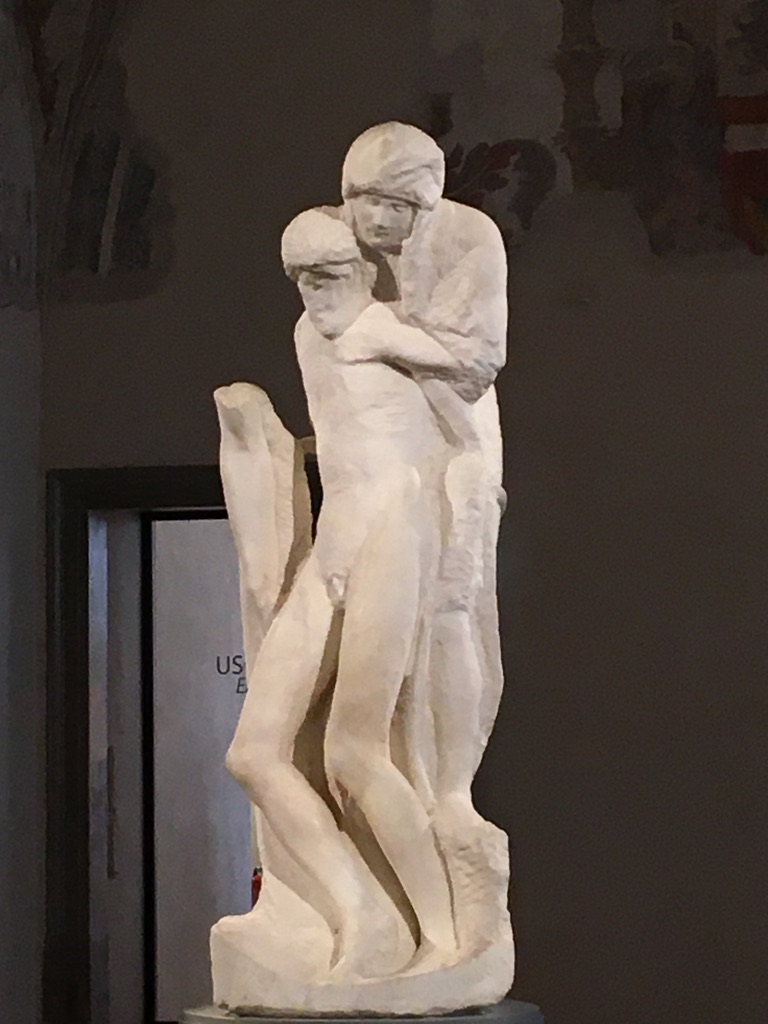 |
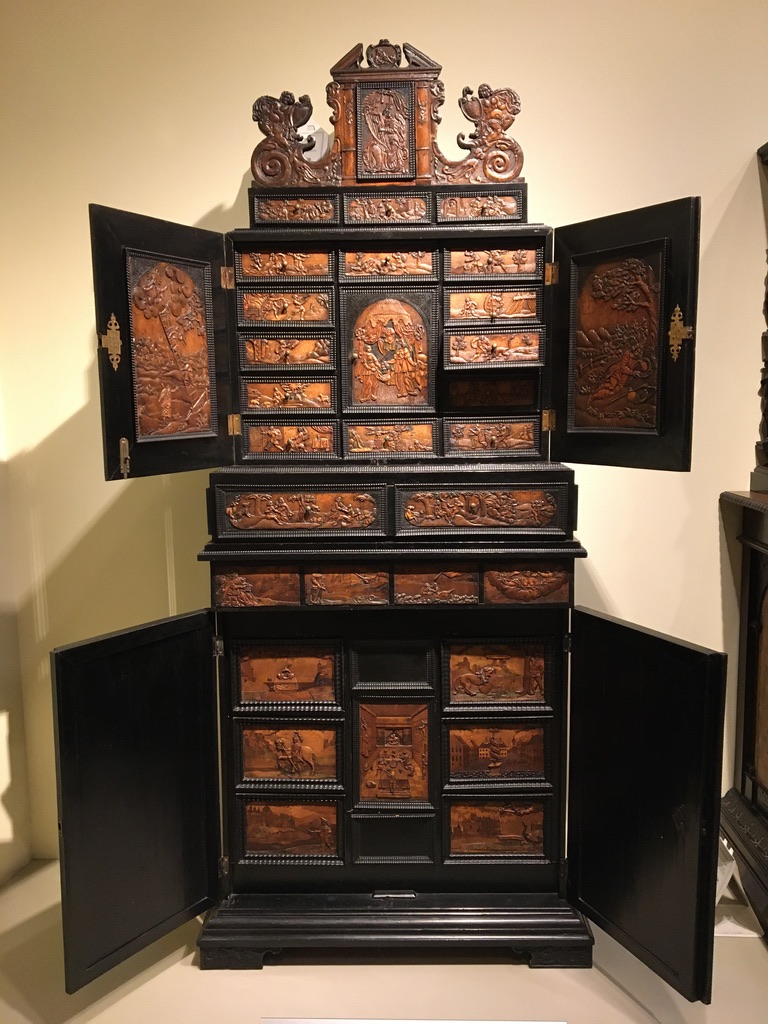 |
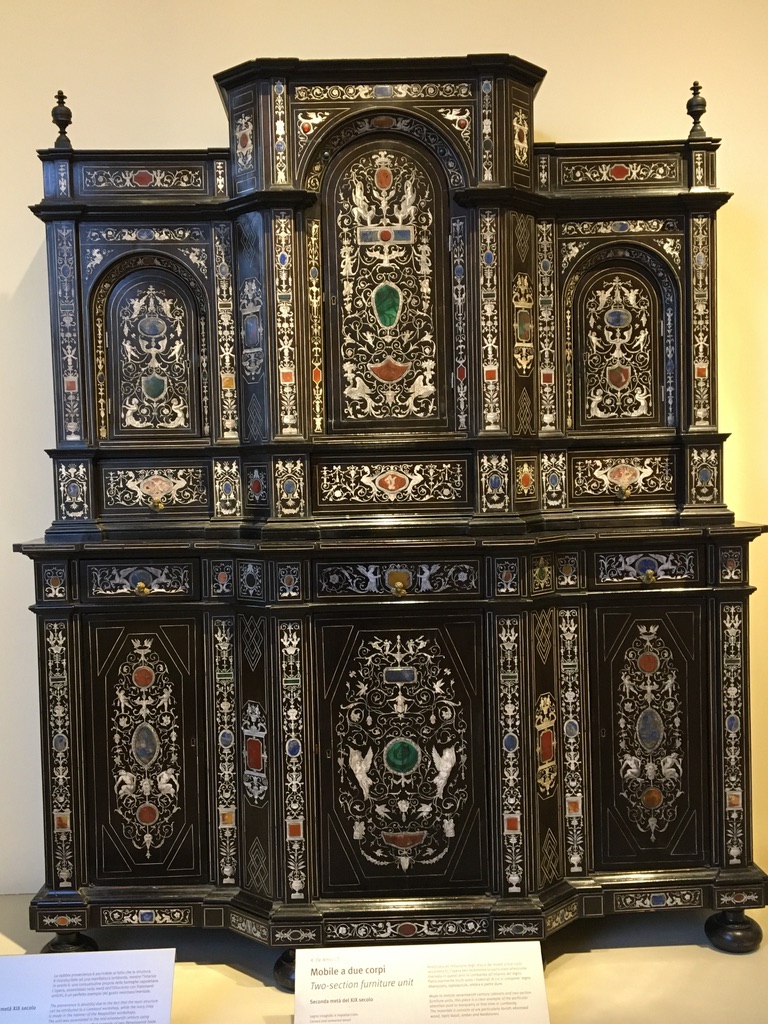 |
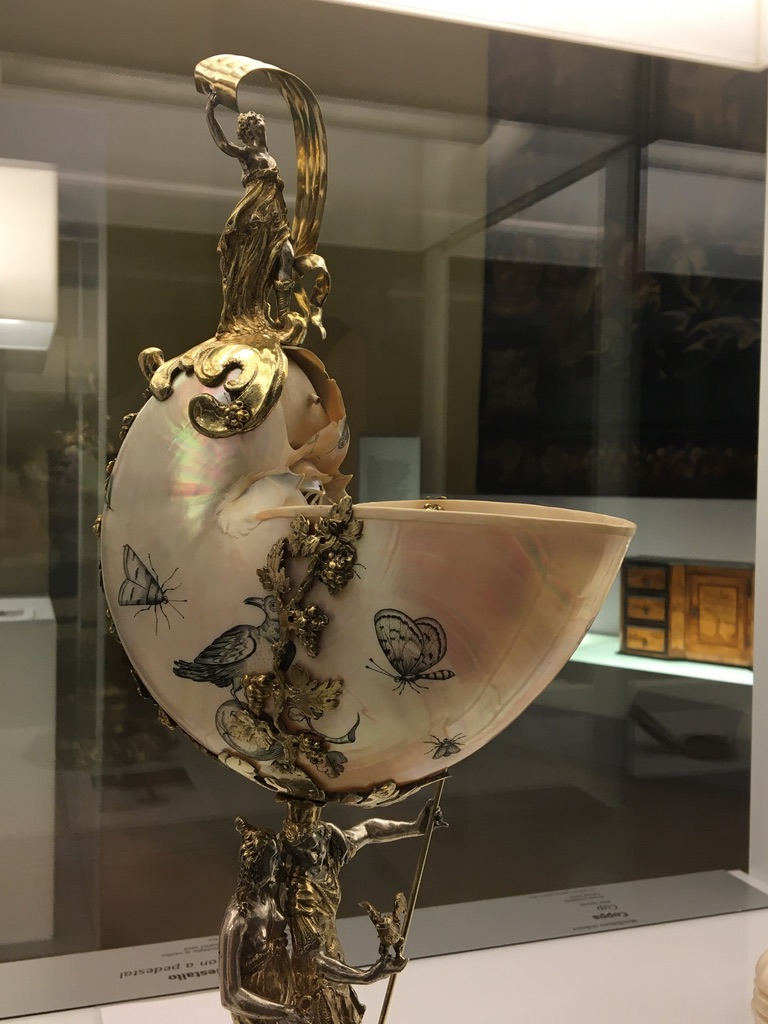 |
I really recommend to check which museums are closed for renovation before planning your visit and which parts are open only when the appointments are requested. Or just don’t bother, and see the exterior of the castle which is very stunning.
- Museo Nazionale della Scienza e della Tecnologia Leonardo da Vinci
Disappointed that we couldn’t see the manuscript by Leonardo da Vinci, the Codex Trivulzianus, we spontaneously decided to go to Museo Nazionale della Scienza e della Tecnologia Leonardo da Vinci to see Leonardo da Vinci Galleries and advertised by the museum as the largest permanent exhibition in the world dedicated to Leonardo da Vinci engineer and humanist.
The exhibition is not having original works or manuscripts of Leonardo but have models of his construction projects (including helical aerial screw, parachute or flying machines) plus copies of Leonardo’s manuscripts and works of the talented people living in his time.
The exhibition takes one floor, but there is a lot of digital animations and one gets through it rather quickly.
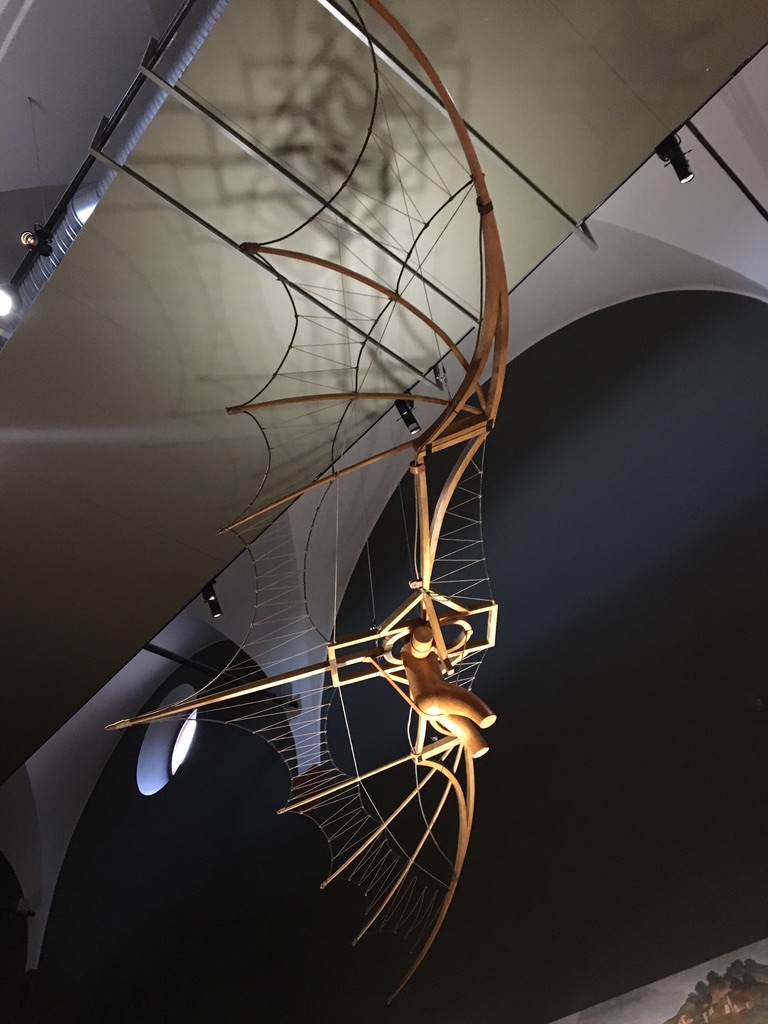 |
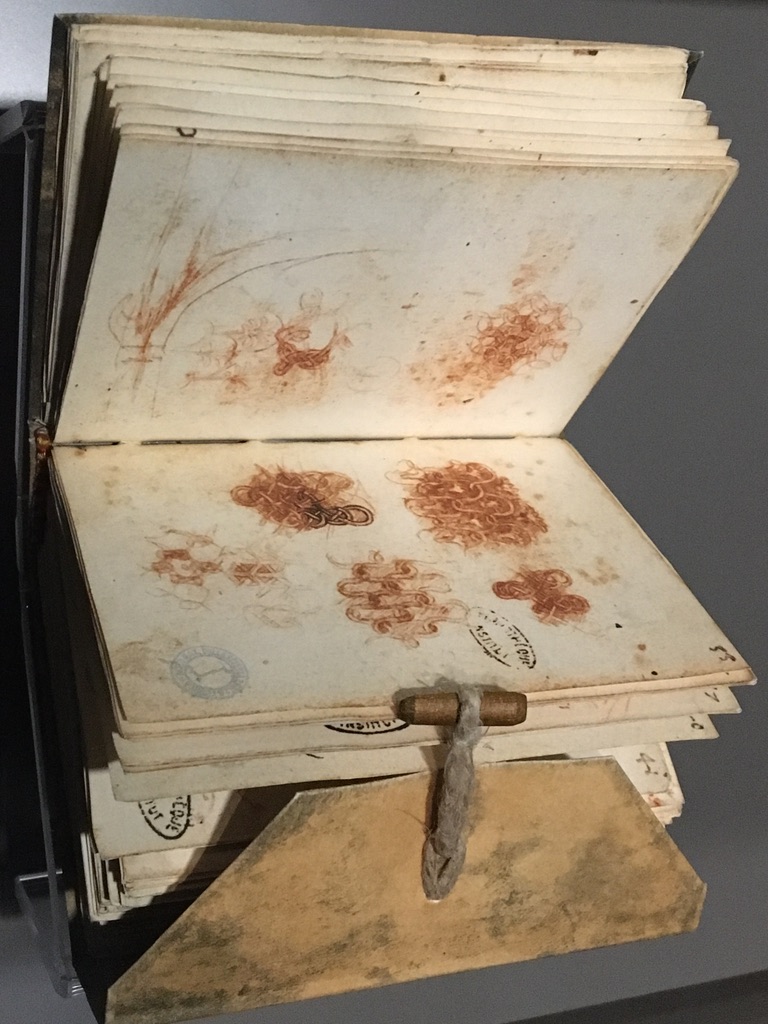 |
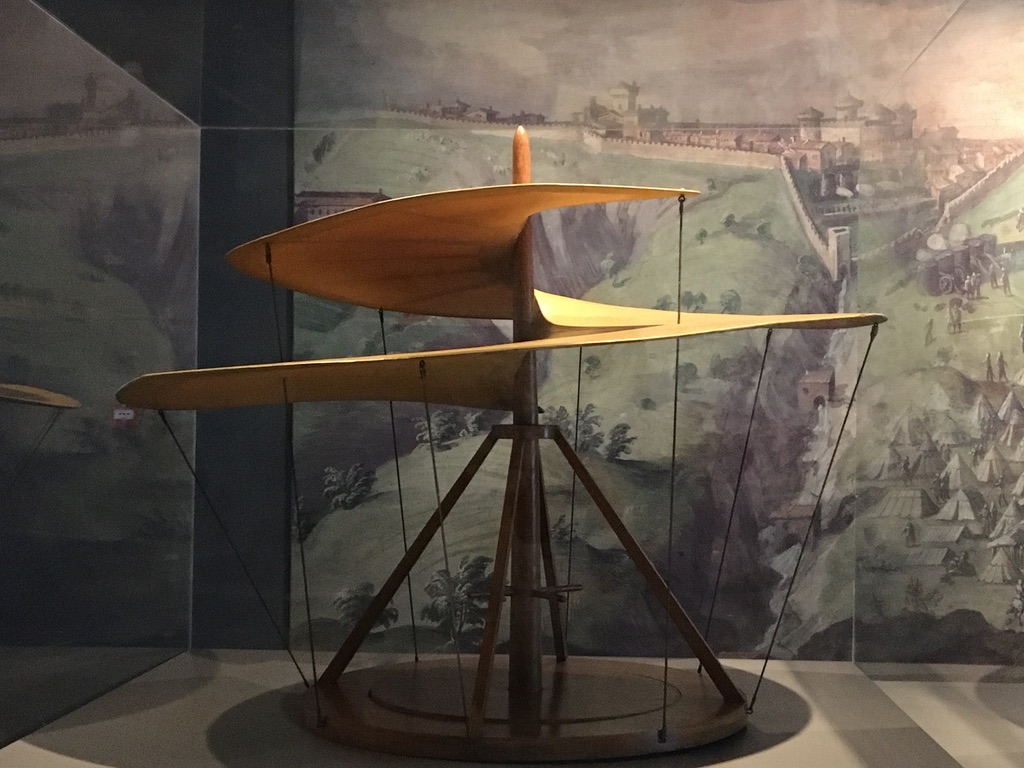 |
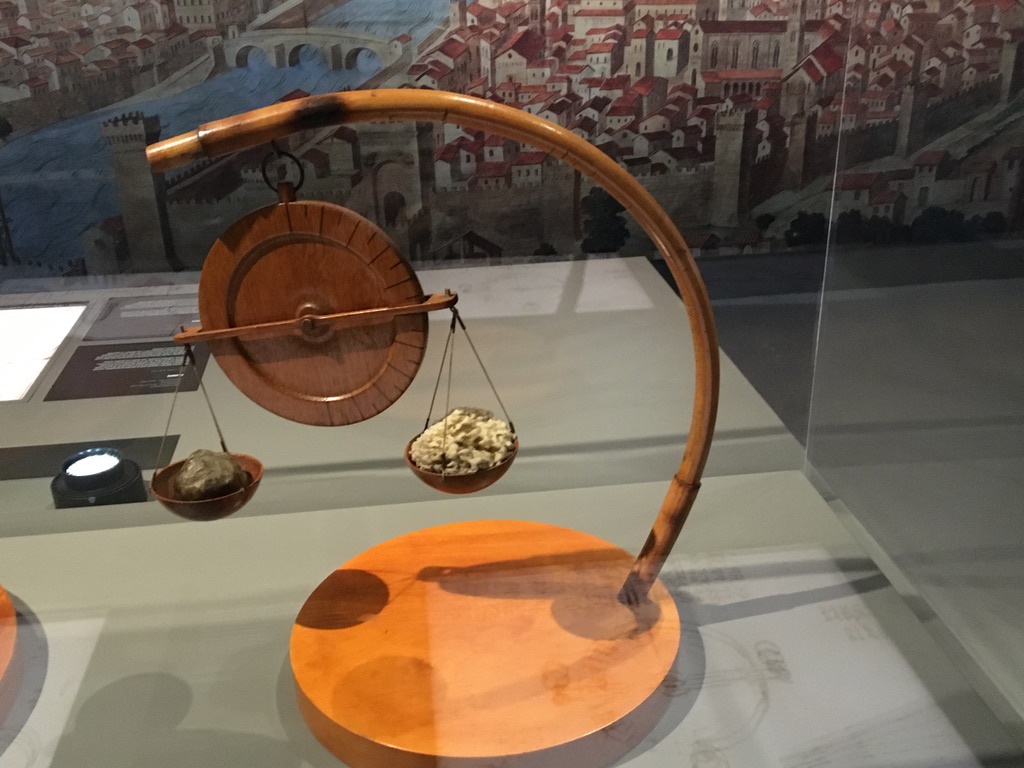 |
The museum itself is rather big, and if you are fan of science and technological advancements you will find here plenty of information about developments in telecommunication, transport, aviation, etc. I have impression that the exhibitions are really children friendly and the museum is best suited for family visits.
In my opinion, if you don’t have much time in Milan, it’s better to skip this place since many cities have such museums, and in my case, I have a very big center about science and technology in Paris, so I can always visit it there.
- Milan’s business district
With the legendary Milan’s prosperity and wealth, it’s very natural to see the place where the money coming from all the fashion and design businesses are handled. The business district is located close to Garibaldi railway station and in my view it’s rather small.
In December and beginning of January, its main square hosts mid-size Christmas market where you can observe plenty of fashionable locals and their even more fashionable dogs.
What I really like about this place is that there is a mid-size parc around it and the living apartments nearby so the district is really alive and filled with people having a walk and doing shopping, so different from typical business districts full of employees during working hours and cold and empty during weekends. This place is really nicely integrated to the rest of the city with many spots where everyone can stick around.
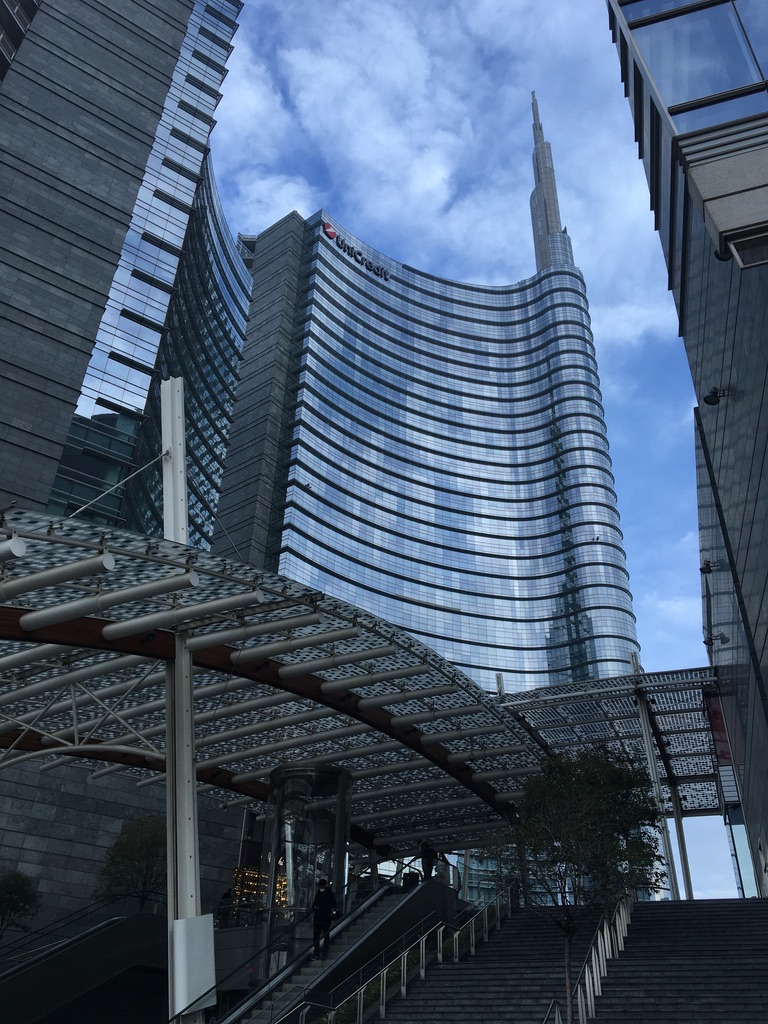 |
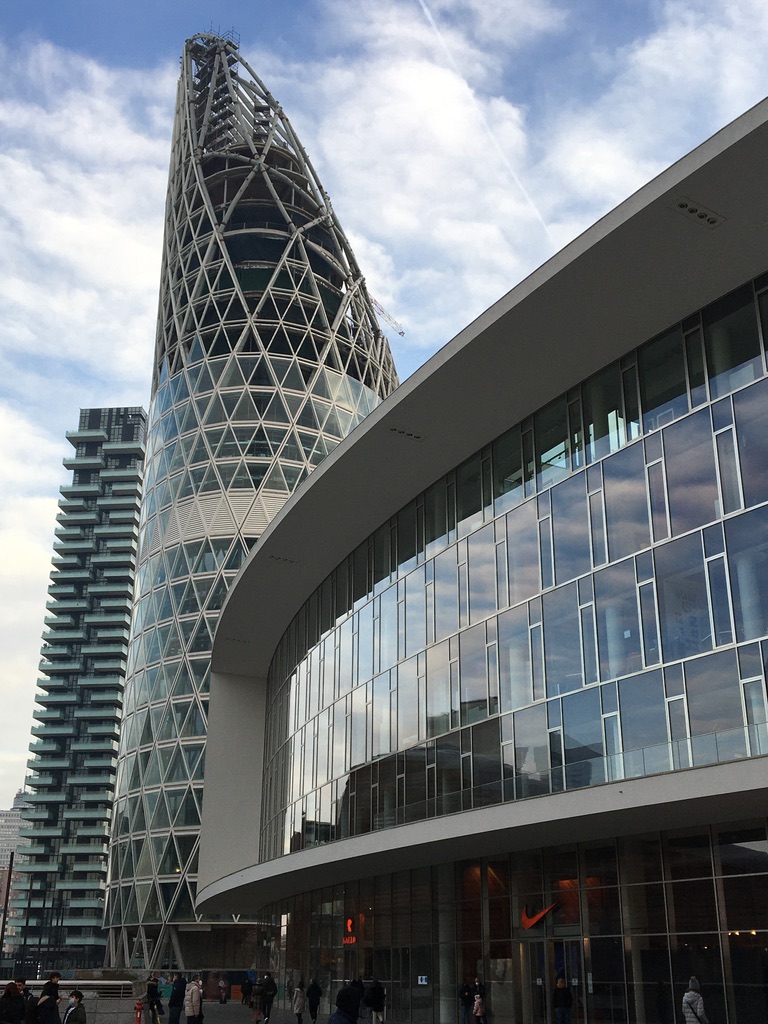 |
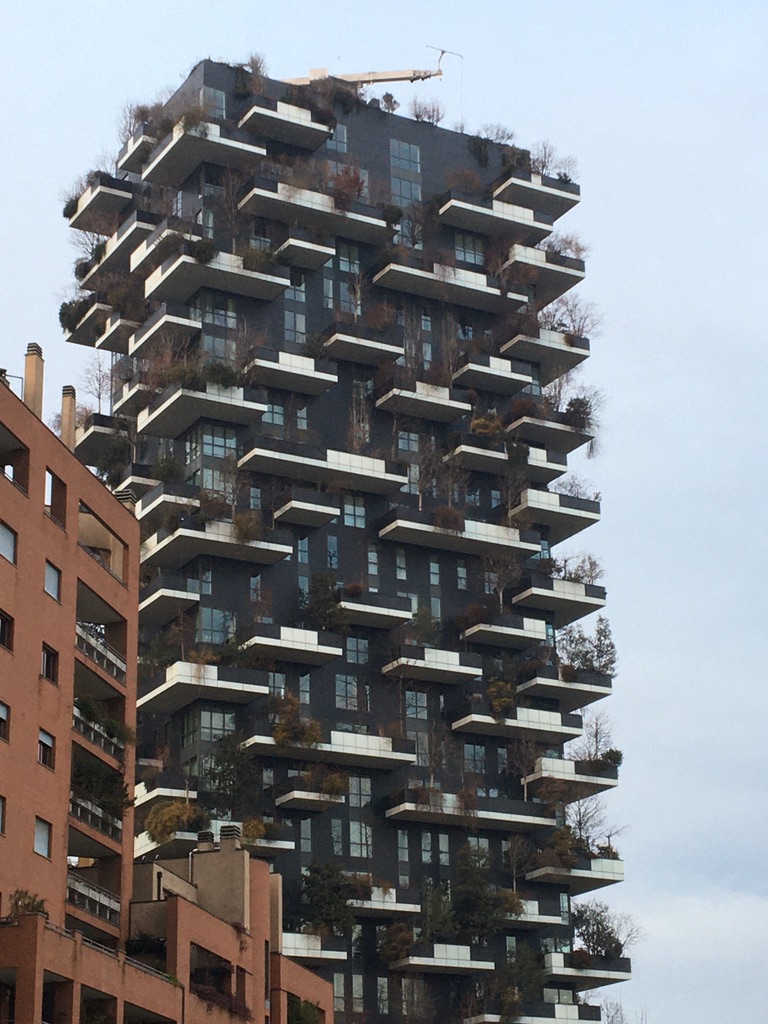 |
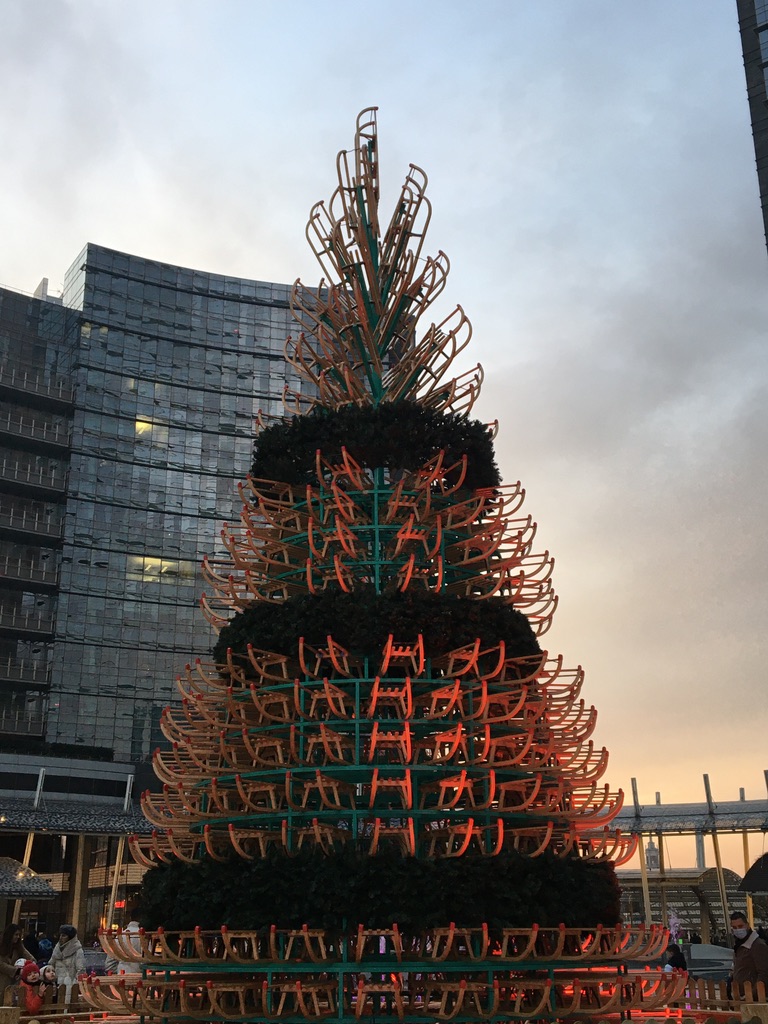 |
- Practical tips
- If you plan to see Last Supper or/and attend the performance in La Scala make a reservation few months in advance (check here and here to make a booking)
- Milan has great public transport (metro/tram/bus) and it’s worth to take the 24/72 hour unlimited pass
- Italy has very good railway system so don’t hesitate to take a train to explore the region
- There are no trains from Malpensa airport to the city center after midnight so make sure you have a plan how to get to the hotel in case of late evening flight
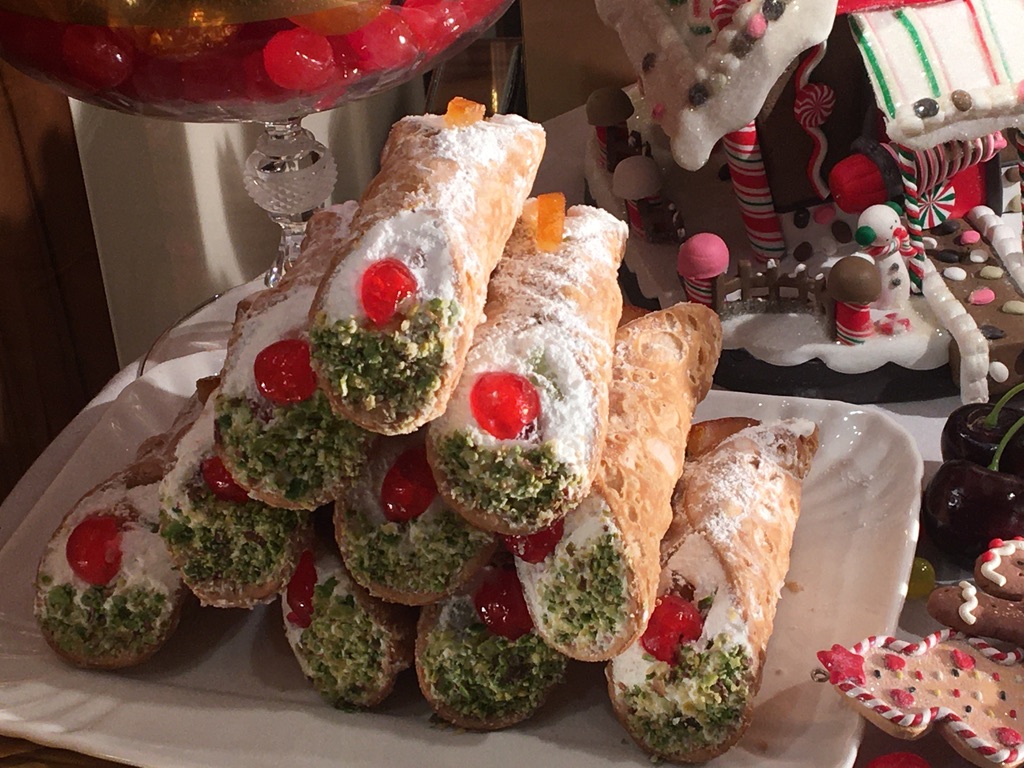 |
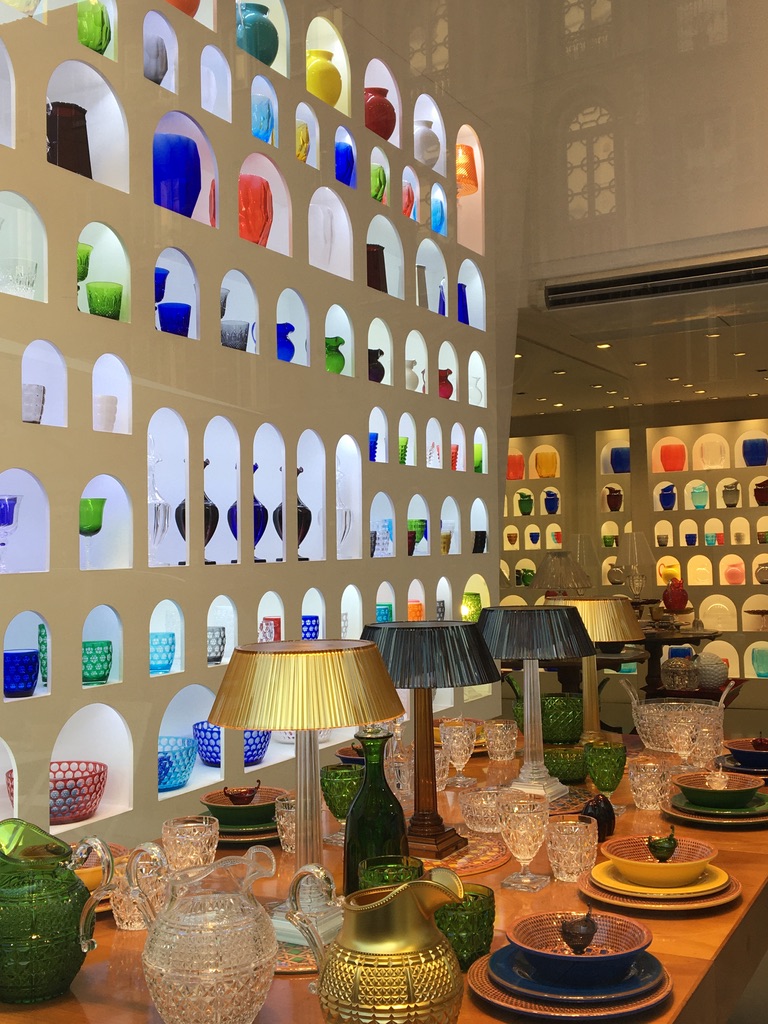
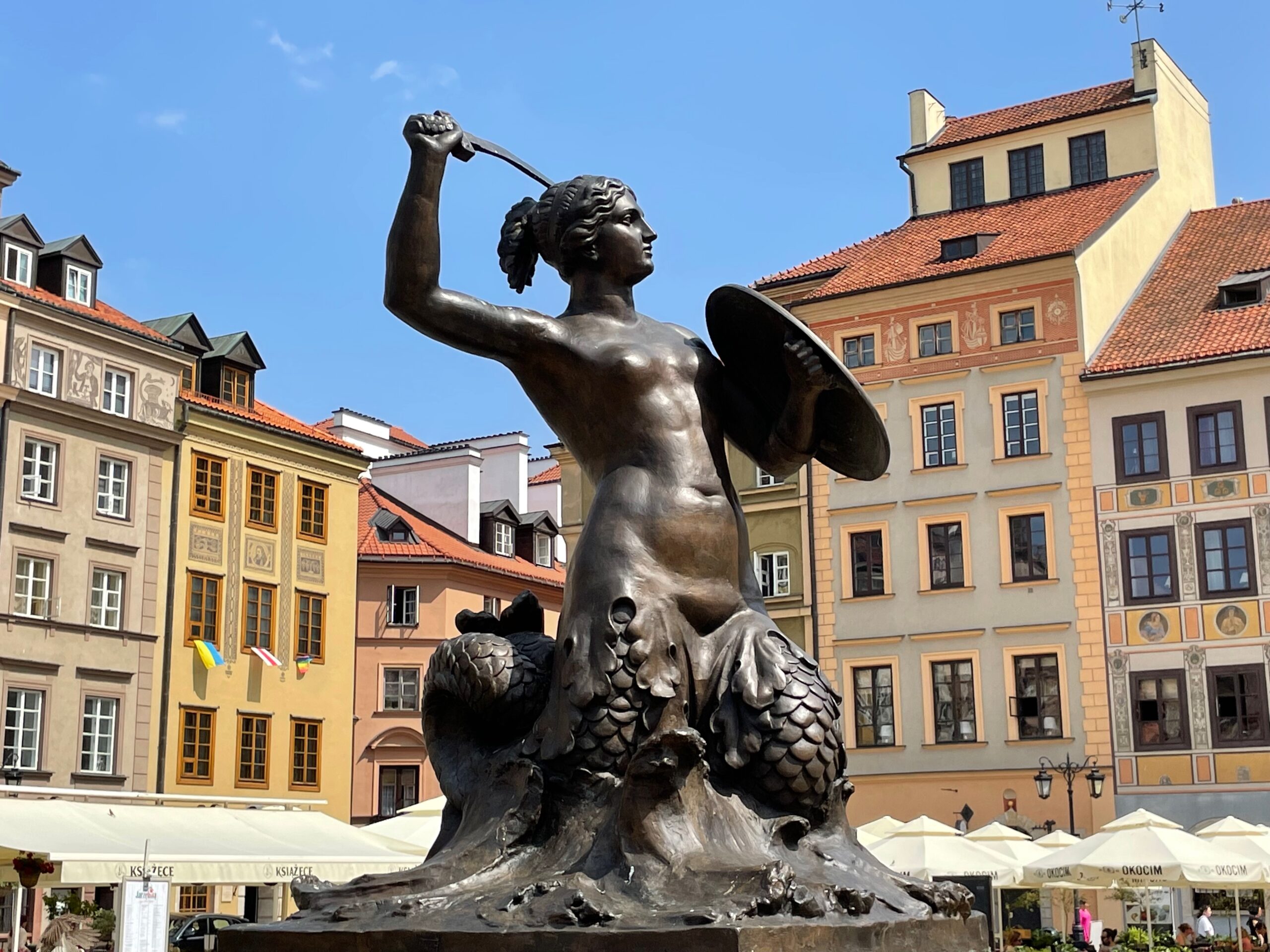
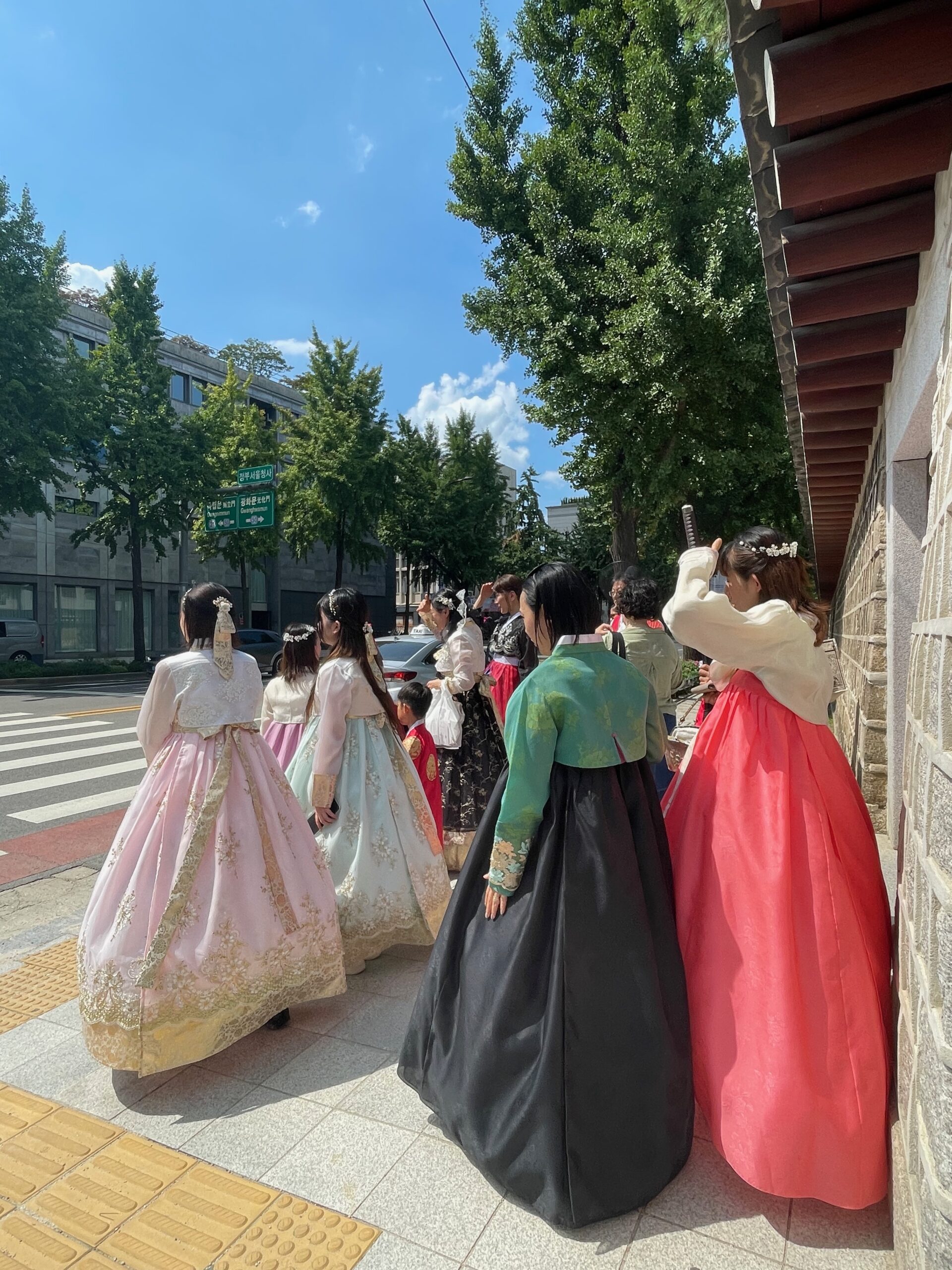
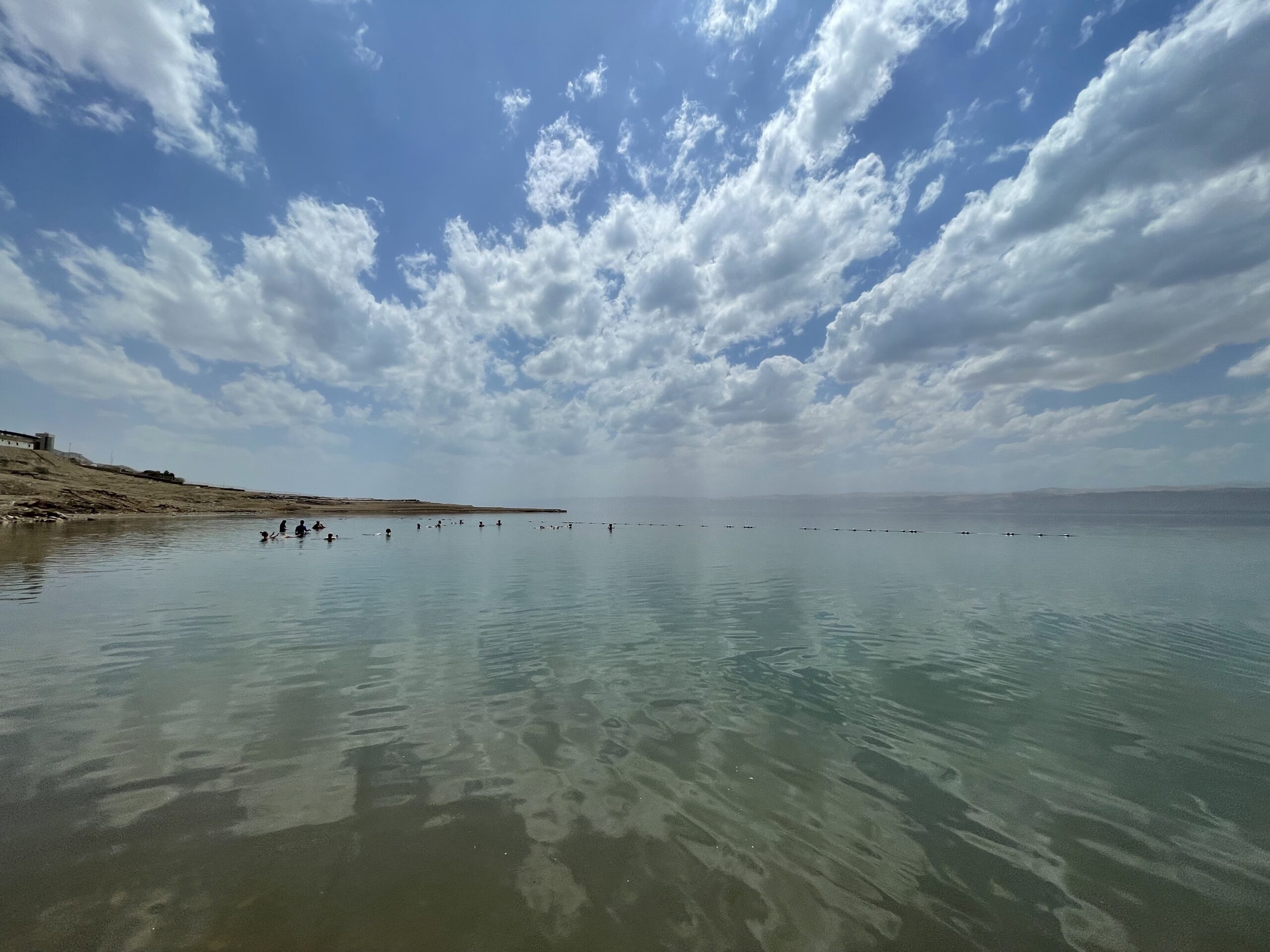
Wonderful post, thank you! We are going to spend the St. Valentine in Milan, do you have any recommendations of a place/restaurant for a romantic evening?
Hi Eric!
If you can still book it, I really recommend going for La Scala’s performance and later some nice romantic dinner. Milan has many great restaurants, but I suggest opting for Italian cuisine, I suggest looking into places serving Sicilian cuisine, it’s exquisite!
Great post! I didn’t know it’s so difficult to book Last Supper. Just checked your link and purchased 3 tickets for my family;) Thanks!
I’ve been postponing my trip to Italy few times already due to pandemic. I found your blog when browsing about Milan and thinking about my future trip 😉 Thanks for so much info, I really hope to see all these great places in the spring 😉
.
Hi Gabriela 😉 Milan looks really great! The dogs are so funny 😀 Do you think just a weekend in Milan is enough? Or is it definitely too short?
Hi!
I think Milan is completely doable in two days. Of course you won’t make a trip to Lake Como (or Venice, Verona, etc.), but for essentials should be OK.
Plan enough of time for Duomo and make sure to book early enough the Last Supper;)
Greets,
Gabriela
Amazing post! Is it better to use Uber or metro in Milan?
Hi Frida,
I find Milan’s metro very comfortable, especially the 24h ticket is convenient. However, metro stops working around midnight and starts around 6 so you may rely on Uber/Taxi that time.
Great pics of Last Supper! My wife wants to see the fresco this Easter, really excited 😃
Great Milan description with so many details. It was definitely informative. I like reading about many places which I will visit in the future when covid pandemic is over. Your website is very helpful. Thanks for sharing!
Milan and its fashion, that’s all I need.
La Scala is a must !
Milena, can’t agree more 😀
Mediolan to moje marzenie 😉
Jak na razie byłam w Rzymie i Wenecji we Włoszech, i chyba zdecyduję się na Mediolan na urodziny.
A program zwiedzania mieliście intensywny, ja to lubię się zasiedzieć tu i tam z kubkiem kawy, pogapić się na miejscowych, takie slow life 😀
Muszka, dzięki za komentarz;)
Oczywiście warto dopasować rytm zwiedzania do własnych preferencji, i cieszyć się pobytem i z niego korzystać tak jak najbardziej lubisz!
Pozdrawiam 😉
Bardzo chcę odwiedzić, ale jak teraz patrzę to jest drogo.
Wszystkie hotele praktycznie zajęte, jakby wszyscy tam teraz ruszyli.
Chyba wybiorę się w te wakacje na Bałkany i poczekam jak Mediolan znowu stanie się dostępny cenowo…
Cześć Iza,
Co do Mediolanu ostatnio, to potwierdzam. Ceny hoteli poszły w górę i wiele miejsc było już zajętych, ale my byliśmy teraz na początku maja.
Może to gorący okres wielkanoc + majówka?
Zobaczymy, czy to się ustatkuje, a Bałkany też są super;)
Pozdrawiam 😉
Really enjoyed this post.Really thank you! Keep writing. Italy is my favourite destination <3
Wspaniałe podróże. Bezcenni są ludzie, którzy je urzeczywistniają. Twój blog jest tego wspaniałym przykladem…Mediolan jest na mojej liście na ten rok!
Really enjoyed this post.Really thank you! Keep writing.
Really enjoyed this post. So helpful for my stay in Milan in October, would love to see Leonardo da Vinci Last Supper ❤️
Zawsze omijaliśmy Mediolan, bo nie interesuje nas moda, a z tym nam się to miasto kojarzyło. Tym razem mamy tam jednak przesiadkę i okazuje się, że jest tam tyle świetnych muzeów i galerii sztuki 😁 Nie wiedziałam też, że tak łatwo można się dostać nad jezioro Como… mam nadzieję, że gdzieś podczas mojej wizyty bedzie przemykał słynny George ❤️
Haha Mirko, życzę Ci takiego spotkania nad jeziorem Como 😁
Milan looks so much fun in the winter! Makes a lot of sense since I would go to swim or to Tuscany in the summer when in Italy so those big northern cities are best to see when it’s cold. Thanks for this inspiring read you’ve been to so many places 😁
I got what you intend,bookmarked, very decent website.
My website: русское часное порно
Respect to post author, some fantastic information about Milan! Love the fact you travel by train!
Do you think it’s a good idea to see Milan for 3 days and then do 3 days in Venice?
Hope you can post about Venice too sometime!
Have you ever considered creating an e-book or guest authoring on other sites? I have a blog based on the same ideas you discuss and would really like to have you share some stories/information. I know my subscribers would value your work. If you are even remotely interested, feel free to shoot me an e mail.
I wish to say that this post is amazing, nice written and include approximately all vital infos. I would like to see more posts like this about European big cities, I like also your Vienna guide!
Is Galleria Vittorio Emanuele good for souvenir shopping?
A lot of blog writers nowadays yet just a few have blog posts worth spending time on reviewing. This Milan guide it’s really honest and detailed, thanks!
Thanks for revealing your schedule and places. I’ll use some of them for my trip, since I’m also big museum and art lover!
I would like to thank you for the efforts you’ve put in writing this website. I like the suggestions of places in Milan, could you write also a bit more about the restaurants worth trying?
Wohh precisely what I was searching for, regards for putting up. I’ve checked the prices for May but is so expensive…